PinotFile: 9.42 May 25, 2014
|
Pinot Noirvana in the Willamette ValleyI just returned from a week in Oregon’s Willamette Valley, visiting many wineries and tasting the Pinot Noirs from the 2011 and 2012 vintage. I timed my visit perfectly as it was sunny and warm all week, a freakish weather event in this region that is usually under a dismal rain cloud almost every day this time of year. The Willamette Valley wine country is truly a retro experience with wineries eager to receive you, offering wines of uncommon excellence by people who are truly friendly, dedicated and unpretentious. I like to say that Willamette Valley Pinot Noirs are genuine wines by genuine people. Beards, plaid flannel shirts and worn denims are de rigueur in the Willamette Valley, the roads to the wineries are often paved with dirt or gravel and surrounded by fields of grain and grass, and sparsely populated with muddy pickup trucks and old tractors. It is quite a contrast in lifestyle to the one in Orange County, California, where I live. Vintners in Oregon are not into Pinot Noir for the money because the production of high-end Pinot Noir is not a particularly financially rewarding proposition. Yields are purposely kept low, grape growing is labor intensive, and with well over 350 wineries, competition is fierce. Yet the Oregon vintners have persevered for fifty years, driven by a passion that only a pinotphile can appreciate.
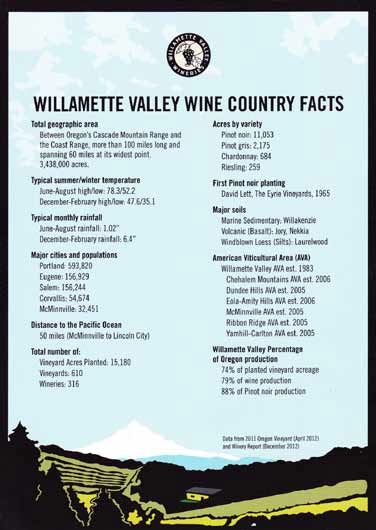 In the Willamette Valley there is really no equal to the glorious Napa Valley chateau winery experience (think Darioush, Castello di Amorosa). Even the most modern and largest wineries such as Domaine Serene, Sokol Blosser and Willamette Valley Vineyards do not seem out of place in the Willamette Valley farmland. Most other wineries are in secluded mountainous sites reachable only by winding, rutted roads that challenge your GPS, and the tasting may be conducted in the owner’s kitchen or back patio. Yet, the owner’s reception is warm and welcoming, and the wines are authentic, offering those who spend the effort to seek them out an exceptional wine drinking experience. Over the past few years, looking to make their wines more accessible, a number of wineries have opened tasting rooms clustered in the towns of Carlton and Newberg. In Carlton, DePonte has opened a contemporary tasting room in the town’s old fire station next door to the excellent Carlton Bakery. Among the other twenty tasting rooms in Carlton, all within walking distance, are Carlton Cellars, Scott Paul, Ken Wright Cellars, Kramer Vineyards, Lachini Vineyards, Noble Pig Vineyard & Winery, Omero Cellars, Scott Paul Wines, Seven of Hearts/Luminous Hills, Siltstone Wines Twelve Wine and WildAire Cellars. Carlton Winemakers Studio is close by. For more tourism information on Carlton, consult www.visitcarlton.com.
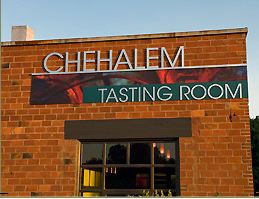 There are eleven tasting rooms within walking distance in downtown Newberg including Anam Cara, Artisanal Wine Cellars, Chehalem, Dark Horse Wine Bar (Medici Vineyards, Sineann Winery), Fire + Flood, Fox Farm Vineyards, and Longplay Wine. For more information on Newberg, visit www.newbergdowntown.org.
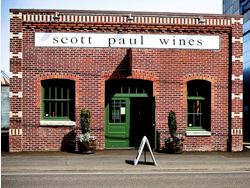 Why visit the Willamette Valley and seek out the local Pinot Noir? The wines are often considered the closest thing to Burgundy in North America, offering low to modest alcohol, juicy fruit flavors, elegance and vivid acidity. This is not surprising because the Willamette Valley is situated at the same longitude as Burgundy and the growing season has many similarities. There is a dedicated commitment in the Willamette Valley to farming for quality and this is shown by the figures below compiled by the Willamette Valley Wineries Assocation.
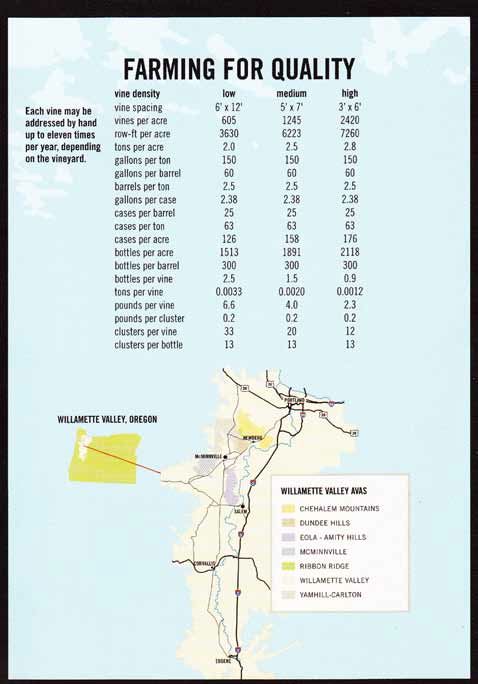
There has been considerable hype about the 2012 vintage Pinot Noirs which are fruit-forward, plush and reminiscent of the 2006 vintage in Oregon. Many have declared the 2012 vintage as one of the greats in Oregon history. Bud break was a week later than normal, but weather was normal during bloom with minimal rainfall towards the end of flowering. Reduced berry set led to lower yields than the 2011 vintage. The growing season was warm and dry resulting in very low disease pressure and ripening was ideal until harvest. The only hitch was a week of warm easterly winds in September that pushed grape sugars up.” Many wines are over 14% alcohol and full-bodied with lush fruit flavors reminiscent of California Pinot Noir. That said, it is a consumer’s vintage and most will embrace the early drinking and hedonistic wines. Many of the 2012 Pinot Noirs are being released during the annual Memorial Weekend in the Wine Country sponsored by the Willamette Valley Wineries Association (www.willamettewines.com). In the following pages of this issue, I will review my week in the Willamette Valley and the many wines I tasted. The consistent high quality of the wines really stood out. No matter whether one prefers the 2011 or 2012 wines, the Pinot Noirs are world class. One thing I have observed about Oregon vintners is that they are a bit shy about tooting their own horn. They have had a long and beneficial association with Burgundy vignerons, and are reticent to claim any superiority of their wines over their French counterparts. The truth is, their best wines rival anything currently produced in Burgundy and the general consistency is something that must make Burgundy green with envy. I believe investing in a premium bottle of Willamette Valley Pinot Noir (say $50- $100) is a safer bet than spending an equivalent amount of money on a red Burgundy. According to Wines & Vines (April 2014), experts at this year’s Oregon Wine Symposium noted that Oregon DtC shipments of Pinot Noir have prospered of late and the latest figures show that Oregon wines account for 3.6% of the domestic wine shipped DtC (54% of which is Pinot Noir) The average bottle price of about $15.40 was higher than California, Washington or imported wines. Interestingly, a survey by Wine Opinions conducted of regular wine drinkers in January 2014, showed that although 44% of Oregon respondents reported buying more Willamette Valley Pinot Noir, the statistics lagged way behind California where 86% of Pinot Noir fans reported drinking California Pinot Noir. If you get the urge to visit Oregon’s Willamette Valley, you will find it is easy to access. A 45-minute drive from Portland’s International Airport will put you right smack in the center of the Willamette Valley and close to hundreds of desirable Pinot Noir producers. The best time to visit to avoid the incessant rain is July, August and September, which are dry months in the Willamette Valley, but other times in the fall and spring are appealing because of the lack of tourists. The Allison Inn & Spa in Newberg is centrally located and offers all the comforts of a world-class hotel in Oregon’s wine country. There are many B&B’s and vacation homes as well, all scattered throughout the Willamette Valley and offering warm hospitality, particularly Le Puy, A Wine Valley Inn, also in Newberg. To plan your trip, visit the Willamette Valley Wineries Association and secure their brochure, “Guide to Willamette Valley Wineries: Drink Pinot Think Oregon.” Other useful websites include Oregon Wine Board at www.oregonwine.org, Travel Oregon at www.traveloregon.com, and the individual AVA websites such as www.chehalemmountains.org, www.dundeehills.org, www.eolaamityhills.com, www.mcminnvilleava.org, and www.yamhillcarlton.org. On Memorial Day and Thanksgiving weekends, all wineries in the Willamette Valley are open to visitors. May is Oregon Wine Month and wineries are hosting special events during the entire month: visit www.willamettewines.com/oregon-wine-month/. You can contact me at prince@princeofpinot.com and I will assist you in arranging private and attentive visits to many wineries in the Willamette Valley. I can also recommend the best lodging and dining options. If you go, remember that the locals pronounce it Willamette, as in dammit! Don't be alarmed, this is not the last article in this issue! I have decided to release each issue of The PinotFile in stages much like a blog rather than publish the issue in its glorious entirety once every 3 weeks. Every 2 to 3 days another article will be posted until the entire issue is completed at which time subscribers will receive notice that the entire issue is posted. Those that subscribe to the Twitter or RSS feed will be notified when each article of an issue is published online, usually every 2 to 3 days. This way, the information can be relayed in a more timely manner and requires only a few minutes to peruse. You may download in pdf format each article or the entire issue when it is completed. Please let me know if you like this new staged format at prince@princeofpinot.com.
International Pinot Noir Celebration: Oregon’s Venerated Pinot BacchanalThe granddaddy of Pinot Noir festivals continues to attract pinotphiles from around the world to the tiny, bucolic campus of Linfield College in McMinnville, Oregon, for continuing education in Pinot Noir. There is no homework or written tests, and no dreadful lectures at 8:00 A.M. in the morning. Just an abundance of great Pinot Noir paired with the delicious bounty of Oregon, accompanied by plenty of joie de vivre among the luminaries of food and wine who join the celebration. The first International Pinot Noir Celebration (IPNC) was held in 1987 when a group of Oregon vintners gathered to figure out a way to promote Oregon wine. Since then, the IPNC has brought together 14,000 Pinot Noir lovers, fueled by an unabated love for their go-go juice. The IPNC has hosted over 200 winemakers from France, and many from New Zealand, Australia, Italy, Germany, Switzerland, Austria, Canada and South Africa, along with hundreds of Oregon and California winemakers. The emphasis is always on quality (wineries are accepted to participate based on merit) and stylistic diversity, with many new winery faces appearing each year. This year there are 74 international Pinot Noir winemakers. Wineries from Oregon include Archery Summit, Bergström Wines, Chehalem, Domaine Serene, The Eyrie Vineyards, Scott Paul Wines, Stoller Family Estate, and Westrey Wine Co. Participating California wineries include The Donum Estates, Drew Family Cellars, J Vineyards & Winery, Navarro Vineyards, Patz & Hall, Rhys Vineyards, and Siduri Wines. Among the most well known featured international wineries are Mission Hill Family Estate (British Columbia, Canada), Domaine Ambroise (Prémeaux-Prissey, France), Maison Joseph Drouhin (Beaune, France), Bodega Chacra (Rio Negro, Argentina), Villa Maria Estate (Marlborough, New Zealand), and Wooing Tree Vineyard (Central Otago, New Zealand). There is no judging of wines at the IPNC for the festival is a pure celebration of Pinot Noir, offering the Pinot Noir enthusiast the opportunity to discover new producers and rub shoulders with established winemakers of repute that they may have only read about. David Lynch, a James Beard Award winner in journalism and contributing wine editor and author of The Wine Insider’s Guide for Bon Appétit, will keynote the 28th IPNC held this year on July 25-27. He is a hilarious writer and speaker and also a noted San Francisco restauranteur who launched Quince and now owns St. Vincent.
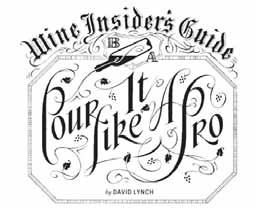 Noted British wine book author and blogger Jamie Goode will moderate the Grand Seminar titled “Doors of Perception.” Not only at the IPNC, but also all over the world, a revolution is underway. Wine drinkers are becoming savvy about their own tastes, and individual preferences now rule our selection of wines. Professor Hildegarde Heymann of University of California at Davis recently reported a study from the Department of Viticulture & Enology involving wine sensory character, quality perception and preferences by consumers, wine-judging panels and wine experts. The results suggested that consumers are better off trusting their own preferences to choose wines they like rather than depending on the advice of so-called experts. The seminar panel is composed of those who think about wine but are not critics and offer a different perspective on the perception of wine. Each panelist will chose a Pinot Noir that speaks to them and include it in the discussion. Seminar guests will arrive at a deeper understanding of how they view wines, how that perception is a reflection of them, and why that matters. Seminar panelists include Harvard historian of science Steven Shapen will provide a cultural perspective of wine. Wilderness perfumer Hall Newbegin will offer a fresh take on aromas of place. Elaine Brown’s wine cartoons will show how a wine can be brought to life through her imaginative drawings. Stephen Tanzer’s International Wine Cellar critic Josh Raynolds will help guest become fluent in the language of wine. Chef Frank Stitt, who writes the wine lists for his trio of Birmingham, Alabama restaurants will introduce food into the picture. Professor Jordi Ballester from the Université de Bourgogne will bring his unique views on sensory evaluation and Loire-born New York sommelier Pascaline Lepeltier of Rouge Tomate will discuss wine and food pairings. Of course, winemakers will be on hand to add their voices to the conversation. The afternoon educational classes, termed “University of Pinot,” will feature a wide range of options this year. The courses include Sensory Science 200: The Physiology of Taste with Josh Raynolds; Chemistry 201: Dropping Acid with Elaine Brown ( how adding acid to wine affects balance); Climatology 312: The Future of Cool Climate Viticulture with Vajra Stratigos and Greg Brown; Field Study 301: Distilling Terroir with Hall Newbegin; Geography 300: Loire Valley Pinot with Pascaline Lepeltier; Regional Studies 225: The New California Wine with Jon Bonné; Pairing Tea and Cheese with Steven Smith; and Matchmaking 220: Smoke and Mirrors, a food and wine pairing seminar with Ben Dyer and Jordan McKay. Praised as a showcase for the Northwest’s famed farm-to-table cuisine, the IPNC will host 50 chefs from the northwest’s most revered restaurants. On Friday evening, the IPNC will celebrate the wealth of female talent in the culinary world at the Grand Dames Dinner. Featured chefs are Stephanie Pearl Kimmel of Marche, Kristen D. Murray of Maurice, Holly Smith of Cafe Juanita, and Cathy Whims of Nostrana.
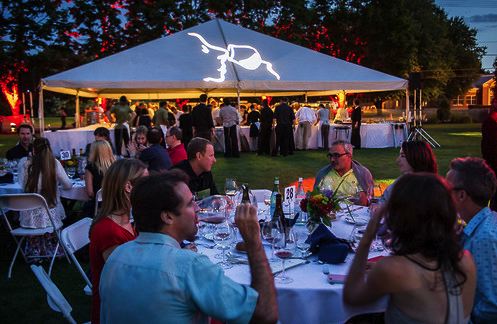 The Saturday night Northwest Salmon Bake is a long-standing tradition at IPNC and has been called “the most entertaining meal at any wine event in the world.” Held in a lantern-lit oak grove on the Linfield College campus, wild Chinook salmon is cooked native northwest style on wood stakes over a wood-fired pit. Featured chefs are Ben Dyer, David Kreifels and Jason Owens of Reverend’s BBQ, Tommy Habetz and Nick Wood of Bunk, and Jason Stoller Smith from Timberline Lodge. Four incredible dessert chefs will top off the evening: Elizabeth Beekley of Two Tarts, David Briggs of Xocolati de David, Jami Curl of Quin, and Jamie Lewis of Blue Raeven Bakery. This dinner is also a no-holds-barred opportunity for pinotphiles to bring their best stuff to share, and as you wonder among the tables, you can taste an incredible array of wines simply by asking.

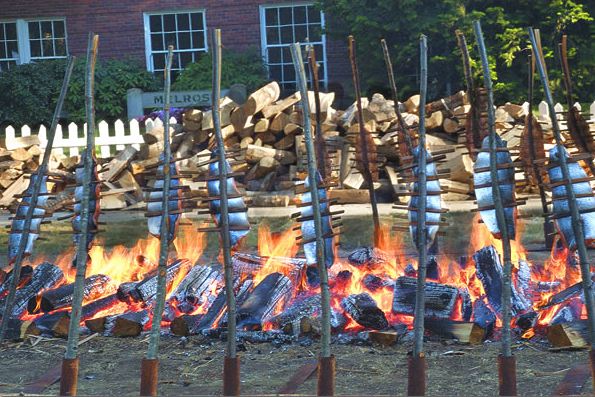 Noted sommeliers travel from all over the country to pour wine at the elaborate meals. They are formally attired until the last morning of the event when they typically dress up in conjunction with a theme and frolic.
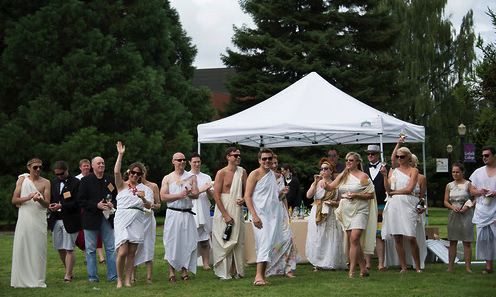 I am getting excited just thinking about this year’s IPNC. I have been attending the celebration almost every year for 20 years, and I can honestly tell you this is the most memorable wine festival I attend. Along with the noted speakers and marvelous chefs, the celebration has a relaxing and festive atmosphere that sets it apart from all over wine events. Whether tasting Grand Cru Burgundy or strolling through Willamette Valley vineyards with the grower who planted them, I find myself happily unwinding in picturesque Oregon wine country.
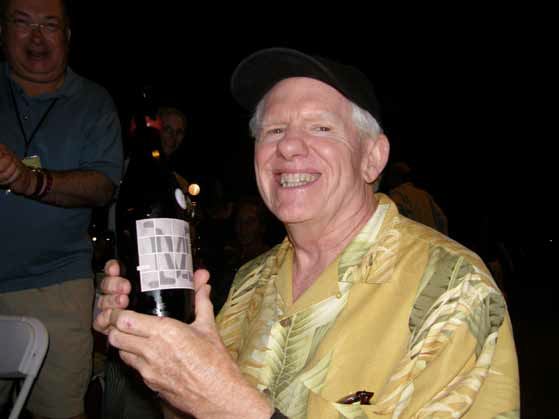 When Lewis and Clark arrived at the mouth of the Columbia River that divides Oregon and Washington states, the foul weather led their group to call this region Point Dismal. I am sure they would be startled today to see the expansive vineyards that now dot the Oregon landscape and to taste the magnificent Pinot Noirs that are now an Oregon trademark. During July, Oregonians put aside the memories of dismal winter rain to revel in the sun that shines on McMinnville, the IPNC, and the wonderful gift of Pinot Noir. Tickets for the full weekend event include exclusive access to all seminars, tastings (the 2011 vintage will be poured at the afternoon outdoor walk-around tasting on Friday and the 2012 vintage will be poured by participating wineries on Saturday), tours and activities, as well as all meals over two days and the Sunday Sparkling Brunch Finale. Weekend tickets are $975 per person. Two additional “Post Grad” seminar options will be offered to weekend guests for a separate fee: Raiding the IPNC Cellar with Jamie Goode and Master Class on the Aroma of Color (perceiving color through aroma). Tickets are sold on a first-come, first-served basis and a limited number of tickets remain. For full details, contact the IPNC at 800-775-IPNC (4762) or visit www.ipnc.org. The IPNC is easily accessible from Portland’s International Airport by a leisurely 45-minute drive. Accommodations in the Willamette Valley are somewhat limited so it is important to make plans to attend now. I would be happy to assist you in any way by contacting me at prince@princeofpinot.com. An additional event, Passport to Pinot, is held on Sunday afternoon July 27, and is a condensed version of the IPNC. All 74 wineries will pour, 15 local northwest chefs will prepare culinary treats and IPNC will be pouring a selection of aged Pinot Noir from their library. This is also a popular event, held in the beautiful Oak Grove of Linfield College. The Passport to Pinot is a separate event and not included in the full weekend festivities. A separate crowd, mainly Oregonian Pinot Noir fans, attend, but it is open to anyone.
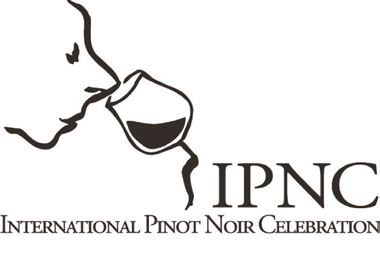
White Rose Estate: Pursuing a Neo-Classical ObjectiveThe owner and producer at White Rose Estate, Greg Sanders, acquired the 10-acre White Rose Vineyard in the Dundee Hills in the summer of 2000. A few years prior, having found satisfaction as the owner of a moderately large manufacturing company in Los Angeles, Greg began to look for something that offered an emotional connection and found it in wine. Since he was not one to do things a little bit as he put it, he began an exhaustive exploration of Pinot Noir wines, beginning with ones from California, then Burgundy and Oregon. He tasted all the well-known labels and studied the wines in depth to learn what made them special and what allowed them to age. Eventually he arrived at an “aha!” moment and decided the key was an old vine vineyard.
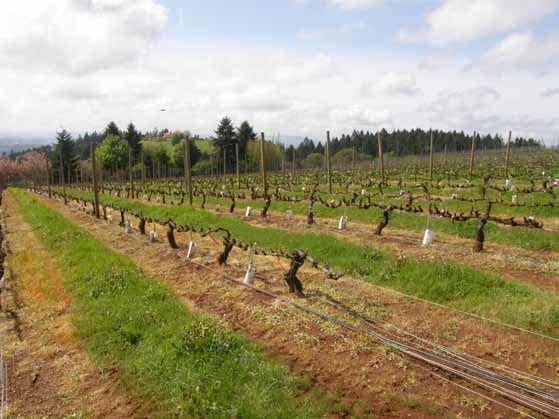 White Rose Vineyard was planted to Pommard clone on its own roots between 1978 and 1982. (There are some new interplantings evident in the photo above) The east-southeast facing vineyard planted in volcanic Jory soils is well-placed with several prominent producers nearby including Archery Summit, Domaine Serene, and Domaine Drouhin Oregon. The vineyard sits at 870 feet elevation. The location is ideal, allowing an extended growing season that lends itself to harvest in late October. This allows for slow phenolic development, balanced sugars and acids, and mature stems. Greg has called his vineyard, “One of the ten best vineyards in the New World.” An adjacent 4 acres were acquired in 2009, planted to Dijon clone 115 grafted to American rootstock, and named the Guillen Vineyard after Jesus Guillen who has managed the White Rose Vineyard since 2002 and his son, also named Jesus Guillen, who is Greg’s winemaker. Greg also sources fruit from a number of Willamette Valley’s top growers in the Yamhill-Carlton District, Dundee Hills, and Chehalem Mountains appellations. Greg is largely a self-taught winemaker (he prefers the term “producer”) who made his first wine in 1999 and his first commercial White Rose Vineyard Pinot Noir in 2001. His winemaking production has evolved slowly over the past 13 years tied to the emotional connection he has with wine. Since 2011, he has embarked on a program that he terms “The Neo-Classical Objective.” It is a highly innovative approach for the Willamette Valley and somewhat polarizing in its theory. Greg does not consider it revolutionary since it is soundly based in Old World winemaking techniques. My following words paraphrase Greg’s philosophy. There are two parts to The Neo-Classical Objective: the “why” and the “how.” The “how” is the more simple part, the “why” more difficult to elucidate but is the impetus, so let me start with that first. Simply put, neoclassical refers to an alternate presentation of wine that elevates “pinotnoirness” above everything else. The word classic refers to the many presentations of pinotnoirness over multiple generations. The first requirement to achieve the neo-classical objective is to have an old vine vineyard. Vines must be old enough to make an age worthy wine. There must have enough phenolic and tannin components to outlast the process of oxidation over time. Tannins cannot be overriding initially as the wine will be austere initially, requiring years to oxidize, often reaching an acceptable level at the time the phenolics (fruit flavors) have dissipated. The vineyard must be in the correct location, produce quality fruit and be subject to the proper temperature such that the resultant wine can achieve a sense of pinotnoirness. In the classic sense, the grapes should reach a state of crispness and freshness, preferably with raspberry and blackberry flavors. Greg gives the following analogy. If you randomly pick nine cherries and put them in the palm of your hand, three will be dark and concentrated (very ripe), three will be crisp and fresh, and three will be lean and tart. The most desirable cherries for a classic driven Pinot Noir are the crisp and fresh ones. Thus, the timing of the picking decision is critical. The “neo” term in “neo-classical” incorporates the “how” in The Neo-Classical Objective. Greg’s current approach to handling fruit, skin and seed tannins both in the vineyard and in the winery. Too little tannin and the wine will not last, and too much tannin leads to an edgy wine initially that takes years to resolve the tannins. In past generations, the tannins in wines could be overwhelming initially, something Greg avoids completely. The ultimate objective is to have a wine that is good from day one and that will undergo metamorphosis over time, not becoming necessarily better, but different. Ideally, Greg wants much of the skin tannins to oxidize away on the vine at the same time as the grape phenolics reach ideal ripeness (tannins are antioxidants, so as they diminish, the available oxygen that results can ripen the phenolics). Invariably, some tannin remains at harvest, but he picks at a time he can manage the astringency. In the cellar, punch downs are avoided to prevent rupture of berries and the release of harsh, bitter seed tannins into solution (gentle punch overs are employed instead). Post-fermentation, the must is pressed off using a laborious old world basket press. In addition, post-fermentation maceration is minimized, again to avoid extracting too much additional tannin. Seed tannins take forever to oxidize and by then the fruit in the wine is gone. The must is gently pressed off using a manual old world basket press that avoids breakage of seeds and stems. The wines are barreled down in French oak for about 15 months, racked once after malolactic fermentation, and then again just before blending. The wines are bottled unfined and unfiltered.
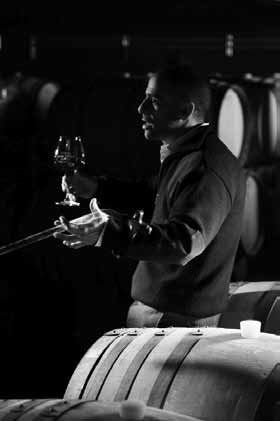 Greg’s Pinot Noirs produced from old vines in the neo-classical objective mode, are fermented 100% whole cluster. He is not the least bit worried about the stems, only the flavor, phenolic intensity and tannins. In some years, tannin management is not ideal, and some mild herbaceous character may creep in, which may not appeal to all Pinot Noir drinkers. Still, Greg is undaunted, for the nuances, texture and haunting aromas and flavors, and age ability associated with whole cluster fermentation are too advantageous to him. In summary, to achieve the neo-classical objective of pinotnoirness and present the varietal in a manner such that it has the greatest potential to generate an emotional connection to the wine:
1) Farm an old vine Pinot Noir vineyard planted to quality clones or selections appropriate for the site.
Greg has expended considerable effort in improving the grounds of his property, the tasting room, and the winery so it will connect with people’s emotions and the “White Rose experience.” The tasting room is unique in that it has no windows do distract the visitor from the wines. In the cellar, elaborate mood lighting creates a striking atmosphere, and all the barrels are uniformly sanded for an engaging appearance.
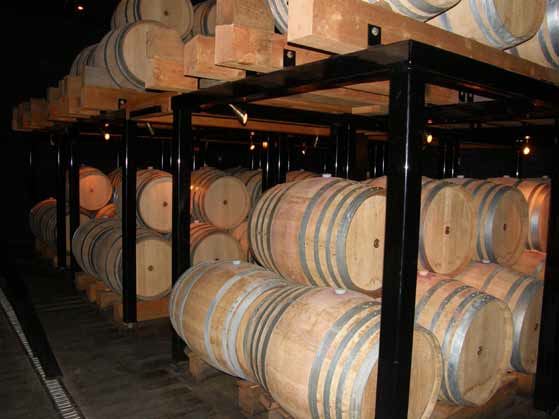 When I recently visited, Greg was at home in Orange County, California (he spends considerable time in Oregon at his winery as well). I was hosted by assistant winemaker Jesus Guillen (right) and manager Gavin Joll shown in front of the winery’s tasting room entrance. The winery and cellar is located underneath the tasting room. We tasted through some of the 2011 and 2012 vintage White Rose Estate Pinot Noirs and I came away with profound respect for Greg’s accomplishments. I found the wines displayed haunting floral and exotic spice aromas and flavors associated with 100% whole cluster ferments, with no herbaceous character evident in any of the wines. For me, and many other wine enthusiasts, whole cluster aromatics are like “catnip for humans.” The wines also had structure yet elegance, and modest, well-integrated tannins. All the wines could be enjoyed now. I would encourage readers to experience these wines for their unique qualities. A number of Oregon wineries are experimenting with some whole cluster inclusion in the manner of 10% to 30%, with an occasional 100% whole cluster bottling. Other than Cristom Vineyards and Thomas Geerie Wines, there is no other Oregon winery that I know of other than White Rose Estate that is fully committed to whole cluster vinification.
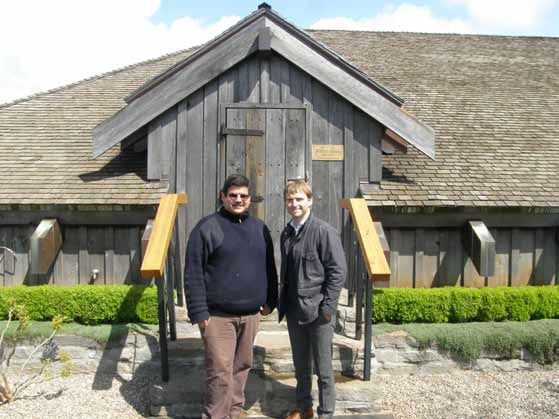 Greg’s comments on the 2012 vintage indicated excitement. Greg does not recall a vintage that has shown as much potential. “The 2012 vintage was reminiscent of 2002 and 2008. It was warmer than average and certainly warmer than the cooler vintages of 2007, 2010 and 2011, but cooler than the really warm vintages of 2003, 2006 and 2009. While the wines are dense and rich on the palate, they are extremely well balanced with sufficient acidity. Unlike the warmest vintages where the fruit takes on an over ripe, stewed character, the wines from 2012 consistently retain a fresh, vibrant sense of fruit. Retaining this freshness is critically important to our winemaking goals at White Rose. It certainly appears that 2012 will live up to the hype.” Located at 6250 NE Hilltop Lane in Dayton, the tasting room is open daily from 11 to 5 P.M.. Tours are available by appointment. The wines are sold through a mailing list and on the website: www.whiteroseestate.com. The Explorer’s Club offers unique bottlings. In 2012, wines were offered from different elevations. In 2013, different clonal bottlings from the same vineyard will be offered. The Neo- Classical Club includes wines that are collectable and age worthy.
2011 White Rose Estate “The Neo-Classical Objective” Willamette Valley Pinot Noir 13.0% alc., 416 cases, $80. Sourced from White Rose Vineyard (35%), Vista Hills Vineyard (31%), (Dundee Hills AVA, planted in 1999-2001 with clones 115 and 777), and Murto Vineyard (34%, Dundee Hills AVA, planted 1988-2005, Pommard, 2A and 115). 100% whole cluster fermentation. Skin contact 23-25 days. Basked pressed with wooden ratchet press. Aged 16 months in 9% new French oak. · Moderately light reddish purple color in the glass. Highly perfumed with enticing aromas of cherry, wilted rose, exotic spices and the faintest oak. Bright and juicy with light to mid weight flavors of well-spiced black cherry backed by modestly astringent tannins and lively acidity. Very likable with a slight earthy bent to the flavors. Score: 91-92
2011 White Rose Estate White Rose Vineyard Willamette Valley Pinot Noir 13.0% alc., 442 cases, $95. Latest harvest ever, November 4-5. Made from selected mature vines. 5-day average cold soak. Fermented 100% whole cluster. Total skin contact 25 days. Aged 16 months in 13% new French oak barrels. · Moderately light reddish purple color in the glass. Distinctive whole cluster aroma featuring an array of exotic spices, a floral display, and a compliment of sweet oak. Light to mid weight flavors of black cherry and raspberry with plenty of spice and a kiss of oak. The finish is noticeably juicy and persistent. Overall, the impression is one of harmony and enthralling brightness. Score: 93-94
2012 White Rose Estate Willamette Valley Pinot Noir 13.2% alc., pH 3.63, 1,094 cases, $40. Released May 2014. Harvest October 11-27. A blend of 9 vineyards. Pommard and Dijon 777, 115, 114 and 667. 73% whole cluster on average. Aged 11 months in 11% new French oak. · Moderately dark reddish purple color in the glass. Subdued, but pleasant, with dark fruit, baking spice and oak aromas. Middleweight, juicy flavors of plum, black cherry and blackberry wrapped in modest tannins, finishing dry and with a succulent charge of fruit. Score: 88-89
2012 White Rose Estate Guillén Vineyard Willamette Valley Pinot Noir 13.8% alc., pH 3.70, 188 cases, $70. Fall release. Harvest Oct 17 and 24 with 1.5 tons per acre yield. 9-day cold soak, 21-22 day skin contact, 100% whole cluster fermentation, aged 16 months in 19% new French oak. · Moderate reddish purple hue in the glass. Haunting aromas of black raspberry jam, dark rose petals, tea, incense and baking spices. Admirable balance with a discreetly concentrated core of black raspberry and black cherry fruits accented with spice. A bit reserved at this stage, but showing considerable potential. The strong finish has commendable length. Score: 92-93
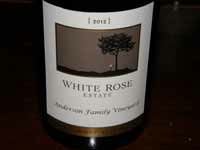 2012 White Rose Estate Anderson Family Vineyard Willamette Valley Pinot Noir 13.0% alc., pH 3.71, 118 cases, $90. Released. Harvest October 11, yield 1.7 tons per acre. Self-rooted Dijon 115. 100% whole cluster fermentation. 9-day cold soak, 26 days total skin contact, aged 16 months in 10% new French oak. · Moderate reddish purple color in the glass. Voluptuous, persistent aromatic pleasures including black cherry, spice and wilted rose. Boldly concentrated plum and black raspberry flavors are vibrant on the attack, showing numbing intensity as well on the huge finish. The tannins are supportive but not intrusive. Despite its sappy load, the wine has an elegant, polished mouth feel. Score: 94-95
2012 White Rose Winemaker’s Cuvée Willamette Valley Pinot Noir 13.6% alc., pH 3.62, 257 cases, $90. Released. A special cuvée from winemaker Jesus Guillen who choses his favorite barrels in the cellar. A blend of White Rose, Guillen, Vista Hills, Luciole and Red Hills vineyards. Vineyards planted 1978-2006 primarily in Jory soils. Harvest Oct 11-26. 93% whole cluster fermentation on average. 6-9-days cold soak. 20-26 days skin contact. Aged 16 months in 9% new French oak. · Moderate reddish purple hue in the glass. Fabulous nose perfumed with aromas of black cherry, black raspberry, dark rose, exotic spices and peppery herbs. A terrific, well-structured wine in a masculine style (jesus prefers this) with layers of flavors including Bing cherry, black raspberry pie filling, sassafras and cola. The fine-grain tannins are nicely integrated and the finish is generous and satisfying. Score: 93-94
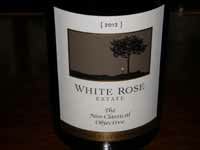 2012 White Rose Estate “The Neo-Classical Objective” Willamette Valley Pinot Noir 13.6% alc., 428 cases, $80. Fall release. After meticulously tasting barrel samples blind before bottling, only vineyards that meet the neo-classical objective for a given vintage are selected for this blend. White Rose Vineyard (11%), Vista Hills Vineyard (11%), Anderson Family Vineyard (17%), Guillen Vineyard (28%), Lia’s Vineyard (22%), and Luciole Vineyard (11%). Pommard, Wädenswil, 777 and 115. Harvest Oct 11-26. 100% whole cluster fermentation. Total skin contact 16-26 days. Aged 16 months in 14% new French oak. · Medium reddish purple hue in the glass. The nose is shy initially, opening slowly to reveal scents of fresh dark berries, spice and cut flowers. Much more elegantly styled with a satisfying core of black raspberry, plum and black cherry flavors expansive on the palate and generating a lengthy, spice-laden finish highlighted by sweet oak and suave tannins. Score: 93-94
 2012 White Rose Estate White Rose Vineyard Willamette Valley Pinot Noir 12.9% alc., pH 3.77, 235 cases, $125. Fall release. Harvest Oct 26-27. Yields only 0.5 tons per acre due to poor set. Self-rooted Pommard. 100% whole cluster fermentation. 6-day cold soak, total skin contact 20-21 days, aged 16 months in 10% new French oak. · Moderately light reddish purple color in the glass. Well-perfumed with hitone aromas of cherry, raspberry, baking spices and sandalwood. Gorgeous fruit core replete with striking flavors of fresh red and black raspberries and exotic spices. Structured for the long haul with an amazingly long, peacock tail finish. This wine typifies the neo-classical objective of juiciness and freshness with enough tannic backbone to age and a minimum of oak intrusion to allow the fruit to clearly speak. Score: 95-96
The Potter’s VineyardLaura Volkman originally planted this 3.2-acre vineyard in 2001 in Newberg, Oregon, and released her first wines in 2004. Laura quickly developed a loyal following over the years for her wines, but an unfortunate illness forced her to sell her property just before harvest in 2012. The new owners, Sandy and Bill Sanchez, are proud to carry on her legacy of producing premium Estate Pinot Noir. The new owners initially learned about the vineyard and wines Laura created by working with Laura during the 2012 vintage harvest and winemaking process. They changed the label to “The Potter’s Vineyard” because the vineyard property is also home to a pottery studio where Sandy and Bill craft hand made clay art. The new label invokes the memory of the Laura Volkman label. The tasting room also features a Clay Art Gallery, featuring the work of local artists including Patrick Noe, who created the ‘Vineyard Worker’ image on the new wine label. Sandy is a learning specialist assistant at a local elementary school and Bill is a Ph.D. scientist with Diamond V, a yeast culture manufacturing company. The couple are new to wine growing and winemaking but very humble about their opportunity. The Potter’s Vineyard is located in the Chehalem Mountains AVA, and is planted to Dijon 777, 114, 115 and 667, and Pommard clones of Pinot Noir in Jory and Laurelwood soils. The first Potter’s Vineyard Pinot Noirs were released in May 2014, and are reviewed here. Tasting is available by appointment and the traditional Willamette Valley weekend open houses Thanksgiving and Memorial Day weekends. The website is www.pottersvineyard.com.
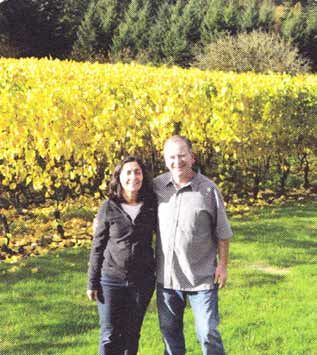
2012 The Potter’s Vineyard Dario Estate Chehalem Mountains Pinot Noir 14.2% alc., 220 cases, $28. Replaces Laura Volkman’s St. James Estate. Named after Portland icon Dario Casciato. A blend of both Jacob and Rachel blocks of the vineyard. 100% de-stemmed. Aged 10 months in 25% new French oak and 8 months in bottle. Unfined and unfiltered. · Moderate reddish purple color in the glass. Shy aromas of black cherry with an echo of oak. Juicy mid weight black cherry core with a modest oak sheen. The tannins are balanced and there is some finishing intensity. A fairly simple but enjoyable wine that is much more aromatic and flavorful the following day from a previously opened and re-corked bottle. Decant if you must drink now. Score: 89
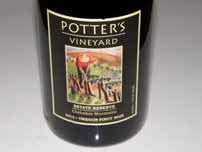 2012 The Potter’s Vineyard Estate Reserve Chehalem Mountains Pinot Noir 14.2% alc., 25 cases, $55. Replaces the Jacob and Rachel bottlings of Laura Volkman. Primarily Pommard clone. 100% de-stemmed. Aged on lees 10 months in 100% new French oak, bottle aged for 8 months. Unfined and unfiltered. · Moderate reddish purple hue in the glass. Nicely perfumed with deep, penetrating aromas of black cherry, black raspberry, rose petal, anise and spice. Full-bodied, yet charming, with a rich core of darker stone and berry fruits, cola and spice. Very Pommard in character. The fruit is wrapped in fine-grain, supportive tannins, the texture is soft and seamless, and the finish has some pleasing sap. Pleasurable now, but will benefit from another 6-12 months in bottle. Score: 91
Ghost Hill CellarsThe legend of Ghost Hill dates to the early 1860s when Oregon was consumed by a gold rush. An old military trail that stretched from southern Oregon to Portland ran through what is now the Bayliss family farm. A miner was traveling the trail to Portland with a stash of gold and camped one night at what is now known as Ghost Hill. During the night, thieves killed the miner and stole his gold. The legend says that the miner’s ghost still wanders the hill looking for his stolen gold. The Ghost Hill Cellars Bayliss-Bower Vineyard is part of the family’s 234-acre property on Savannah Ridge in the Yamhill-Carlton AVA. The Bayliss family have been stewards of the land for more than a century. Initially, the farm was a dairy operation. When Samuel D. and Barbara Bayliss bought the farm in the 1930s from Samuel's father who came to the land in 1906 with his brother, they raised wheat, hay, clover, peas, sheep, and later beef cattle. Today, the vineyard is the only farm crop. Mike and Drenda Bayliss own the farm. Their children, Mike Bayliss, Jr., and daughter Bernadette Bower along with her husband Cameron Bower own the Ghost Hill Cellars brand and vineyard together. The initial planting was in 1999, and today 15 acres of Pommard, Wädenswil, and Dijon 777, 114, and 115 are farmed. The vineyard has been managed by Buddy Beck of Advanced Vineyard Systems, Inc., since the beginning and is LIVE and Salmon-Safe certified. Some fruit is sold to other wineries including Lange and Elk Cove. The Ghost Hill Cellars wines, first released from the 2006 vintage, are 100% estate grown. The winemaker is Rebecca Pittock-Shouldis who had her first exposure to wine as an exchange student with a family living near Bordeaux, France. The host father was a wine collector and Rebecca was able to drink many older vintages of French wine, quickly falling in love with “tasting history.” She did not pursue a career in wine initially, instead she became a maintenance technician on F-15 fighter aircraft for the Oregon Air National Guard. In 2005, she left that job (although she remained a member of the Air National Guard) to enter the wine business. She did not have a formal winemaking education, but had a knack for crafting wine, and learned quickly. In 2008, she made her first wine for Ghost Hill Cellars, and the wines have become quite popular. The winery was chosen to participate in the 2012 International Pinot Noir Celebration, and Rebecca was panelist at the “Burgundy & Oregon: Parallels in Latitudes” Seminar at this year’s World of Pinot Noir. I met Rebecca, Drenda Bayliss and Mike Bayliss at the intimate tasting room adjacent the original farmhouse on the property. Mike Bayliss and son Mike, Jr., built the tasting room which has a sliding barn door and reclaimed windows from the Trappist Abbey Church in Carlton. The structure is reminiscent of a prospector’s shack. From the weekend after Memorial Day through Labor Day, the tasting room is open Saturday and Sunday, and year-round by appointment. Visit www.ghosthillcellars.com for information and to purchase wine.
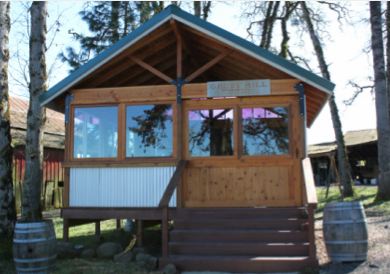 Shown below are (right to left) Rebecca Pittock-Shouldis, Drenda Bayliss, and Mike Bayliss.
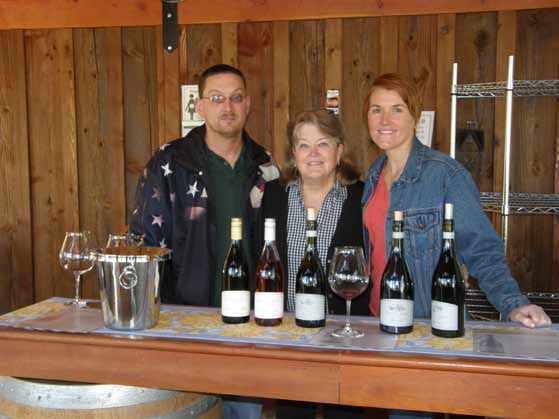
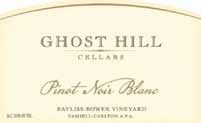 2012 Ghost Hill Cellars Yamhill Carlton Pinot Noir Blanc 13.5% alc., pH 3.40, 416 cases, $25, screwcap. Produced since 2010 from young clone 115 vines. Whole cluster pressed into 100% stainless steel. Cool fermentation over 5 months on lees until it was filtered 3 days before bottling. · Pale rose with a gold cast in the glass. Aromas of apple and peach are echoed in the flavors with an added touch of red berry. Boisterous and complex with a lively cut of acidity. Pinot Noir Blanc always challenges the senses. Score: 89
2013 Ghost Hill Cellars “Spirit of Pinot Noir” Yamhill-Carlton Rosé 13.0% alc., pH 3.43, 156 cases, screwcap, $20. 50% saignée and 50% a byproduct of Pinot Noir Blanc pressing. Aged 6 months on lees with stirring in stainless steel. · Modest pink color in the glass. A crisp, lively wine with aromas and flavors of strawberry, blood orange, orange zest and cranberry. Satisfying, with some fruit dancing on the finish. Score: 88
2011 Ghost Hill Cellars Bayliss-Bower Yamhill-Carlton Pinot Noir 13.2% alc., pH 3.69, 300 cases, $42. Clones 114, Wädenswil, 777, and Pommard. 100% de-stemmed. Aged in 10% new French oak. 2012 International Pinot Noir Celebration Featured Wine. · Moderately light reddish purple color in the glass. Lovely and spirited nose offering hi-tone aromas of cherry, dried herbs and spice. Middleweight flavors of dark cherry, sassafras, and savory herbs. Juicy and fresh, with a long, dry finish. Score: 90
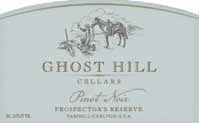 2011 Ghost Hill Cellars Prospector’s Reserve Yamhill-Carlton Pinot Noir 13.5% alc., pH 3.64, 100 cases, $55. A 5 barrel selection of clones 114, 777, Pommard and Wädenswill in about equal proportions. One new barrel. · Moderately light reddish purple hue in the glass. Very deep and enticing cherry aroma with a rose petal note. Discreetly concentrated core of cherry and raspberry fruit supported by fine-grain tannins and balanced acidity. Barrel management is spot on and the finish is particularly noteworthy for its persistence. Score: 92
2008 Ghost Hill Cellars Bayliss-Bower Yamhill-Carlton Pinot Noir 13.5%, re-release of 14 cases, $62. 100% free-run juice. Rebecca’s first wine at Ghost Hill Cellars. Some held back because the 2009 vintage was so fruit-forward and released again in May 2014 to Wine Club. · Medium reddish purple color in the glass. Deep black cherry aromas with a swirl of raspberry and a hint of watermelon. Full-bodied and structured with a core of intensely flavored black cherries and dark raspberries with a touch of spice, herbs and oak. The finish is generous and lasts over 30 seconds. A special wine with many years ahead. Score: 92
Lenné EstateDuring my recent visit with Steve Lutz, the owner, manager and vineyardist behind Lenné Estate in the Yamhill- Carlton AVA, we tasted through the lineup of 2012 vintage Pinot Noirs side-by-side. Established in 2002, the Lenné Estate’s 20.9-acre vineyard is ideally situated among many famous neighboring estates such as WillaKenzie Estate, Shea Wine Cellars & Vineyard, Solena (recently acquired by Kendall-Jackson), and Saffron-Fields Vineyard. The vineyard is entirely Pinot Noir, planted to clones 115, Pommard, 114 and 777 in 2001, additional Pommard in 2003 and additional 114 and 777 in 2004. Soils are primarily Peavine with some Willakenzie. Elevation is 375-575 feet with primarily a south facing aspect.
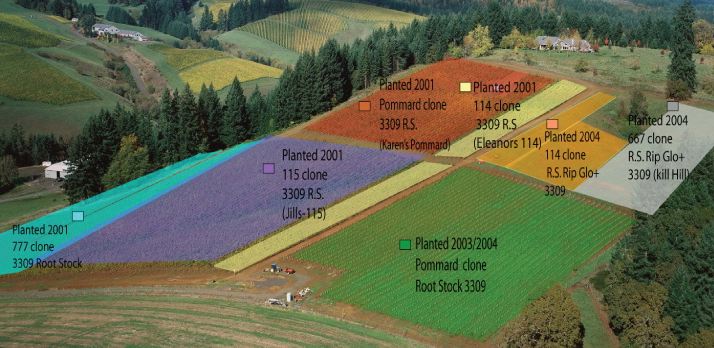 Steve said the 2012 vintage was very moderate and similar to 2008, except for a warm easterly wind that developed over five days in September which pushed the vintage closer to 2006. He noted, “The resulting pH’s were nudged higher, yet retained enough acidity to hold the wines together, and the wines retained enough structure to retain interest and to age nicely over the mid-term.” The wines are forward and highly approachable, so much so that Steve plans to release them and pull the 2011 vintage Pinot Noirs back into storage for another 6 months. He believes cool vintages like 2011 make the best wines in Oregon, but they take longer to come around. He said, “I love the 2011s and by November they will be delicious. Six months ago my 2011 wines were barely drinkable.” The 2012 vintage was characterized by small clusters and berries and little disease pressure allowing the fruit to be harvested very clean. Rounding up enough pickers at harvest was the biggest challenge. The 2012 wines required no special manipulation. After a 5-day cold soak, the must was inoculated, punched down a couple times a day, and pressed without any extended maceration. Steve is not a believer in extended barrel aging so the wines were kept in barrel for 11 months and then bottled unfiltered. The wines are vinified by winemaker David O’Reilly of Owen Roe fame. David recently broke up with his partner and no longer makes wine at the St. Paul winemaking facility the partners used for years. Steve is planning to build a custom crush facility on the Lenné Estate property where the wines of Lenné Estate can be produced side-by-side with O’Reilly’s Owen Roe wines along with wines of other producers. Last year an initial offering to raise money for the new facility brought in 50% of the needed funds. Investors received 4% to 5.5% on their loan and a Lenné wine component allocation. Inquire with Steve if you have interest in becoming a lender/investor. Steve is also currently expanding his tasting room to include a kitchen, making the hospitality facility more amendable to hosting events. All the 2012 wines tasted were elegant and eager to please with modest tannins and generous fruit-forward flavors.
2012 Le Nez Willamette Valley Pinot Noir 14.1% alc., $30. All five clones from the estate vineyard. · Moderately light garnet color in the glass. Aromas of cherry, herbs and balsam. Bright cherry and strawberry flavors with a hint of spice and mocha. Elegant, fresh and easy to drink, with some finishing fruit vibe. Score: 89
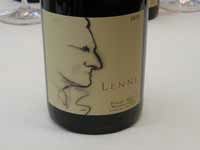 2012 Lenné Estate Willamette Valley Pinot Noir 14.1% alc., $45. A barrel selection of the finest barrels from the best parts of the vineyard. · Moderately light reddish purple color in the glass. Pleasing aromas of dark cherry and black raspberry with a hint of hard red candy and spice. Mid weight flavors of black cherries with an accent of clove, dark chocolate and savory herbs. Nicely composed, with balanced tannin and acidity. Highly approachable now. Score: 93
2012 Lenné Estate Jill’s 115 Yamhill-Carlton Willamette Valley Pinot Noir 14.1% alc., 150 cases, $55. The best barrels from the 115 block. Named after Steve Lutz’s mother-in-law Jill. · Moderately light reddish purple hue in the glass. The nose picks up intensity over time in the glass, revealing deep aromas of strawberries, cherries and spice with an earthy undertone. Similarly earthy on the palate with fresh, middleweight flavors of red fruits, herbs and subtle oak. The tannins are reigned in and the wine is easy to like. Score: 90
2012 Lenné Estate Kill Hill 667 Yanhill-Carlton District Willamette Valley Pinot Noir 14.1% alc., 100 cases $55. Best barrels from steepest and most stressed part of the vineyard. · Moderately light reddish purple color in the glass. Shy initially, opening up slowly over time in the glass to reveal aromas and flavors of dark red cherries and plum. Impressively sappy on the mid palate with remarkable intensity on the finish. Nicely balanced with fine-grain tannins and juicy acidity. Score: 92
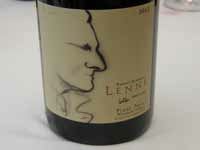 2012 Lenné Estate Karen’s Pommard Willamette Valley Pinot Noir 14.1% alc., 150 cases, $55.The best barrels from the Pommard block. Named after Steve Lutz’s spouse, Karen. · Moderately light reddish purple color in the glass. Very complex nose offering an array of pleasurable aromas including black cherry, cola, mocha, spice, rose petal, and sweet oak. The discreetly concentrated core of perfectly ripened black cherries is complimented by a riff of cola and spice. The peacock finish is the most intense and lengthy of the 2012 Lenné wines. Score: 94
The 2012 Pinot Noirs were released May 31. The tasting room is open weekends from 12-5 and other times by appointment. You are also welcome to come in anytime the gate is open. Visit the website at www.leneestate.com. Interestingly, Steve held back 110 cases of the 2008 vintage and will release them in September 2014. These are highly complex wines that seem to be capable of aging forever. A special 2008 Pinot Noir consisting of a selection of some of the best barrels from the 2008 vintage is offered currently for $55. Labeled the Lenné Wetlands Conservancy Pinot Noir, nearly half of the proceeds from the sale of each bottle are donated to Wetlands Conservancy. Contact Steve directly to order: steve@leneestate.com.
2008 Lenné Estate Jill’s 115 Yamhill-Carlton Oregon Pinot Noir 49 cases. · Moderately dark reddish purple color with a slight orange tone. Aromas of dried cherry, shoe leather and spice. The palate is alive with secondary characters of orange peel, herbs, and cigar box complimenting the luscious dark cherry core. The wine still has plenty of tannin for the long haul, but the tannin is not imposing at this stage. A delightful Pinot Noir with plenty of life ahead. Score: 92
Anne Amie VineyardsI met recently with Director of Winemaking Thomas Houseman at Annie Amie Vineyards located in the Yamhill-Carlton AVA on Mineral Springs Road. Thomas graduated from the enology and viticulture program at University of California at Fresno, and learned his winemaking working at Husch Vineyards in the Anderson Valley, Bleinheim Winery and Bell Hill Winery in New Zealand, and Ponzi Vineyards in the Willamette Valley. Along with Director of Viticulture, Jason Tosch, who also came from Ponzi Vineyards, the pair have transformed Annie Amie Vineyards into a world-class winery.
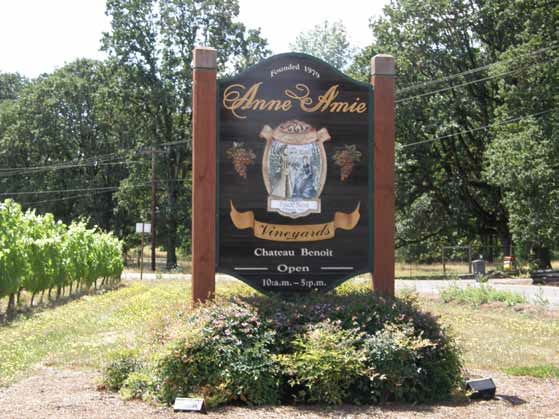 90% to 95% of the Anne Amie wines are now produced from estate fruit. All estate vineyards are certified LIVE (Low Input Viticulture & Enology) and Salmon Safe. The estate vineyards are located in the rolling hills adjacent the winery (Anne Amie Estate) and on the steep hillsides of the Chehalem Mountains (Twelve Oaks Estate). Most of the Pinot Noir is now sourced from the Twelve Oaks Vineyard situated at 660 to 820 feet elevation in the Chehalem Mountains which is planted to multiple clones on about 36 acres. All Pinot Noirs are fermented with native yeasts. In the 2011 Pinot Noirs reviewed here, about 15% to 20% whole cluster was used because harvest was late and the stems were mature. All wines are unfined and unfiltered and bottled under screwcap.
 2010 Anne Amie Prismé Yamhill-Carlton Willamette Valley Pinot Noir Blanc 14.1% alc., pH 3.41, TA 0.66, 268 cases, $50. Released May 2013. Sourced from Anne Amie Estate and Rainbow Ridge vineyards. Clones are Pommard and 115. Free-run juice was racked into French oak puncheons and barrel fermented with lees stirring, full malolactic fermentation, and aged for 18 months in 38% new and 62% neutral oak before bottling. · This is a serious wine that displays intriguing complexity. Mild golden yellow color and clear in the glass. The aromatic profile is quite pleasing with scents of pear, baked apple, kiwi and vanilla. Slightly creamy on the palate and juicy acidity on the finish with an array of flavors including pear, apple and peach with a nutty undertone. Much more expressive and alive the following day from a previously opened and re-corked bottle. Peaches and cream is the main theme but hints of coconut and pineapple add interest. Score: 92
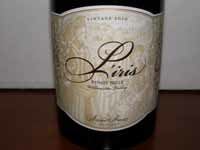 2010 Anne Amie L’Iris Willamette Valley Pinot Noir 13.3% alc., pH 3.59, TA 0.61, 230 cases, $60. Released May 2014. 74.2% Twelve Oaks Estate, 15.8% Rainbow Ridge and 10% Anne Amie Estate. Clones are Pommard 4, 667, 777, 114, 113, 115, and Wädenswil. 100% de-stemmed, 5-day cold soak, free-run juice was racked into French oak barrels where the wine completed malolactic fermentation. Aged 18 months in 20.5% new, 35% 1-year, and 44.5% neutral French oak and 2-3 years in bottle. · Moderately light reddish purple color in the glass. Vibrant aromas of cherry, red berry, sandalwood and spice lead to an elegantly styled wine that charms you with flavors of red cherries and berries, blueberries, savory herbs, spice and a compliment of oak-driven notes. The tannins are evident but not intrusive and indicate age ability, and the finish is a veritable spice bomb. Tasted the following day from a previously opened and re-corked bottle, the wine was flat-out great. Score: 94
2011 Anne Amie Winemaker’s Selection Willamette Valley Pinot Noir 13.1% alc., pH 3.56, TA 0.64, 4,286 cases, $30. Released January 2014. 44.1% Anne Amie Estate, 42% Twelve Oaks Estate, 9.8% Rainbow Ridge, and 4.1% Alloro vineyards. Harvest extended to November 6. Largely de-stemmed, 7-21-day cold soak, extended maceration, and on the skins for a total of 28-40 days. Free-run and light pressings were combined and aged 11 months in 29.9% new, 10.3% 1-year, and 59.8% neutral French oak. · Moderately light reddish purple color in the glass. Intriguing aromas of cherry, rose petal and exotic spices. The core of red cherry and cranberry fruit is satisfying, but the nose is the best feature of this easy to drink wine. Suave tannins and a refreshing lift of acidity on the finish complete the experience. Score: 88
2011 Anne Amie Twelve Oaks Estate Chehalem Mountains Willamette Valley Pinot Noir 13.4% alc., pH 3.64, TA 0.62, 194 cases, $40. Released November 2013. Laurelwood soil. Clones 115, Pommard 4, 777 and Wädenswil. Largely de-stemmed, 5-day cold soak, aged 12 months in 25% new, 18% 1-year, and 57% neutral French oak. · Moderately light reddish purple color in the glass. Hi-tone aromas of cherry, balsam, rose petal and spice draw you in. Mid weight flavors of black cherry and spice and caressed by supple tannins. Very silky on the palate with a bright finish. Still charming the following day from a previously opened and re-corked bottle. Score: 92
2011 Anne Amie Anne Amie Estate Yamhill-Carlton Willamette Valley Pinot Noir 13.4% alc., pH 3.55, TA 0.65, 198 cases, $40. Released November 2013. Clones are Pommard 4 and 115 grown in Willakenzie soil. Largely de-stemmed, 5-day cold soak, aged 16 months in 3% new, 25% 1-year and 72% neutral French oak. · Moderately dark reddish purple color in the glass. Deep aromas of black cherry, black raspberry and a hint of spice. The fruit has a riper profile than the Twelve Oaks with darker stone and berry fruit and a touch of herbs and floral goodness in the background. The best feature is the big, bright, juicy cherry finish which is very prominent the following day from a previously opened and re-corked bottle. Score: 91
Thomas is one of the three winemakers participating in “The Cube Project” that began with the 2010 vintage. Thomas, Andrew Brooks of Bouchaine Vineyards in Napa Carneros, and Leslie Mead Renaud of Lincourt Vineyards in Santa Barbara County devised an experiment that compared winemaker technique with terroir. The three wineries picked 6 tons of Pommard clone Pinot Noir from their own vineyard in the 2010, 2011 and 2012 vintages. They divided the grapes into thirds, with each of the three winemakers processing 2 tons (about 120 cases) of Pinot Noir grapes. Each winemaker was responsible for picking decisions at their own winery and the grapes were picked on the same day so each of the three wines started on equal footing. Each winemaker crafted their wines from the two other vineyards in the same fashion as the wine from their own vineyard. The Cube Project was first presented at the World of Pinot Noir in 2012: www.princeofpinot.com/ article/1195/. For more information also visit www.anneamie.com/cube-project. Once the project is completed, you will be able to buy all 9 wines and decide for yourself whether terroir or winemaking technique are most obvious. The 2010 vintage wines are now available on the Anne Amie website. I tasted the three 2011 wines made by Thomas as part of The Cube Project. They were tasted blind the day the bottles were opened and re-tasted the following day. All wines were 100% de-stemmed and unfiltered, with varying oak treatment.
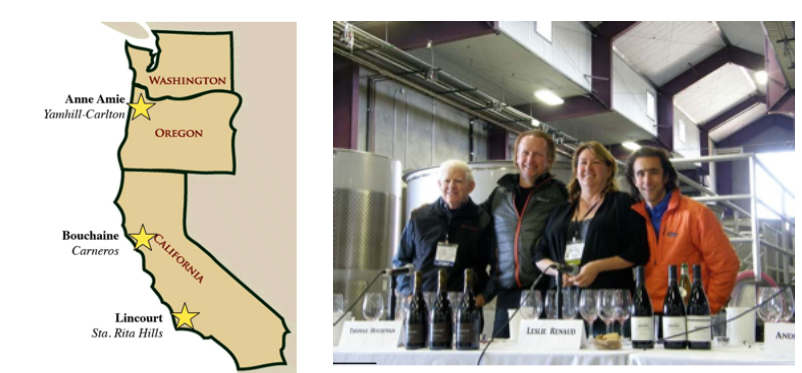
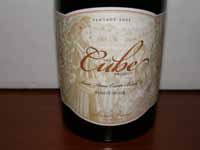 2011 Cube Anne Amie Estate Yamhill-Carlton Pinot Noir 13.3% alc.. · Moderately light garnet color in the glass. Nicely perfumed with fresh cherries and spice. Intensely flavorful on the mid palate and finish, yet light on its feet, with a flourish of Bing cherry and plum fruit, herbs, spice and sandalwood. The following day, the wine was noticeably more aromatic and equally flavorful with a good firm structure and bright acidity for aging. Score: 90
2011 Cube Bouchaine Estate Vineyard Napa Carneros Pinot Noir 13.9% alc.. · Moderately light garnet hue in the glass. An array of scents stand out including cherry, black raspberry and exotic spices. Soft and smooth on the palate with plenty of body, lively acidity, and flavorful notes of purple grapes, plum, and black cherry. The following day, the wine was more earthy and savory in character. Score: 90
2011 Cube Lincourt Lindsay’s Vineyard Santa Barbara County Pinot Noir 14.1% alc.. · Dark, dense reddish purple color in the glass. Shy aromas of black raspberry, grape, spice and herbs. This wine has the most sap, shows the most oak sheen, and is the most luscious featuring full flavors of purple grape, dark raspberry and black currant. The following day, the fruit tasted too ripe and raisiny, and nose was heavy with smoky oak. The fruit core was massive and the finish was big, but it was a tad too much for me. Score: 87
The wines clearly showed their terroir and it was easiest to pick out the Oregon wine. Without tasting the other winemaker’s wines, I can’t comment on the effect of winemaking on the finished wines. Stay tuned as the project progresses.
Carabella VineyardWhile living in Denver, Colorado, Mike Hallock was smitten with Oregon Pinot Noir on a steelhead salmon fishing trip. As a geologist, he spent twelve years mapping vineyard soils until he found his ideal site for Pinot Noir in 1995 at the McDonald farm on Parrett Mountain in the Chehalem Mountains AVA. He pursued winemaking and viticulture classes at University of California at Davis, worked along side winemaker Kathy Joseph of Fiddlehead Winery who made wine in Oregon for several years, planted 49 acres in 1996 and celebrated his first harvest and wines in 1998. It was probably the largest vineyard planting at one time in the Chehalem Mountains. The first four years, he commuted from Denver to the Willamette Valley to manage the vineyard and craft the Carabella wines, finally moving out to Oregon for good in 2002.
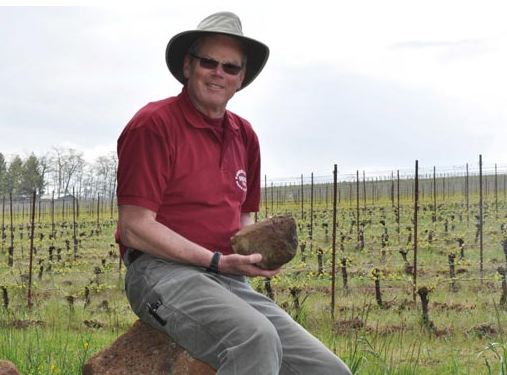 On my recent visit, I walked the entire Carabella Vineyard with Mike. The site is ideal for Pinot Noir and Chardonnay, located at an altitude of 500 to 600 feet and consisting of gravelly volcanic soils. The original 1996 planting was Pinot Noir clones 115, 114, 113 and Pommard and Wädenswil. After ten years of learning about the site, he planted 667, 777 and a little bit more of 115 in 2007. Chardonnay plantings are Dijon clone 76, and there are two different clonal blocks of Pinot Gris. Total planted acreage is now 59 acres. About half the fruit from the vineyard has been sold to premium Willamette Valley producers including Bergström (Chardonnay), Winderlea, Union Wine Co. and Beaux Freres. The vineyard is Certified Sustainable and Mike uses no herbicides or chemical pesticides. The vines are dry farmed. Along with his spouse, Cara, the couple have been gradually converting the cover crop in the vineyard to native fescue and other native flora, hoping to attract beneficial insects that live in the nearby oak Savannah. Mike’s plantings of clone 113 are unusual because this Dijon clone has been rarely established in California and Oregon in volcanic soils. ENTAV-INRA Clone 113 is from Morey St. Denis. It produces average to high sugar levels, good quality and a sufficient but sometimes irregular yield. Possibly the most elegant of the Pinot Noir clones, it is early ripening with charming aromatics and displays a classic blend of plum, cherry and raspberry fruits. This clone has prospered at Carabella Vineyard and a Dijon 113 bottling is offered, a true rarity in the Pinot Noir world. There is an interesting story behind one particular planting in the Carabella Vineyard known as the Mistake Block. In 1998, while planted Dijon 113 vines, it was discovered after the vines were planted that some vines were mislabeled. As a result, there are 13 rows of Pommard clone (3/4 acre) and these vines have turned out to produce extraordinary wine. The grapes were blended into other Carabella wines until 2008 when a “Mistake Block” wine was released. Since then the wine has been produced in only select years.
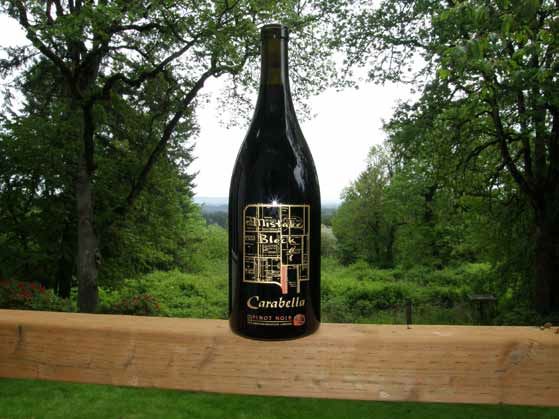 Carabella wines are produced exclusively from estate fruit. The wines are sold on the website at www.carabellawine.com and through a Bedrock Wine Club. There is some distribution to other states including New York, Illinois and Florida. A second, value-priced label ($20), Plowbuster, is sourced from several AVAs and has an Oregon AVA designation. It offers excellent drinking and is more widely distributed. Total production is 4,000-6,000 cases annually. The winery does not have a tasting room. I have favorably reviewed a number of Carabella and Plowbuster wines in the past. I tasted some Carabella wines in the vineyard and in the Hallock’s home. My impressions follow.
2010 Carabella Estate Chehalem Mountains Oregon Chardonnay 13.5% alc., $27. Barrel fermented, 100% malolactic fermentation, aged in about 15% new French oak. · Aromas and flavors of citrus, banana, vanilla and nuts. Slightly creamy and soft in the mouth with a good cut of acidity on the bright finish. Score: 88
2008 Carabella Eva’s Garden Chehalem Mountains Oregon Chardonnay 13.5% alc., $39. · Similar to the 2010 Estate bottling but more vibrant and appealing with flavors of lemon curd, apple and peach. Soft and slightly creamy in the mouth with a long, very silky finish. Like this. Score: 90
2011 Carabella Estate Chehalem Mountains Oregon Pinot Noir 13.5% alc., $39. · Moderately light reddish purple color in the glass. Highly aromatic with bright scents of cherry and plum, spice, rose petal and herbs. Beautifully balanced and highly elegant, with flavors that echo the hose embraced by modest tannins. The texture is silky and the finish is satisfyingly appointed with red fruits and herbs. Score: 90
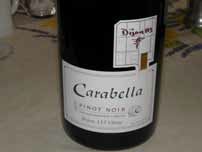 2010 Carabella Estate Dijon 113 Chehalem Mountains Oregon Pinot Noir 13.5% alc., $54. · Light garnet color in the glass. Delicate aromas of cherry, floral display and brown spice. Very elegant and silky on the palate, with light weight but pleasing flavors of cherry and raspberry supported by fine-grain tannins. A very charming wine. Score: 92
 2008 Carabella Eva’s Garden Chehalem Mountains Oregon Pinot Noir 14.5% alc., $75. A selection of the best blocks on the Carabella site. Primarily 113 with some of the oldest 115 plantings and Pommard from the Mistake Block. · Moderate reddish purple hue in the glass. Spectacular nose with effusive aromas of fresh black cherries, black raspberries and spice. Everything you could ask for in a Pinot Noir. Vivid and spiced dark stone and berry fruits are beautifully blended into a layered fruit wonderland, the tannins are submerged, the mouth feel is silky smooth and the finish is generous and persistent. Score: 94
J. Wrigley VineyardJohn Wrigley developed an interest in winemaking in 1984 when he graduated from college. Home beer brewing was popular at the time and stores that stocked beer brewing kits also had wine making kits. A friend had made a plum wine at home, and although John did not like the wine, he was intrigued by the process. He bought a gallon of concentrated grape juice and made a wine by a recipe. The first day he tried it, it was good, but it quickly oxidized over the ensuing two days. He realized he needed to learn more and began reading books on winemaking to feed his curiosity. Before long he read everything he could get his hands on including material from UC Davis. As his home winemaking evolved, he wanted to start making wine commercially but did not want the uncertainty of sourcing grapes. He knew he needed the vineyard component. On a fishing trip in Oregon, he met winemaker Andrew Rich and had an Oregon Pinot Noir epiphany. Until that time, he had been a “California Cabernet guy.” He began exploring every AVA in the Willamette Valley and tasted wines from each region. John found that he preferred the bolder style of Pinot Noir wines from the McMinnville AVA, and bought 200 acres of prime vineyard land in Sheridan in the McMinnville AVA in 2006. The property has about 80 acres suitable for planting wine grapes. The rest of the property is planted to Douglas fir timber and too steep to farm without the use of specialized equipment. The site is located 12 miles southwest of the town of McMinnville at 210 to 740 feet elevation. The majority of the property is desirable east and south facing slopes and contains a complex mixture of volcanic and sedimentary soils.
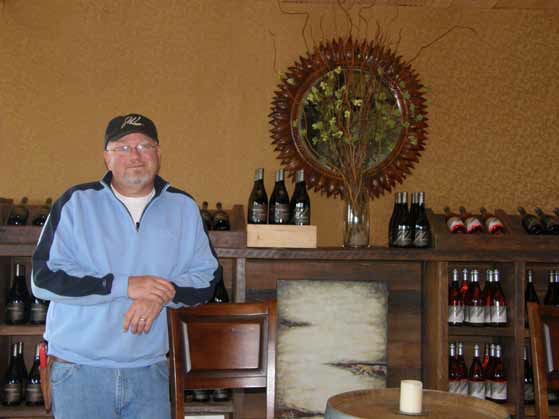 Because of the western and elevated location of the site, the vineyard benefits from the winds arriving through the Van Duzer Corridor, so there is little mildew pressure. The property is definitely in a very cool location, so cool that some told John he couldn’t successfully grow wine grapes there. He knew, however, that Coleman Vineyard and Hyland Vineyard were on nearby ridges, and the healthy growth of poison oak and mint on the property was a sign that wine grapes could be successfully farmed. John has an incredible knowledge of Oregon soils which he shared with me as we drove around the property. He loves to show off the old quarry on the property where 35 million years of Yamhill County in the making can be viewed through the cut away of the mountain. It is a rare opportunity and a breathtaking experience. I won’t go into detail here, but if you visit, and you should, he would be happy to give you a tour. (The picture doesn’t do it justice!)
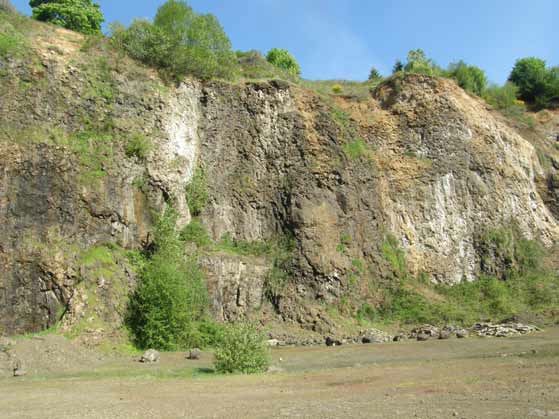 In 2008, the first Pinot Noir (Pommard, 115 and 777), Riesling and Pinot Gris vines were planted. Since that year the vineyard has been dry farmed, with the aim of seeking vintage variation in the wines. A small amount of clone “828” was planted subsequently bringing the total vineyard size to 10 acres. The first estate Pinot Noir was released from the 2011 vintage. I tasted the J. Wrigley Vineyard wines in the charming tasting room situated on the summit of the property with panoramic views of the Willamette Valley and Mt. Hood in the distance. John says he makes wine to please himself and hopes that others find it enjoyable as well. He avoids commercial additives and extended maceration. The wines are aged sur lie in barrel with periodic stirring at the time of topping. Over time, his palate have evolved and he prefers more elegant and polished wines with proper balance. This style was evident in the wines I tasted. J. Wrigley Vineyard is a small family operation. John manages the vineyard and crafts the wines, while still working as a catastrophic claims insurance adjustor. Currently, total production is about 500 cases. His spouse, Jody, sells the wines. The wines are sold on the website at www.wrigleywines.com and through a wine club. Visitors are welcome by appointment. An informative blog is presented on the website.
2013 J. Wrigley McMinnville Oregon Rosé of Pinot Noir 150 cases, $20, screwcap. Whole cluster pressed with some finished wine blended back in for color. Cold fermented to taste. Slight residual sugar. · Light pink color and clear in the glass. Typical aromas of Pinot Noir Rosé of strawberry, rose petal and orange flower water. A charming and refreshing wine with flavors of strawberry, blood orange and a hint of cotton candy. The bright, acid-driven finish is driven by orange zest flavor. Score: 89
2010 J. Wrigley “MAC” Cuvée McMinnville Oregon Pinot Noir 12.7% alc., $38. From sourced grapes (Yamhill Valley and Coleman vineyards). Extended barrel aging for over 2 years in 25% new French oak. Pommard, 777 and 667 clones. · Light reddish purple color in the glass. Complex nose offering aromas of cranberry, cherry, strawberry, dusty earth and a hint of spice. Elegant and charming with reigned in tannins, and featuring a smoky cherry core. Score: 89
2011 J. Wrigley Proposal Block Estate McMinnville Oregon Pinot Noir 12.5% alc., 150 cases, $38. Primarily volcanic soil. Pommard, 777 and 115 clones. Aged in 18%-20% new French oak. · Moderately light reddish purple color in the glass. Aromas of cherry, dried herbs, forest floor and rose petal lead to bright flavors of cherry, raspberry and spice. Demure and suave, with managed tannins and lively acidity. Tasted again later in the day from an opened bottle, the wine had picked up significantly more richness and intensity and took a velvety texture. A seductive wine that could benefit from another year in bottle. Score: 91
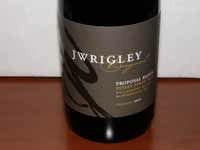 2012 J. Wrigley Proposal Block Estate McMinnville Oregon Pinot Noir 14.0% alc., 250 cases, $45. Primarily volcanic soils. Pommard, 777 and 115 clones with a little more Pommard than in 2011. · Moderate reddish purple color in the glass. Nicely perfumed with aromas of ripe black cherries, black raspberries and spice. Rich and full on the palate with a healthy tannic structure and a long, dry finish. The flavor profile leans to black cherry and plum with a hint of earth and herbs. Tasted later in the day from an opened bottle, the wine was still big-boned and fruity, and the finish was magnificent. Score: 92
2012 J. Wrigley “MAC” Cuvée McMinnville Oregon Pinot Noir 14.0% alc., 225 cases, $38, screwcap. Yamhill Valley Vineyard and J. Wrigley Vineyard grapes. Clones 115, 667 and 777. Primarily marine sedimentary soils. · Moderate reddish purple color in the glass. The nose is a touch floral with added scents of cherry and sandalwood. Plenty of sappy black cherry, black raspberry and plum fruits with a sweet edge. Modest tannins, supportive oak, and some finishing intensity. A fruit-driven wine that can be enjoyed now. Score: 89
Guillen Family WinesThrough the years I have run across many Mexican immigrants that have achieved success as winegrowers, winemakers and winery owners in California. The story of Jesus Guillen is the first such story I have met with in the Willamette Valley. Jesus Guillen, Sr., came to Oregon in 2000 from Chihuahua, Mexico, encouraged by a Mexican immigrant working as a winegrower. He ended up at White Rose Estate as the vineyard manager. His son, also named Jesus, graduated from the University of Chihuahua in 2001 with a degree in computer systems engineering. He came to Oregon on a visitor’s visa, immediately fell in love with Oregon, and decided to stay. In 2002, his mother, brother and sister immigrated to Oregon. Jesus studied English at the local community college, read extensively about viticulture and winemaking, and developed a palate for the local wines. His epiphany came from two wines: the 1999 Archery Summit Arcus Summit Pinot Noir and the 1999 Adelsheim Elizabeth’s Reserve Pinot Noir. Jesus became a vineyard worker for Patricia Green in 2002. He also worked with his father, Jesus, Sr., at Laurel Ridge Winery where Jesus, Sr., was helping Greg Sanders of White Rose Estate make his wines. When the winery was completed at White Rose Estate, Jesus started working in the new winery’s cellar. At the time, Mark Vlossak of St. Innocent was the consulting winemaker, and Jesus acquired much of his winemaking skills from him. He also received some mentoring from Gary Andrus. Because of his considerable talent, Jesus was promoted to winemaker by 2008 and now crafts the White Rose Estate wines with producer and owner Greg Sanders. Jesus launched his own small label in 2009 with the 2007 vintage, sourcing fruit from Vista Hills Vineyard which is near White Rose Estate in the Dundee Hills. The wines are vinified in a similar fashion to those of White Rose Estate with 100% whole cluster (since 2010) and native yeast fermentations, basket pressed, and aging in neutral French oak (Dreamcatcher and Damian), or 100% new French oak (Adrian). Damian and Adrian are aged sur lie. Adrian is built for ultimate complexity and is aged in 100% new French oak. It is bottled when Jesus feels the oak is well integrated. The Guillen Family Pinot Noirs tend to be slightly more full-bodied and extracted than the White Rose Estate Pinot Noirs so they have their own character. Total production of 3 Guillen Family wines is only about 80 cases. Guillen Family Wines are produced in such small quantities they quickly sell out so I hesitate to rave about them. I was honored that he was willing to open the following eight wines for me. The wines are sold through a mailing list at www.guillenfamily.com. Jesus has also made some wine for Vista Hills Vineyard including the 2011 Vista Hills Vineyard Rollins which is crafted from the oldest block in the vineyard and vinified 100% whole cluster. Jesus is pictured below (left) at White Rose Estate with White Rose Estate manager Gavin Joll.

2009 Guillen Family Dreamcatcher Dundee Hills Oregon Pinot Noir 14.1% alc., $25. High percentage of whole cluster. Aged in neutral French oak barrel. · Moderate garnet color in the glass. A solid, mid weight wine with enticing aromas of cherry, raspberry, rose, and spice echoed in the flavors that fan out on the palate, displaying a balanced backbone of soft tannins. Score: 89
2010 Guillen Family Dreamcatcher Dundee Hills Oregon Pinot Noir 12.8% alc., 61 cases, $25. Sourced from Vista Hills Vineyard Block F planted in 2005 with Dijon 667. Jory soils. 100% whole cluster, native fermentation, 7-day cold soak, 20-day skin contact, basket pressed, aged 11 months in neutral French oak, racked twice, after malolactic fermentation and before bottling. Filtered. · Moderately light reddish purple color in the glass. Light in weight, but packs plenty of flavor, with vibrant and juicy flavors of cherry and spice. Aromatically inviting with scents of spiced cherries and a hint of smoke. Score: 90
2010 Guillen Family Damian Dundee Hills Oregon Pinot Noir 12.8% alc., 23 cases, $40. Sourced from Vista Hills Vineyard Block F planted in 2005 with Dijon 667. Jory soils. 100% whole cluster, native fermentation, 7-day cold soak, 20-days skin contact, basket pressed, aged sur lie 11 months in a neutral French oak barrel. Racked twice and filtered. · Light garnet hue in the glass. Very pure nose typical of whole cluster with hi-tone cherry, spice and floral aromas. A well-sustained mid palate features ripe cherry and raspberry flavors that carry over to a generous finish. More viscosity and an appealing velvety mouth feel. Score: 92
2011 Guillen Family Dreamcatcher Dundee Hills Oregon Pinot Noir 12.8% alc., 31 cases, $25. Sourced from Vista Hills Vineyard Block F planted in 2005 with Dijon 667. Jory soils. More strict sorting in this vintage. 100% whole cluster and native fermentation, 11-day cold soak, 22 days on skins, basket pressed, aged in neutral French oak barrels for 11 months. Racked twice and filtered. · Moderately light reddish purple color in the glass. Lovely whole cluster nose featuring bright aromas of warm cherries and spice. The core of black cherry fruit is complimented by a lively underbelly of acid and a firm, but noble, non-astringent tannins. The long and mighty finish is especially notable. Score: 92

2011 Guillen Family Damian Dundee Hills Oregon Pinot Noir 12.8% alc., 23 cases, $40. Sourced from Vista Hills Vineyard Block F planted in 2005 with Dijon 667. Jory soils. 100% whole cluster and native fermentation, 11-day cold soak, 22 days skin contact, basket pressed, aged sur lie in a neutral French oak barrel for 11 months. Racked twice and filtered. · Moderately light reddish purple hue in the glass. Very exotic whole cluster nose with an array of spice and floral notes accenting the cherry essence. Very similar to the 2011 Dreamcatcher on the palate with an added note of herbs and Asian 5-spice. Inviting viscosity and sap supported by a muscular, but suave backbone of tannins. Score: 92
2011 Guillen Family Adrian Dundee Hills Oregon Pinot Noir 12.8% alc., 23 cases, $60. One barrel of reserve wine. Sourced from Vista Hills Vineyard Block F planted in 2005 with Dijon 667. Jory soils. 11-day cold soak, 22 days skin contact, basket pressed, aged 24 months sur lie in one new French oak barrel. Racked twice and filtered. · Moderately dark reddish purple color in the glass. Soaring, bright aromas of darker stone and berry fruits accented with spice and dark red rose petals. Powerful, yet very polished, with a layered array of dark red and purple fruits, well-spiced, with nonintrusive oak. Suave tannins show up on the glorious finish. Score: 95
2012 Guillen Family Damian Dundee Hills Oregon Pinot Noir 13.6% alc., 61 cases, $40. Sourced from Vista Hills Vineyard Block F planted in 2005 with Dijon 667. Jory soils. 4-day cold soak, 22 days skin contact, basket pressed, aged 11 months sur lie in neutral French oak. Racked twice and filtered. · Moderately dark reddish purple color in the glass. Invigorating aromas of black cherry pie glaze, vanilla, wilted rose and spice. Eye-opening attack of well-ripened black cherry and black raspberry fruits which are vivid and juicy. The tannins are beautifully managed and balanced acidity adds verve. The aging potential is obvious from the full and persistent finish. Score: 94
2012 Guillen Family Adrian Dundee Hills Oregon Pinot Noir 13.4% alc., 23 cases, $60. Sourced from Vistal Hills Vineyard Block F planted in 2005 with Dijon 667. Jory soils. 4-day cold soak, 22 days skin contact, basket pressed, aged 17 months sur lie in one new French oak barrel. Racked twice and filtered. Bottled very recently. · Moderately dark reddish purple hue in the glass. The nose is reticent, giving up reluctantly some hints of darker fruits, spice and a subtle oak. Rich and sappy, with a plethora of fruit flavors including black raspberry, plum, cassis and spice, supported by broadshouldered, yet refined tannins. The wine has a caressing mouthfeel, and a finish of startling length. I think Grand Cru entered my mind while tasting this beauty. Still very young, but the potential is obvious. Score: 95
Beckham EstateAndrew and Annedria Beckham have a charming vineyard property in Sherwood, Oregon, in the Chehalem Mountains, where they grow grapes for their wines that reflect the site and individuality of the vintage. Their tasting room, constructed by Andrew, is inviting and the hosts are very warm people. Both Andrew and Annedria are energetic people with him managing the vineyard and crafting the wine, and she, with three children in tow, managing sales and marketing. This is a family winery in the truest sense of the word.
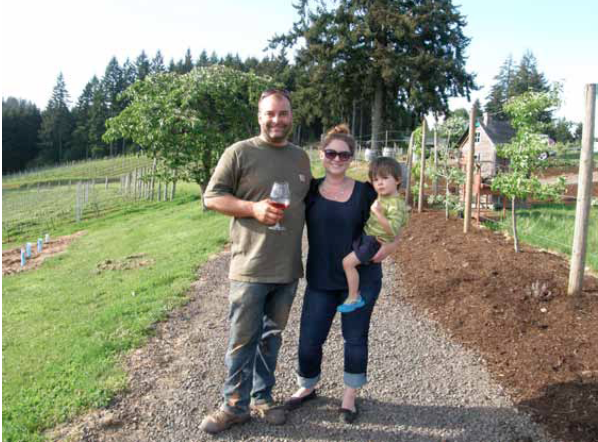 Andrew never set out to grow wine grapes or become a winemaker. The property, surrounded by heavily forested Chehalem Mountain woods on the flank of Parrett Mountain, was originally acquired by the Beckhams to allow Andrew, a ceramist and ceramics teacher, to have a large clay workshop for his craft. A neighbor across the street had a small vineyard and drew Andrew into the romance of winegrowing. The Beckhams soon had a 6.5-acre vineyard of their own adjacent their home. The south, southwest and southeast facing vineyard was planted to Pommard, Wädenswil, 115 and 777 Pinot Noir clones at an elevation of 412-568 feet in volcanic and Loess soils. Andrew learned about viticulture from neighbors and volunteering to work in other local vineyards. The harvests from the first two vintages in 2007 and 2008 were sold. Andrew’s winemaking mentors were Mike Halleck of Carabella Vineyard and Jim Sanders of Aubichon who made their wines at Union Wine Co. in Tualatin. The first Beckham Estate Pinot Noir was produced in 2009. Andrew is one of several winemakers in California and Oregon who are experimenting with fermenting and aging wine in clay vessels or terracotta amphoras. Annedria had seen an article in a magazine several years ago about vinification in amphoras and this not only piqued Andrew’s interest, but seemed a perfect fit given his accomplished background as a ceramist. A recent article in Wines & Vines, “Winemakers Give Clay a Close Look,” May 2014, featured Andrew as well as other proponents of amphora vinification. Fermenting and aging wine in amphoras is exposing the wine to earth (clay), and not unexpectedly, gives wines a distinct mouthfeel. Andrew’s amphoras are still in the experimental stage, but he is quite enthusiastic about the future prospects. Andrew plans a second label, A.D. Beckham for wines vinified in amphoras and the first release will be a Pinot Gris in July 2014. In 2013, Beckham Estate Olivia’s Rosé of Pinot Noir was released (<70 cases, $18) and is nearly sold out. A Beckham Estate Pinot Noir Blanc, a saignée of Pinot Noir, was also released (<70 cases, $22). In 2011 and 2012, three Pinot Noirs were produced from estate fruit: Sophia’s, Estate and Dow’s. The wines are reasonably priced considering the high quality. Visit the website to buy wines at www.beckhamestatevineyard.com., or better yet, visit on Saturdays 11:00-5:00 and by appointment for an intimate tasting experience.
2011 Beckham Estate Sophia’s Chehalem Mountains Oregon Pinot Noir 50 cases, clone 115, sold out. Not tasted.
2011 Beckham Estate Estate Chehalem Mountains Oregon Pinot Noir 13.3% alc., 350 cases, $30. Released September 2013. Nearly sold out. Aged 18 months in French oak, the last 6 months in neutral French oak. All clones in vineyard including Pommard, Wädenswil, 115 and 777. 100% de-stemmed and berry fermented. Aged 15 months in 40% new French oak. · Light in color and weight, with tannins slightly dominant over fruit concentration. Still quite appealing, with wellperfumed red cherry and cranberry fruits with a hint of raspberry and sassafras. Driven by crisp acidity, the wine has a sweet cherry, soprano finish. Score: 89
2011 Beckham Estate Dow’s Chehalem Mountains Oregon Pinot Noir 50 cases, $40. Since 1857, more than 20 sons in the Beckham family have carried the name Dow and this wine honors Andrew’s father, grandfather and now Andrew’s son. A barrel selection of clone 777 and Pommard aged in 40% new French oak. · Light reddish purple color in the glass. Elegant, but packs plenty of flavor including Bing cherry, spice and mocha. Highly aromatic with a hearty backbone of tannin and a pleasing finish. Score: 92
2012 Beckham Estate Sophia’s Chehalem Mountains Oregon Pinot Noir 13.9% alc., 70 cases, $35. May 2014 release. Dijon 115. 100% de-stemmed and whole berry fermented. Aged 15 months in 40% new French oak. · Deeper reddish purple color reflective of the vintage. Expressive aromas of fresh cherry pie glaze and rose petals. Mid weight core of tasty red fruits with a complimentary touch of oak and spice. Balanced tannins and quite forward. Score: 92
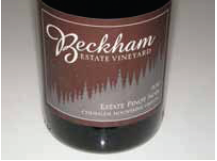 2012 Beckham Estate Chehalem Mountains Oregon Pinot Noir 13.9% alc., 225 cases, $30. Contains all four clones from the estate vineyard. 100% de-stemmed and whole berry fermented. Aged 15 months in 40% new French oak. · Moderately dark reddish purple color in the glass. The vibrant nose picks up intensity and nuance over time in the glass, offering a rainbow of aromas including black cherry, ripe strawberry, black raspberry, spice and rose. Delicious well-sustained attack of black cherry fruit accented with clove and cola, carrying over to a magnificent finish of impressive fruit concentration. Very smooth in the mouth with the structure to age many years. This wine has a racy personality. Score: 94
2012 Beckham Estate Dow’s Chehalem Mountains Oregon Pinot Noir $40. Fall release. Not tasted, but expect big things.
2013 Beckham Estate Olivia’s Rosé of Pinot Noir 13.5% alc., 60 cases, $18. Released January 22, 2014. Nearly sold out. Named for the family’s youngest daughter. Dijon 115 and Pommard grown especially for this wine. Fermented in neutral French oak. No malolactic fermentation. · Pinkish red color and clear in the glass. Lovely aromas of fresh strawberry, watermelon and blood orange are echoed in the flavor profile. Bright and crisp with gossamer tannins. Score: 89
De Ponte CellarsI did not visit De Ponte (“Duh Pawnt”) Cellars on my recent trip to the Willamette Valley, but I tasted several recent releases at home and was so impressed I wanted to highlight the winery. Being close to more famous neighbors like Domaine Drouhin Oregon, Archery Summit and Domaine Serene, this winery flies a little bit under the radar. I have visited the vineyard and winery in the past as part of the International Pinot Noir Celebration. Scott and Rae Baldwin acquired their Dundee Hills property in 1999 and started this small family winery in 2001, naming the winery after Baldwin’s grandfather, Manuel de Ponte, who grew grapes and made wine in California’s San Joaquin Valley. The Baldwins are immigrants from California where they owned a walnut orchard in the Central Valley and lived in Carmel Valley. The De Ponte estate vineyard is planted to 20 acres of Dijon clone Pinot Noir and 2 acres of Melon de Bourgogne. The Melon grape has sparse plantings in the United States and was a mistake. The original growers thought they were planting Pinot Blanc grapes but it turned out to be Melon de Bourgogne, identical to the grape used in the Muscadet from the Loire Valley of France. The wine has turned out to be very popular.
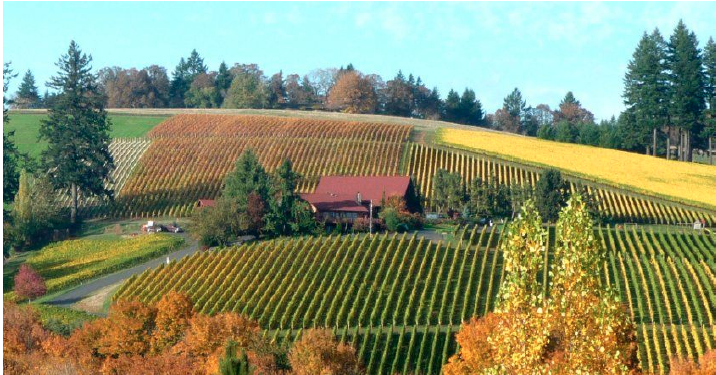 In 2007, the Baldwins bought 80 acres with an existing 6-acre Pinot Noir (667 and 777) vineyard on the western edge of the Yamhill-Carlton AVA. Named Lonesome Rock Ranch, another 2 acres of Pinot Noir were planted in 2010. This site is exposed to more weather extremes than the De Ponte Vineyard. The soils are rich, red volcanic Jory in type. The vineyard does not lie within the Yamhill-Carlton AVA boundaries, situated two miles to the west of the Yamhill-Carlton AVA border line and one of only three other vineyards within the Willamette Valley that are closer to the Pacific Ocean. A herd of steers roam on the property, graze on grass, and are fed pomace left over from De Ponte’s winemaking process. The beef is sold under the Lonesome Rock Cattle Company brand (wine club members only). The talented winemaker is Parisian-born Isabelle Dutarte who studied at the University of Bourgogne and has made wine professionally for well over 30 years. Her impressive resume includes winemaking stints like Maison Joseph Drouhin before she moved to Oregon in 1993 to assist the Drouhin family with Domaine Drouhin Oregon. Her mentor at Maison Joseph Drouhin was Laurence Jobard, the head winemaker with whom she worked for ten years. She became the head winemaker at De Ponte Cellars in 2001, moving permanently to the Yamhill Valley five years later. Shortly after, she also founded her own label, 1789 wines. The winery has two tasting rooms. The original winery tasting room is located in the heart of the Dundee Hills at 17545 Archery Summit Road and is open daily. The newest tasting room is located in historic Carlton just off Main Street and is housed in an old firehouse. Known as the Lonesome Rock Firehouse, it is open for tasting Friday through Sunday 12:00-5:00. The website is www.depontecellars.com. The 3-bedroom De Ponte Cellars Vineyard Retreat, located on the property with views of the Willamette Valley and Mount Hood is available for rent. A concierge can be arranged and a chef provided to prepare meals. The 2,000 bottle De Ponte library wine and international wine list is available to guests.
2012 De Ponte Cellars D.F.B. Dundee Hills Willamette Valley Melon de Bourgogne 13.0% alc., $25. Old vines planted almost 40 years ago. D.F.B. = D. Fred Baldwin. · Very light pale yellow and clear. The nose is pleasing with aromas of citrus including pineapple, and hints of marzipan and banana cream. Crisp, bright and juicy, with flavors of citrus, apple and peach backed by lively acidity, carrying over to the tight finish. Score: 88
2010 De Ponte Cellars Estate Dundee Hills Willamette Valley Pinot Noir 13.5% alc., $55. Sourced from the best blocks in the vineyard. · Medium reddish purple color in the glass. An elegant wine with soft tannins, offering aromas and flavors of red cherry, cranberry, baking spice, sarsasparilla and oak. There is a generous oak sheen expressed as notes of toast and espresso. Juicy with a good grip of backing acidity. Score: 90
2011 De Ponte Cellars Estate Dundee Hills Willamette Valley Pinot Noir 13.5% alc., $55. · Moderately light garnet color in the glass. Nicely perfumed with bright aromas of strawberry, cherry and raspberry coulis. Lighter in color than the 2010 vintage Estate bottling, but brighter and more tantalizing with a crisp expression of red fruit. The tannins are nicely integrated, the oak is complimentary, and the finish is refreshingly crisp. A wine of great finesse, charm and harmony. Score: 94
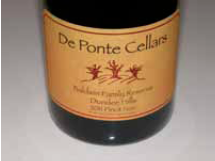 2011 De Ponte Cellars Baldwin Family Reserve Dundee Hills Willamette Valley Pinot Noir 13.4% alc., $70. A winemaker selection of full-bodied and complex barrels in the cellar. Limited production. · Moderately light garnet color in the glass. The nose envelopes your senses with aromas of red cherry, raspberry and exotic spices that reveal themselves gradually in the glass over time. Superlatives can hardly due justice to this wine which is extraordinary in every way. It is polished, balanced, elegant and hi-collared, with a delicious core of vivid cherry, raspberry and spice flavors, a caressing texture, and remarkable persistence on the finish. This wine seduces with charm, not power. A connoisseur's wine that will age beautifully. Score: 96
 2011 De Ponte Cellars Lonesome Rock Reserve Willamette Valley Pinot Noir 13.4% alc., $44. “Proud to be Lonesome” is a tagline on the label. · Moderate reddish purple color in the glass. Still a little shy at this stage, but that is my only nit. Soaring scents of dark raspberry, blackberry, plum, cardamom spice and oak. Very intriguing. Delicious array of darker, spiced berry and stone fruits with an earthy undertone. The tannins are evident but supple, and the finish invites another sip. Can be enjoyed now, but there is no hurry. Score: 93
Youngberg Hill Vineyards & InnYoungberg Hill Vineyards & Inn consists of 21 acres of vineyards on a 50-acre hilltop property with panoramic views of the Willamette Valley. Located in the McMinnville AVA, the first 12 acres of Pinot Noir were planted in 1989 on two distinct blocks of southeast facing slopes. The vines are own rooted Pommard and Wädenswil clones. 4 additional acres of clone 777 was planted on 101-14 rootstock in 2008. There are also 5 acres of Pinot Gris planted in 2006. The 6.6-acre Natasha Block is located at about 600-675 feet elevation on Willakenzie soil (sedimentary). The 4.5-acre Jordan Block is higher at 750-800 feet and steeper, and is planted on Steiwer (volcanic) soil. This block is benefits more from coastal breezes, is cooler, and harvested later. The Natasha and Jordan Blocks were planted in 1989 and already in production when the Bailey family bought the property. The Camelot Block, planted in 2008 by the Bailey family, is dedicated to Dijon clone 777. It is located between the Natasha and Jordan Blocks and is a blend of the two soils. The Youngberg Hill Vineyard is located in the western reaches of the McMinnville AVA, only 25 miles inland from the Pacific Coast as the crow flies. The weather is most heavily influenced by the maritime influence from the Van Duzer Corridor. The vineyard receives more precipitation than most of the Willamette Valley, more sunny days, and cooler temperatures both day and night. Cool, coastal winds gently blow in the late afternoon and early evening reducing disease pressure. The vineyard is farmed organically and is LIVE and Salmon Safe certified, with some biodynamic practices in place. The vines are not irrigated. The Bailey family acquired Youngberg Hill in 2003 and renovated and upgraded the entire estate, with improved vineyard management and winemaking, expansion of the Inn, a new tasting room in the inn, and markedly improved hospitality. The house features 8 modernized guest rooms.
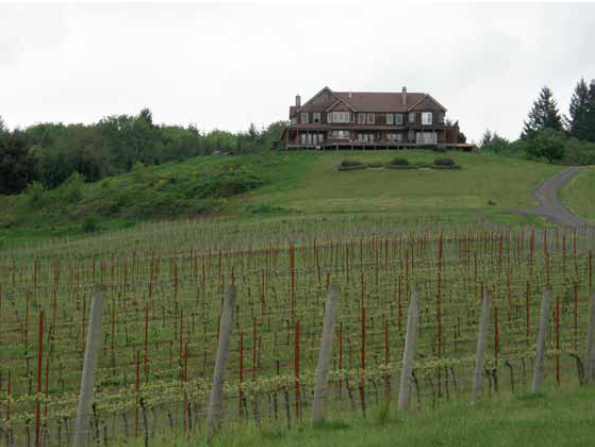 Proprietor Wayne Bailey was a mechanical engineer who initially pursued a career in the food and beverage industry as a consultant. He became enamored with wine and turned his career eventually to the wine industry. He went to France on a short term consulting job for a domaine in Burgundy that wanted to export wine to the United States. He fell in love with Pinot Noir, became friends with many of the local vignerons, decided to stay in Burgundy, and worked two vintages. After his stint in Burgundy, he knew he wanted to grow Pinot Noir in a cool climate and Oregon was a natural choice. He bought Youngberg Hill and beginning in 2003 worked with the late winemaker Jimi Brooks who was the winemaker and vineyard manager at nearby Maysara Vineyards at the time. Brooks helped Bailey institute organic and later biodynamic farming at Youngberg Hill Vineyard. The wines are crafted in a shared facility by Youngberg Hill owner and winemaker Wayne Bailey, along with noted winemaker Robert Brittan acting as the consulting winemaker. Grapes are 100% de-stemmed, undergo a 3 to 5-day cold soak, are fermented with natural and proprietary yeasts, and aged typically 14-16 months in 28-30% new French oak barrels. The informative website at www.youngberghill.com offers the wines for sale. The tasting room in the inn is open 10:00-4:00 daily. The best idea is to check into the Inn for a few days and taste the authentic wines while you enjoy the ambiance. The Bailey family is posed below.
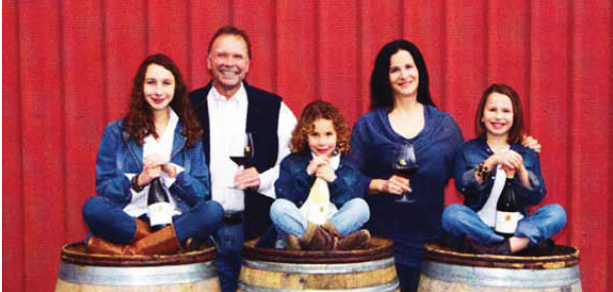
2010 Youngberg Hill Barrel Select McMinnville Oregon Pinot Noir 12.9% alc., 92 cases, $60. Released May 2014. 4 barrels from Jordan Block. · Moderately light reddish purple color in the glass. Highly aromatic with attention getting aromas of cherry, spice, nutmeg and other exotic spices. Very smooth and polished on the palate with refined tannins, offering a delicious core of cherry and plum fruit accented with brown spice and a hint of tobacco. An aged wine at the peak of its charms. Score: 93
2011 Youngberg Hill Cuvée Willamette Valley Oregon Pinot Noir 12.2% alc., pH 3.6, 218 cases, $30, screwcap. Sedimentary and volcanic soils. Estate Pommard, Wädenswil and 777 clones. · Moderately light reddish purple color in the glass. Aromas of cherry, cranberry, spice and balsam lead to a lighter weight wine with bright flavors of red cherry and cranberry accented with a hint of herbs. The tannins are supple and the finish is cherry-driven. Score: 89
2011 Youngberg Hill Natasha McMinnville Oregon Pinot Noir 11.5% alc., pH 3.70, 327 cases, $40, screwcap. 40% Wädenswil and 60% Pommard, 23-year-old vines. Harvest Brix 21.8º. · Moderately light reddish purple color in the glass. The aromas and flavors are driven by red cherry and raspberry fruits with savory herbs in the background. Light in concentration, with the balance tilted toward firm tannins which stick out a bit on the dry finish. Score: 88
 2011 Youngberg Hill Jordan McMinnville Oregon Pinot Noir 12.0% alc., pH 3.60, 297 cases, $40, screwcap. 60% Pommard and 40% Wädenswil, 23-year-old vines. Harvest Brix 21.9º. · Moderately light reddish purple color in the glass. Nicely perfumed with bright aromas of cherries, spice box, incense and peat. Light to mid weight flavors of fresh cherry with a streak of herbs in the background. Juicy and vivid with a riff of flinty minerality running through and impressive intensity in this vintage. Score: 92
2012 Youngberg Hill Cuvée McMinnville Oregon Pinot Noir 14.5% alc., 298 cases, $35, screwcap. Some 777 clone fruit sourced from Bjornson (Eola-Amity Hills) and Hyland (McMinnville) vineyards as well as Youngberg Estate Camelot Block. 100% 777 clone. · Moderate reddish purple color in the glass. Appealing aromas of black cherry and raspberry with a hint of chocolate. Discreetly concentrated core of tasty black cherry and black raspberry fruits with a touch of spice. Nicely balanced tannins and bright acidity with a lengthy, sappy finish. Score: 91
2012 Youngberg Hill Natasha McMinnville Oregon Pinot Noir 13.8% alc., 137 cases, $45, screwcap. Pommard and Wädenswil clones. · Moderately dark reddish purple color in the glass. Very charming with an earth-kissed black cherry core. Plenty of spice livens the palate. Mid to full-bodied with a firm backbone of tannin and a long finish of impressive intensity. Score: 92
2012 Youngberg Hill Jordan McMinnville Oregon Pinot Noir 13.4% alc., 300 cases, $45, screwcap. · Moderately dark reddish purple color in the glass. This is an inviting wine that has plenty of structure to last. Aromas of black cherry, rose petal and nutty oak lead to a full-bodied palate of spicy black cherry and dark raspberry fruits. A little earthy undertone adds interest. Very intensely flavored, yet vibrant due to a lively cut of underlying acidity. The black cherry goodness seems to last forever on the finish. Score: 93
Van Duzer VineyardsVan Duzer Vineyards is named after the Van Duzer Corridor, the only break in the north-south Oregon Coast Mountain Range that allows gentle west winds to enter the Willamette Valley. The official name is “Henry B. Van Duzer Forest State Scenic Corridor.” This geographic feature is responsible for the summer cooling that makes the Willamette Valley a perfect haven for Pinot Noir. Cool Pacific Ocean air follows this route late each day and temperatures dependably drop late each afternoon. This air exchange brings a significant decrease in temperature as it moves over the Van Duzer Vineyards and then splits north towards Portland and south towards Eugene, cooling off the 60-mile wide and 100-mile long Willamette Valley for the night. The influence of the Van Duzer Corridor is most felt in the McMinnville and Eola- Amity Hills appellations as well as the vineyards in the Dallas area of the Willamette Valley where Van Duzer is located. Van Duzer Vineyards is 60 miles south of Portland and west of the Eola Hills and Salem in the eastern mouth of the Van Duzer Corridor three miles off Highway 99W. Because of this location, summer temperatures in the vineyard drop sooner in the afternoon than in the vineyards to the north or south by 13 degrees, resulting in extended hang time. The winery appropriately chose Zephyra, the gentle west wind goddess of Greek mythology, to grace its label.
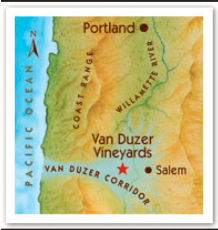 Carl Thoma and his wife Marilynn bought the run-down Van Duzer Vineyards property in 1998, and like so many Oregon wineries before, Van Duzer benefited from an enthusiastic outside investor. Vineyard plantings and management were upgraded and new plantings added. Today, the estate vineyards total 82 acres and include Pommard, Wädenswil, 113, 115, 667 and 777 Pinot Noir clones. Two clones of Pinot Gris are also planted. The estate vineyards are certified LIVE and Salmon Safe. Refer to the vineyard map below for a detailed layout. Van Duzer produces an estate Pinot Noir and a number of limited production Clone and Block Designates as well as an outstanding Rosé of Pinot Noir and a Pinot Gris. For years all Van Duzer wines were estate grown but recently grapes have been sourced from other appellations for singular bottlings. The winemaker is Florent-Pierre “Flo” Merlier a native of Burgundy who obtained a degree in physics and chemistry, but was captivated by winemaking while assisting a good friend run a 40-acre family domaine in Burgundy. He decided to pursue winemaking and met his wife, Krista, an Oregonian, while interning at the same winery in Burgundy. Florent then obtained his Diploma of Viticulture from the University of Dijon before relocating to Oregon in 2009. Winemaking can be complicated at Van Duzer because the fruit from each vineyard is handled separately and even grapes harvested within the same block are processed individually if picked on different days. Florent may have to deal with upwards of 50 lots of wine. Various yeast cultures are used to enhance aroma, flavor, texture, acid and tannin levels. A mix of barrels is used, typically tight-grained French oak barrels from the Allier and Vosges forests. Aging of Pinot Noir is carried out typically for 10 months in about 35% new barrels. The 2012 Pinot Noirs have not been released because Florent prefers to age them for a year in bottle before release.
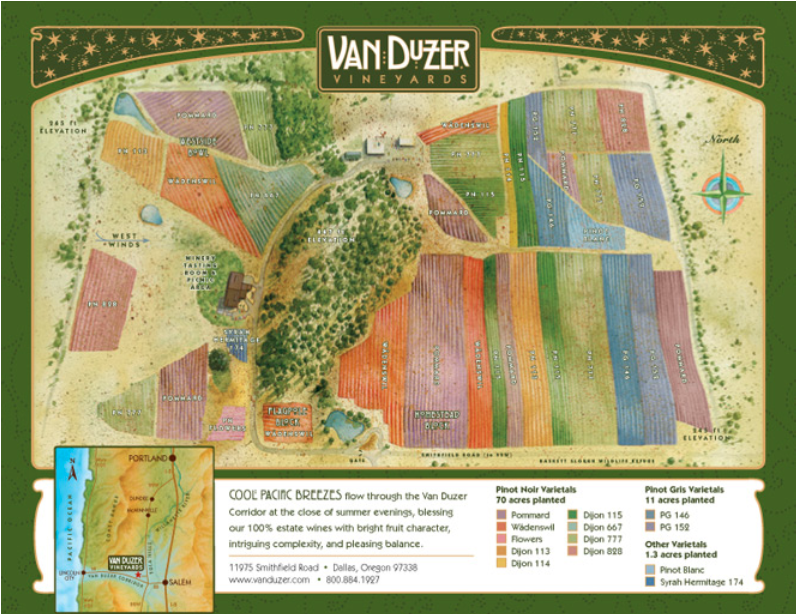 A unique, insulated concrete tilt-up structured 20,000-case winery and hospitality center was completed in time for the 2006 harvest.
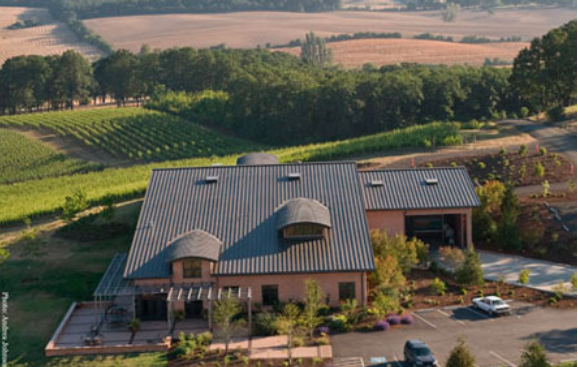 The Van Duzer Hospitality Center at 11975 Smithfield Rd in Dallas is open for wine tasting daily from 11:00 to 5:00. Visit the website at www.vanduzer.com for the 20 mile drive south of McMinnville. The 2013 Van Duzer Pinot Noir Rosé was one of the best Rosés I have tasted recently. Join Van Duzer Vineyards and 25 other Willamette Valley wineries for a festival in honor of Rosé at Patton Valley Vineyard in Gaston, Oregon. Food prepared by Portland’s Crown Paella and Scoop, music of two live bands, and a sampling of the finest pinks the Willamette Valley has to offer. Saturday, July 12, 12:00-4:00. For tickets, visit www.pattonvalley.com.
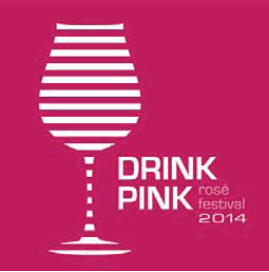
 2011 Van Duzer Estate Willamette Valley Pinot Noir 12.9% alc., pH 3.62, TA 0.58, 5,686 cases, $32. 22% Pommard, 20% 777, 19% Wädenswil, 12% 115, 9% 667, 8% 113, and 1% 114. Released January 2014. · Moderately light reddish purple color in the glass. Aromas of red cherry, ripe strawberry, rose petal, spice and toasty oak. Light in weight and delicate on the palate, but with a pleasing core of red cherry, blueberry and raspberry fruits backed by complimentary oak notes. Not a blockbuster by any means, but demure and pleasing with juicy acidity, balanced tannins, and some finishing goodness. Admirable effort in this vintage. Score: 90
2011 Van Duzer Flagpole Block Willamette Valley Pinot Noir 13.5% alc., pH 3.61, TA 0.60, 123 cases, $55. 100% own-rooted Wädenswil planted in the early 1980s. A Wine Club selection. · Moderately light reddish purple color in the glass. The aromas of black cherry, strawberry, spice and cedary oak are fulfilling. Mid weight flavors of darker berries and sweet plum are underlain with a bright cut of acidity. Some grainy tannins show up on the dry, citrus-driven, sweet and sour finish. Score: 89
2011 Van Duzer Homestead Block Willamette Valley Pinot Noir 13.5% alc., pH 3.48, TA 0.62, 120 cases, $55. 100% Pommard clone planted own-rooted in the early 1980s. · Medium reddish purple color in the glass. Invigorating aromas of black cherries, strawberries, spice, mocha and cedary oak lead to a satisfying mid palate attack of black cherry and black raspberry fruits complimented by spice and oak. The tannins are firm but integrated, and the juicy acidity brings the fruit to a vivid finish. Score: 91
2011 Van Duzer Dijon Blocks Willamette Valley Pinot Noir 13.5% alc., pH 3.59, TA 0.61, 145 cases, $55. 50% 777, 30% 115, 20% 113, and 10% 667. Released March 2014. · Moderate reddish purple color in the glass. The aromas of cherry, strawberry, underbrush and herbs hold up nicely over time in the glass. Deep flavors of ripest strawberry and black cherry with a touch of spice. Fruit-laden but lively and bright with a charming kiss of cherry on the generous finish. Score: 90
2011 Van Duzer Saffron Fields Vineyard Yamhill-Carlton Willamette Valley Pinot Noir 13.5% alc., pH 3.78, TA 0.56, 123 cases, $60. 50% Wädenswil, 35% Pommard and 15% 115. 3rd leaf (68-acre vineyard planted in 2008). Aged in 50% new French oak barrels for 10 months. · Moderate reddish purple color in the glass. The nose is very appealing, with bright aromas of cherry pie glaze, spice and sandalwood. Delicious array of darker berry and stone fruits, nicely spiced and caressed by slightly grippy tannins. The seductive fruit appears to have reached good phenolic maturity in the cool vintage. Luscious and charming. Score: 92
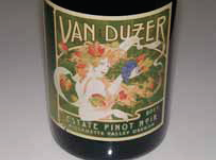 2011 Van Duzer Alchemy Willamette Valley Pinot Noir 13.5% alc., pH 3.58, TA 0.60, 70 cases, $65. A barrel selection of wines with the most complex and intense fruit characteristics. 66% Van Duzer Vineyards (Flagpole and Homestead Blocks) and 33% Saffron Fields Vineyards. 50% Pommard, 30% 114, 20% 115. Aged in 33% new French oak barrels. · Moderate reddish purple color in the glass. Uplifting aromas of Bing cherry, alpine strawberry, baking spice and sandalwood. Mid to full-bodied sweet and sappy core of black cherry, black raspberry and black plum fruits accented with the right touch of oak. An impressive offering with impeccable balance that will reward cellaring. Score: 94
2013 Van Duzer Estate Willamette Valley Pinot Noir Rosé 13.1% alc., pH 3.42, TA 0.64, 1,960 cases, $18, screwcap. Released June 2014 (sold out except Wine Club members). 63% Wädenswil and 37% 115. 100% estate grown. A rigorous block selection was used to create this wine. Selected vines were encouraged to produced a higher yield to retain acidity. An early pick of clone 115 and a later pick of Wädenswil clone were blended. This Rosé, like few others, is intentionally created through directives in the vineyard and winery to produce a distinctive wine. After gentle pressing, the juice was inoculated with four yeasts to highlight the aromas and mouthfeel. After a slow and cold fermentation in stainless steel tanks, the wine was aged on lees. · The color is an enticing modest orange coral in the glass. I loved the aromas of strawberry, blood orange and cut flower bouquet. This wine offers everything you could want in a Rosé with fresh flavors of strawberries, raspberries, orange zest, a hint of herbs in the background, a creamy mouthfeel and bright citrus-infused acidity. This dry wine is extremely agreeable to drink and unusually provocative for a Rosé. Score: 93
2013 Van Duzer Estate Willamette Valley Pinot Gris 13.2% alc., pH 3.23, TA 0.74, 2,100 cases, $18, screwcap. Released April 2014. Clones 146 and 152. Whole cluster pressed, slow and cold fermentation in stainless steel tanks and aged on lees. · Pale yellow color and clear in the glass. The nose is really captivating with effusive aromas of peach, melon and mango. Crisp, light and refreshing, with a mix of tropical fruit, pear, and peach flavors that are vivid. Slightly creamy on the palate with a stony minerality in the background, and a thirst-quenching finish. A superb food wine. Score: 92
Seven of Hearts/Luminous HillsByron and Dana Dooley own Luminous Hills Vineyard, a unique 12-acre, high elevation site in the southwestern corner of the Yamhill-Carlton District. The vineyard contains both sedimentary (65%) and Jory volcanic soils (35%), with clones planted to match the different soil types. There are six different blocks containing Dijon clones 115, 667, 777 and Pommard clone. The vineyard is sustainably farm, certified LIVE and Salmon Safe, and non-irrigated. When I recently visited the vineyard on a sunny afternoon, Byron told me that his property was part of 30 acres owned from 1978 to 1985 by Steve Jobs, the co-founder of Apple. Coincidently, both Dooleys attended the same high school as Jobs, Homestead High School in Sunnyvale, California. The Luminous Hills Vineyard is beautifully manicured and breathtakingly beautiful. I would even go so far to say it is the most stunning Pinot Noir vineyard I have ever seen. As I walked the vineyard with Byron, I was taken by the many vistas on the undulating property and the serenity of the site. The red thistle grown in alternate rows as a cover crop was in bloom, creating a palate of color between the vines. Even Byron was touched by the scene that day and both of us shot many photographs.
 In 2000, the Dooleys sold their house when the internet bubble burst in 2000, left their Silicon Valley jobs, and moved to Napa Valley’s Howell Mountain. Byron earned a viticulture and winemaking degree at Napa Valley College, interned at Williams Selyem, and made his own Bordeaux-style wine from Napa Valley fruit. In 2004, after Dooley graduated, the couple bought a property in the Yamhill-Carlton District and developed Luminous Hills Vineyard. Dana opened Honest Chocolates in McMinnville, selling traditional style chocolates, and later opened another branch in Carlton which shares space with the Seven of Hearts tasting room. Luminous Hills wines are poured at the Seven of Hearts Wine Center in Carlton. Seven of Hearts Wine is the Luminous Hills companion label featuring multiple varietals made from sourced grapes grown in several Willamette Valley and neighboring regions. Two additional sub-labels of Seven of Hearts, are Chatte d’Avignon, a lineup of Rhone varietals, and Chateaux Figareux, a number of Bordeux varietals. The inaugural vintage for Luminous Hills wines was 2008. The label on the Seven of Hearts wines has neo-classical elements, symbolizing the Dooleys’ passion for the traditional Burgundian style of Pinot Noir. Seven of Hearts wines and Luminous Hills wines are sold on the respective websites: www.sevenofheartswine, www.luminoushills.com. The Seven of Hearts wines are well-crafted and easy to like, while the Luminous Hills Pinot Noirs are very special expressions of one site. The following wines were tasted with Byron at the Seven of Hearts Wine Center in Carlton. Byron noted that 2013 was “crazy,” in that the summer was hot, ripening was progressing normally, and then a big rain event occurred at the end of September. The 2013 wines here were made from grapes that were mostly picked after the rain. Luminous Hills is a late ripening site and benefited in this vintage because the grapes were able to hang past the heavy late September rains without damage to or dilution of the fruit.
2013 Seven of Hearts Willamette Valley Rosé of Pinot Noir 14.2% alc., pH 3.44, TA 0.72, RS 0.157%, 126 cases, $15. Grapes sourced from Luminous Hills Vineyard (Pommard) and Armstrong Vineyard in the Ribbon Ridge AVA (Wädenswil and 777). Blocks were farmed specifically for Rosé, macerated for 8 days at a cold temperature, then pressed off and fermented in neutral French oak barrels where the wine was aged for 6 months before bottling. · Moderate reddish pink color in the glass. A pleasing wine with aromas and flavors of strawberry, cherry and blood orange. Bright and refreshing with enough body to stand up to more substantial foods. Score: 87
2013 Luminous Hills Aura, Estate Grown, Yamhill-Carlton District Rosé of Pinot Noir 13.5% alc., pH 3.43, TA 0.73, RS 0.134%. 49 cases, $28. 70% Pommard and 30% 667 clones. Produced from blocks that are farmed for Rosé. Aged 6 months in neutral French oak barrels. · Moderate reddish pink color in the glass. A more substantial wine with additional complexity and lift on the finish. The aromas and flavors of wild cherry and strawberry are sprinkled with savory herbs and a hint of spice. Score: 89
2012 Seven of Hearts Willamette Valley Pinot Noir 13.6% alc., pH 3.58, TA 0.59, 756 cases, $20. A blend from all five Willamette Valley vineyards the winery works with and includes five different Willamette Valley appellations. Native yeast fermentation, 25% whole cluster, no additions. · Moderately light garnet color in the glass. Shy aromas of fresh cherry lead to a mid weight essence of spiced red cherry accented with a whisper of oak. The tannins are supportive without being intrusive and the finish is bright and fruity. Score: 88
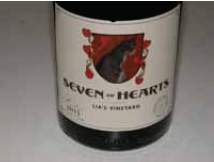 2012 Seven of Hearts Lia’s Vineyard Chehalem Mountains Willamette Valley Pinot Noir 13.1% alc., pH 3.62, TA 0.59, 126 cases, $35. Pommard, Wädenswil, Mariafeld, 115 and “828.” Jory volcanic soil. No whole cluster. · Moderately light reddish purple color in the glass. The nose is rich with hi-tone aromas of dark red cherries and berries. Sleek and seductive on the palate, with a charge of cherry, raspberry and red plum flavors carrying over to a persistent aromatic finish. This wine has good presence without weight and impressive harmony. Score: 91
2012 Seven of Hearts Bjornson Vineyard Eola-Amity Hills Willamette Valley Pinot Noir 13.0% alc., pH 3.43, TA 0.64, 73 cases, $25. Vineyard is adjacent Seven Springs Vineyard. Two-thirds Pommard and one-third 777. · Moderately light reddish purple color in the glass. Tenacious aromas of cranberry and black cherry. More body and intensity, with layers of flavor including cranberry, cherry, spice and chocolate. Very forward, with a long, assertive finish. Score: 91
2012 Seven of Hearts Durant Vineyard Dundee Hills Willamette Valley Pinot Noir 13.0% alc., pH 3.66, TA 0.65, 112 cases, $35. One of the oldest vineyards this winery works with including the 41-year-old Pommard Bishop Block. Dijon 114 and 115 also. 50% of blend co-fermented. 56% whole cluster fermented. · Moderately light reddish purple hue in the glass. Beguiling scents of cherry, spice and rose petal. Very suave and seductive with a juicy and bright wild cherry core brought into focus with lively citric acidity. Well-structured for aging, but the tannins are not astringent. Rolls off the palate like a satin sheet at the finish with layers of flavor returning for an encore. Score: 93
2012 Seven of Hearts Armstrong Vineyard Ribbon Ridge Willamette Valley Pinot Noir 13.7% alc., pH 3.60, TA 0.62, 147 cases, $35. Willakenzie soils. Pommard, 777, 667, and Wädenswil. A barrel selection. 33% whole cluster fermented. · Moderately light reddish purple color in the glass. Not as giving at this stage as some of the other wines with the earth-kissed, red cherry and strawberry fruit slightly compressed in the tannins. A hint of floral perfume, spice and vanilla add interest. A young wine with potential. Score: 90
2012 Seven of Hearts Curmudgeon Cuvée Armstrong Vineyard Ribbon Ridge Willamette Valley Pinot Noir 13.3% alc., pH 3.62, TA 0.59, 49 cases, $35. This wine honors the memory of wine curmudgeon, Bob Wood. This wine is designed to be a wine Bob would like and one that would age to allow him to be toasted year after year. Clones 114, 777 and Pommard. 100% whole cluster fermented. Aged in 100% neutral French oak. · Moderately light reddish purple hue in the glass. Aromas of red cherry, spice, rose petal and cedar elevate from the glass. More structured with mid weight flavors of cherry, ripe strawberry, exotic spice, cedar and edible flower. Impressive intensity and length on the bright finish. Score: 91
2012 Luminous Hills Estate Grown Yamhill-Carlton Willamette Valley Pinot Noir 13.0% alc., pH 3.67, TA 0.65, 427 cases, $35. The “silver label” Luminous Hills blend includes clones 115, 667, 777 and Pommard. 33% whole cluster fermented. This blend is the big picture view of Luminous Hills Vineyard. 33% whole cluster fermented. · Intensely aromatic with effusive aromas of darker cherries and blueberries with a hint of spice. Juicy attack of anise-laced raspberry and blueberry fruit caressed by suave tannins. The intensity of fruit flavor is striking. Score: 92
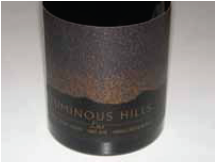 2012 Luminous Hill LUX Estate Grown Yamhill-Carlton Willamette Valley Pinot Noir 13.1% alc., pH 3.64, TA 0.63, 147 cases, $42. Select lots of Pommard (two-thirds) and 777 (one-third). 33% whole cluster fermented. Medium reddish purple hue in the glass. · Aromas of fresh Bing cherry, dried rose and peppery spice. Mid weight flavors of black raspberry, black cherry and baking spice with a hint of dark chocolate. Slightly earthy, with a healthy tannic backbone and bright citric acidity. More structured than the regular Luminous Hills bottling, with a somewhat longer and more generous finish. Score: 93
2012 Seven of Hearts Special Reserve Willamette Valley Pinot Noir 13.5% alc., pH 3.56, TA 0.59, 147 cases, $45. This wine includes fruit from four vineyards in different appellations. A barrel selection. Clones are Pommard, 115, 777 and “828.” At least 40% whole cluster fermented. Aged in 33% new French oak. · Moderate reddish purple color in the glass. Pleasing aromas of fresh red berries lead to a panoply of strawberry, raspberry and spice flavors that fill the mouth with goodness. Impressive fullness and length. The tannins are evident but are broad, ripe and supportive. The berry fruit returns in waves on the wonderful finish. A special wine with potential. Score: 94
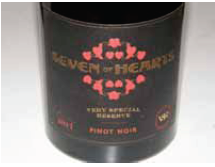 2012 Seven of Hearts Very Special Reserve Willamette Valley Pinot Noir 13.0% alc., pH 3.57, TA 0.59, 126 cases, $75. This wine is only made in very special vintages. From Luminous Hills, Armstrong, Lia’s and Durant vineyards. 33% whole cluster fermented. Aged in 23% new French oak. · Moderately light reddish purple color in the glass. Moderately light reddish purple color in the glass. Extroverted nose offering aromas of wild berries and exotic spices. Forceful and assertive on the palate, yet elegant, with a perfectly ripened core of berry fruit still mildly compressed by tannins. Similar to the Special Reserve, but more aloof at this stage. An ethereal wine that oozes pinotosity. Score: 95
2009 Luminous Hills ASTRA Yamhill-Carlton Willamette Valley Pinot Noir 15.0% alc., 98 cases. Released February, 2011. 60% 667, 40% 115. 60% whole cluster fermented. 6 week pre-maceration. · Moderately light reddish purple color in the glass. This wine has aged nicely with plenty of primary fruit character on board. Aromas of cherry and rose lead to a full-bodied wine with layers of flavor including black cherry, anise and tobacco. Nicely balanced with endless fruit on the finish. Score: 92
2012 Seven of Hearts Willamette Valley Chardonnay 14.2% alc., 329 cases, pH 3.31, TA 0.72, $24. Gran Moraine and Willakia vineyards, clones 76, 95, 96. Aged in 50% neutral French oak and 50% stainless steel. · Moderately light golden yellow color and clear in the glass. Aromas of lemon curd, crabapple, and buttered brioche are echoed on the palate with added flavors of green apple and grapefruit. Crisp with bright acidity and a lip-smacking finish. Score: 87
2012 Seven of Hearts Gran Moraine Vineyard Yamhill-Carlton Willamette Valley Chardonnay 13.3% alc., pH 3.28, TA 0.76, 73 cases, $32. Clone 76. Aged in 33% new French oak. · Light golden yellow color and clear in the glass. Very appealing aromas of lemon zest, pear and subtle oak. An acid-driven, bright wine with satisfying flavors of lemon pie filling, pear, green apple and vanilla. Slightly creamy and easy to like. An excellent food wine. Score: 90
2012 Seven of Hearts Willakia Vineyard Eola-Amity Hills Willamette Valley Chardonnay 13.1% alc., pH 3.30, TA 0.73, 73 cases, $32. Clones 95 and 96. Aged in 33% new French oak. · Very light golden yellow color and clear in the glass. The aromas and flavors of lemon pie filling, yellow apple and buttery brioche are pleasant and there is good backing acidity. Slightly creamy on the palate with a refreshing finish. Score: 88
Raptor Ridge WineryAnnie and Scott Shull founded Raptor Ridge Winery in 1995 on the northeastern side of the Chehalem Mountains, 10 miles north of Newberg. The name of the winery is derived from the many families of raptors that share the winery’s 27-acre estate. The 18-acre estate vineyard is named Tuscowallame, the indigenous words for “place where the owls dwell.” The vineyard is planted in Loess-based Laurelwood soil to Pinot Noir clones 114, 115, 667, 777, Wädenswil and Pommard. Scott is a self-taught winemaker who specializes in Pinot Noir and Pinot Gris. The winery is also one of the few to produce a Grüner Veltliner. He is very active in the Oregon wine industry, participating as a founding member of the Oregon Wine Board and currently as President of the Chehalem Mountains Winegrowers Assocation. Annie travels extensively throughout the United States to personally represent Raptor Ridge. She is President Emeritus of the Oregon Pinot Camp Board.
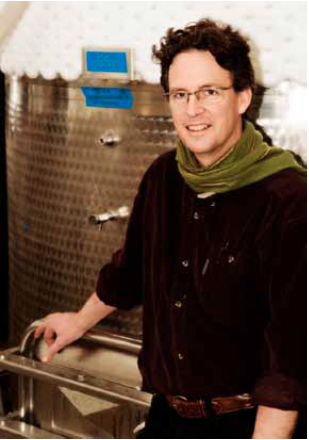 Besides production from its estate vineyard, Raptor Ridge sources wine grapes from other Willamette Valley growers including Arbre Vert, Bellevue Cross, Carabella, Gran Moraine, Harbinger, Meredith Mitchell, Olenik and Shea. Total production at Raptor Ridge is about 7,500 cases of wine each vintage. The winery’s tasting room is open seasonally and by appointment. The tasting room overlooks the vineyard and adjoining forested mountains and is quite a peaceful site to enjoy. VIP tours and tasting are available. Visit the website at www.raptorridgewinery.com. Raptor Ridge has an “Aroma Apothecary” in the tasting room, something I have never seen at a winery in all my years of travel. The Aroma Apothecary contains a set of 50 basic aromas commonly found in wine. Visitors are encouraged to take an aroma quiz and boost their tasting acumen (list of aromas below). Highly personable sommelier, Tom Champine, manages sales and marketing for the winery and you are likely to see him if you visit. When I visited recently on a glorious sunny morning, I toured the winery with Scott and sampled a few of the winery’s new releases. I did not do a formal sit-down tasting so I can only report some general, yet favorable, impressions.
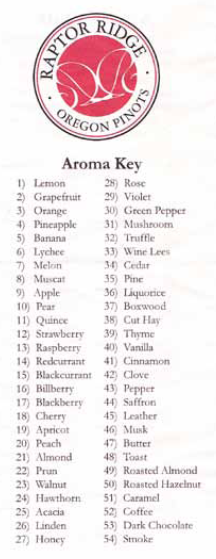
2013 Raptor Ridge Willamette Valley Pinot Gris 12.5% alc., pH 3.24, TA 0.59, <1,900 cases, $20. Sourced from several vineyards. Whole cluster pressed, slow fermentation in stainless steel tanks, gently cross-flow filtered and sterile-filtered at bottling. · Bright and clean, with crisp acidity and flavors of apple, melon, pear and citrus. Satisfying.
2013 Raptor Ridge Estate Chehalem Mountains Gruüner Veltliner 12.5% alc., pH 3.29, TA 0.56, <101 cases, $20. Whole cluster pressed, fermented with native yeasts, cold-stabilized, cross-flow and sterile filtered at bottling. · Very inspired white wine with crisp citrus flavors and a bright cut of refreshing acidity. Very unique and highly enjoyable.
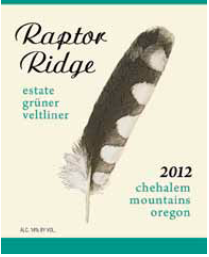
2012 Raptor Ridge Estate Vineyard Chehalem Mountains Pinot Noir 14.1% alc., pH 3.56, TA 0.50, <500 cases, $45. Includes all clones grown in the vineyard. 100% de-stemmed, 8-day cold soak, proprietary yeast inoculation, aged in 29% new French oak for 9 months. · Aromas of plum, cherry and clove spice echoed on the palate with added complimentary notes of oak. Solid.
2012 Raptor Ridge Shea Vineyard Yamhill-Carlton Pinot Noir 14.1% alc., pH 3.54, TA 0.50, <315 cases, $55 (sold out). 100% de-stemmed, inoculated with William Selyem yeast strain, fermented 12 days before pressing off skins, aged 9 months in 50% new French oak. · A special wine in this vintage with enticing aromas of black cherry, cola and sassafras. Mid weight flavors of Bing cherry, raspberry and rose hips tea. Nicely crafted and harmonious with a generous finish.
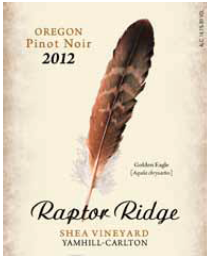 Also reviewed in the PinotFile (www.princeofpinot.com/winery/641/): 2012 Raptor Ridge Willamette Valley Pinot Noir, 2012 Raptor Ridge Gran Moraine Vineyard Yamhill-Carlton Pinot Noir and several Raptor Ridge Pinot Noirs from the 2011 vintage.
Anam Cara CellarsI recently visited Sheila Nicholas at the Anam Cara Cellars tasting room in Newberg. I have written extensively in the PinotFile about this winery: www.princeofpinot.com/winery/268/. The winery has had several winemakers through the years, but owners Sheila and Nick have had considerable input and the style, although changed in subtle ways through the years, has never wavered. The current winemaker is Michael Collins who crafts the wines at 12th & Maple Winery in Dundee. All wines, including Pinot Noir, Chardonnay, Riesling and Gewürztraminer, are estate grown. The website is www.anamcaracellars.com.
 The 2012 Pinot Noirs tasted here will be released in the late fall of 2014 except for the Mark VII which will be held back until next year. These wines are among the very best I have tasted from this winery. Scary to think they were bottled in February 2014 and will only get better over the ensuing months in bottle.
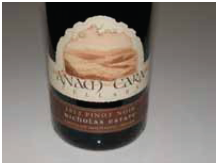 2012 Anam Cara Cellars Nicholas Estate Chehalem Mountains Pinot Noir 14.2% alc., 1,700 cases, $33. 20% 114, 20% 115, 20% 777, 10% 114 and 10% 667. Aged in 21% new French oak. · Moderately light reddish purple color in the glass. Lovely aromas of fresh cherry coulis and sandalwood. Delicious array of mid weight fruit flavors including black cherry and black raspberry with plenty of spice and a graceful oak sheen. Impressive harmony with remarkable persistence on the royal finish. Score: 94
2012 Anam Cara Cellars Nicholas Estate Reserve Chehalem Mountains Pinot Noir 14.2% alc., 420 cases, $46. 30% Pommard, 30% 777, 20% 115, 10% 114 and 10% 667. Aged in 37% new and 29% once-filled French oak. · Moderately light reddish purple color in the glass. The nose invigorates with effusive aromas of fresh cherries, spice and dark red rose petals. Bright and elegant on the palate, with a pleasing core of cherry fruit accented with hints of brown spice and white chocolate. The suave tannins are nicely integrated, the texture is silky, and the finish is clean and refreshing. Score: 94
2012 Anam Cara Cellars Nicholas Estate Wädenswil Chehalem Mountains Pinot Noir 14.2% alc., 95 cases, $55. 100% Wädenswil clone. Aged in 25% new and 25% once-filled French oak. · Moderate reddish purple hue in the glass. The wine offers a darker fruit profile, including black cherry, blackberry along side flavors of cola, sassafras, spice and graham. All silk and satin in the mouth with firm, but integrated tannins. Definitely unique in character. Score: 93
2012 Anam Cara Cellars Nicholas Estate Heather’s Vineyard Chehalem Mountains Pinot Noir 14.2% alc., 90 cases, $66. 50% 114, 20% 777, 15% 667, and 15% 115. Aged in all once-filled French oak barrels. The most elegant expression of the vineyard which contains the most clone 114. · Moderately light reddish purple color in the glass. Seductive aromas of Bing cherry, raspberry, spice and sandalwood lead to a feminine, graceful wine with light flavors of cherry and red berries, brown spice and subtle oak. The fine-grain tannins are embracing and the cherry-laden finish is charming. Score: 92
2012 Anam Cara Cellars Nicholas Estate Mark VII Chehalem Mountains Pinot Noir 14.2% alc., 90 cases, $66. 50% Pommard and 50% 777. Aged in 50% new French oak. The only unfiltered wine in lineup. A masculine, age worthy expression of the vineyard. · Moderate reddish purple color in the glass. My notes say,“fantastic nose,” with aromas of an array of dark red fruits and exotic spices. Discreetly bold flavors of dark red cherries and berries and red plums with a hint of dark chocolate in the background. A grand wine with excellent balance and length, ending on a high note with a rush of aromatic sweet cherries. Score: 94
J.K. Carriere WinesJim Prosser, a native Oregonian, is the proprietor and winemaker of J. K. Carriere Wines, established in 1999 in the Chehalem Mountains. The winery’s name is a combination of his grandfather’s names and represents a covenant he holds with their integrity. A wasp is prominently displayed on the label and on the side of the winery, because Jim is highly allergic to wasps, and stings nearly killed him on two occasions. He carries an Epi-Pen in a holster on his belt just in case.
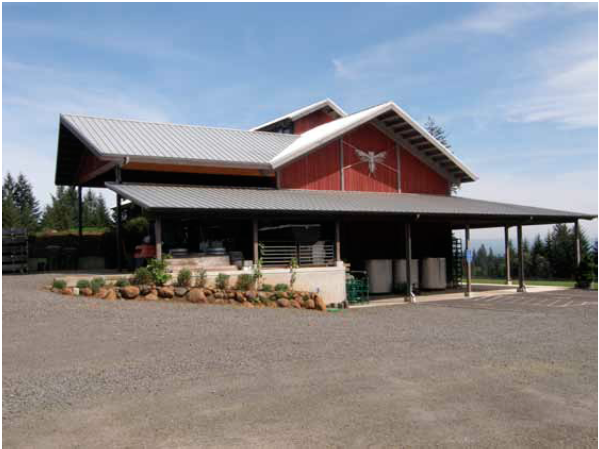 Jim has an appealing sense of humor that is best understood by viewing the videos he has posted on his website at www.jkcarriere.com. His winemaking experiences in Oregon, New Zealand, Australia and France have energized him with the desire to produce “classic” Pinot Noir that has high acid, smooth tannins, food friendliness and age ability. He uses an analogy to summarize his goal: Pinot Noir is a river of acidity with California on one bank, Oregon in the middle of the river, and Burgundy on the opposite bank. He tries to swim in the river. His wines do not shout at you, but require patience to uncover their subtlety. Jim recommends that his most serious wines be decanted the first three years. He claims the wines will easily age over ten years and I believe him. When I visited, I tasted a 2006 Vespidae that was as alive as the day it was bottled. The first ten years, Jim made wine nearby in a 100-year-old hazelnut drying barn. By 2007, he had combed every available site in the Willamette Valley looking for an appropriate property of his own. Jim finally acquired 40 acres of grape-growing land on the southeastern flank of Parrett Mountain. In 2008 and 2009 a very functional winery was built on the vineyard property as pictured above. Winemaking is very traditional with wild yeast ferments, wild malolactic fermentation, no additions, no fining and no filtering. The estate vineyard was planted initially in 2008 to non-irrigated Pommard clone Pinot Noir at an elevation of 500 to 700 feet in largely volcanic soils. Grapes have been sourced from Temperance Hill Vineyard (Eola-Amity Hills), Anderson Family Vineyards (Dundee Hills), Gemini Vineyards (Chehalem Mountains), Shea Vineyards (Yamhill-Carlton), Momtazi Vineyards (McMinnville), Black Walnut Vineyard (Dundee Hills), and Eola Hills Vineyard (Eola-Amity Hills). Some sources are bottled specially in 2 to 3-barrel lots including Shea, Anderson Family and Gemini vineyards. A majority of production is dedicated to wallet-friendly wines in the $26 to $42 bottle range (Willamette Valley blend, Vespidae, and Provocateur). A Lucidité Chardonnay and Glass White Pinot Noir are also offered. Total production is about 4,000 cases annually. The tasting room is located at the winery and is open Friday and Saturday March through November and by appointment at other times. The wines are sold through the winery’s online store and the Twelve Wine Club. Library wines and magnums are available. J.K. Carriere participates in Oregon’s Thanksgiving and Memorial weekend wine country open houses. On Thursday July 24, a pre-IPNC winemaker dinner will be held at J. K. Carriere with Jim and Allison Prosser as hosts. Visit the website for information.
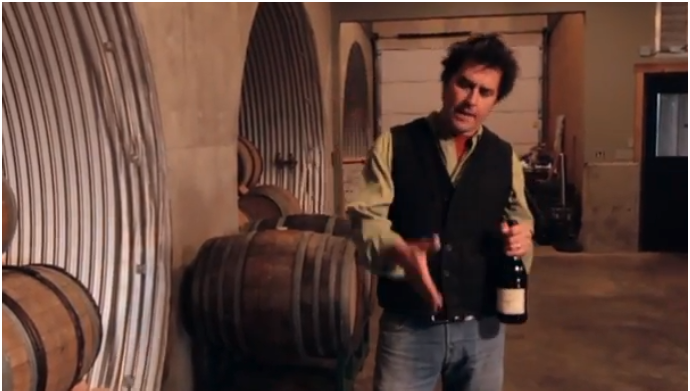
2013 J.K. Carriere Glass Willamette Valley White Pinot Noir 12.0% alc., pH 3.28, 628 cases, $24. Primarily from 33-year-old original plantings at Temperance Hill Vineyard. Whole cluster pressed and barrel fermented with wild yeast in older French oak. No residual sugar. Racked once and bottled January 2014. · Light pinkish orange color and clear in the glass. Shy, rather nondescript aroma of citrus and pencil lead. Crisp and light on the palate with subtle flavors of red cherry, orange water, peach and melon. The wine has refreshingly crisp acidity, but nothing really stands out. It is a pleasant wine, and has received good press, but I don’t get it. Score: 86
2011 J.K. Carriere Lucidité Willamette Valley Chardonnay 12.5% alc., pH 3.32, 190 cases, $32. A late growing year led to high acid and freshness. Whole cluster pressed and barrel fermented with wild yeast. 100% malolactic fermentation. Aged on lees for 18 months in older French oak barrels. Racked and filtered before bottling. · Very clean aromas and flavors of lemon, lime, green apple, and pear fueled by zippy underlying acidity. Slightly creamy on the palate with a mineral and citrus driven soprano finish. Score: 90
2012 J.K. Carriere Provocateur Williamette Valley Pinot Noir 13.5% alc., pH 3.60, 1,957 cases, $26. A blend of six vineyards. Small-lot wild yeast fermentations, aged 17 months in 12% new, 8% one-year, 7% twoyear, and 73% older French oak barrels. Racked and bottled unfined in February 2014. · A wine that strives to please with lovely aromas of cherries, rose petal and spice that are echoed on the palate that is mid weight and silky. A touch of oak adds a compliment and the finish is bright and filled with cherry goodness. Score: 91
2011 J.K. Carrier Vespidae Willamette Valley Pinot Noir 12.5% alc., pH 3.62, 891 cases, $42. Flagship wine. Vespidae is the Latin name of the family of wasps that tried to kill Jim Prosser. Sourced from Shea, Temperance Hill, Black Walnut and Gemini vineyards. Wild yeast fermentations in stainless steel, aged for 19 months in 29% new, 19% one-year, 19% two-year and 32% three-year or older French oak barrels. Bottled unfined and unfiltered in March 2013. · Plenty of concentration and noticeable finishing intensity in this wine that features a spiced cherry core accented with herbs. Easy going and food friendly. Score: 89
2011 J.K. Carrier Gemini Vineyard Willamette Valley Pinot Noir 12.5% alc., pH 3.66, 48 cases, $65. 20- year-old Scott Henry trained Pommard clone. Small lot wild yeast fermentations, aged 19 months in one-year and two-year French oak barrels. Bottled unfined and unfiltered in April 2013. · Moderate reddish purple color in the glass. The nose is shy initially, picking up interest and intensity over time in the glass. Aromas of cherries, pomegranate, spice, underbrush and oak make for an invigorating experience. Mid weight flavors of cherries and berries in a crisp, juicy style with muscular, imposing fine-grain tannins. Texturally alive with a savory herbal streak in the background and a long finish. Tasted the next day from a previously opened and decanted bottle, the wine had slowly evolved, but will still need a few years to integrate the tannins. Score: 91
2011 J.K. Carrier Anderson Family Willamette Valley Pinot Noir 12.5% alc., pH 3.78, 98 cases, $65. Sourced from dry-farmed, 21-year-old Dijon 115 clone, some of the oldest Dijon clone Pinot Noir in Oregon. Small lot wild yeast fermentation, aged 19 months in one new, one one-year, one two-year and one older French oak barrel. Bottled unfined and unfiltered in April 2013. · Moderate garnet color in the glass. The nose lacks in fruit but makes up for it in appealing aromas of tea leaves, dried herbs and smoky oak. Tasty light to mid weight array of dark red cherry and berry flavors with a subtle herbaceous riff in the background. Polished with good integration of tannins and a lean, but refreshing finish. Tasted the next day from a previously opened and decanted bottle, the wine was unchanged. Score: 90
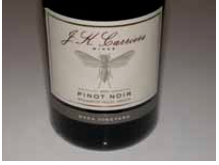 2011 J.K. Carrier Shea Vineyard Willamette Valley Pinot Noir 12.5% alc., pH 3.65, 146 cases, $65. Dijon 777 clone planted in Willakenzie soil. Small lot wild yeast fermentations, aged 19 months in one new, one one-year, one two-year and one older French oak barrel. Bottled unfined and unfiltered in April 2013. · Moderately dark reddish purple color in the glass. The nose picks up steam over time in the glass offering aromas of black cherry and black raspberry fruits. The pedigreed fruit is impressive, featuring layers of discovery including black raspberry, blueberry, pomegranate, and spice. The fruit is still compressed in firm tannins and will need a few years in the cellar to be more giving. Tasted the next day from a previously opened and decanted bottle, the wine was slightly more integrated and pleasing. Score: 92
Sips of Recently Tasted Oregon Pinot Noir & More
2012 Arterberry Maresh Maresh Vineyard Dundee Hills Willamette Valley Pinot Noir 13.2% alc., $55. From third generation Dundee Hills winemaker Jim Maresh. Vinified in a small winery at the top of Maresh Vineyard. Non-irrigated vines. Unfined and unfiltered. · Medium reddish purple color in the glass. The nose never really arrives even after extensive swirling over 2 hours. Shy scents of underbrush and seasoned oak. Moderately rich black cherry and black raspberry flavors with plenty of oak underpinning. Still sporting young fine-grain tannins and the fruit tastes a tad under ripe. There is vibrant acidity and some finishing intensity. When tasted the following day from a previously opened and re-corked bottle, the wine was about the same. I would give this wine at least another year in bottle to emerge. Score: 89
2012 Bergström Le Pré do Col Vineyard Ribbon Ridge Willamette Valley Pinot Noir 14.1% alc., $52. Vineyard is one mile west of the winery, a 16-acre estate-farmed site owned by the Hill family. Planted in 2006 to Pinot Noir and Chardonnay in marine sedimentary soils in a relatively warm microclimate. · Moderate reddish purple color in the glass. Shy fruit on the nose with plenty of spicy and tobacco-laced oak. Well-structured but not muscular, with a very tasty core of darker fruits including black cherry, plum and blackberry. The finish is most notable because of its boldness and length. The wine still displays a significant oak overlay that should integrate over time. Tasted the following day from a previously opened and re-corked bottle, the oak was less evident. Score: 90
 2012 Bergström Silice Chehalem Mountains Willamette Valley Pinot Noir 14.1% alc., $56. Sourced from a 21-acre estate-farmed vineyard contiguous to the winery owned by Joan Camp. Sedimentary hillside site that is rich in silica, situated at 400 feet elevation. · Moderate reddish purple hue in the glass. I found the nose very appealing with a complex array of scents including cherry, raspberry, cola, bark and cola. On entry, there is an explosion of dark red cherry and raspberry fruit that expands in the mouth and holds on tenaciously on the finish. Very polished with supportive oak treatment, a velvety mouth feel and admirable harmony. Score: 92
2012 Big Table Farm Willamette Valley Pinot Noir 14.1% alc., 785 cases, $40. A combination of new, once used and neutral barrels from all Pinot Noir sites. Whole cluster fermentation is the backbone of this wine. Unfined and unfiltered. · Moderate reddish purple color in the glass. Great nose with elevating aromas of ripe cherry mash, black grape preserves, and plum sauce. Good fullness with intoxicating exotic spices and a full complement of tasty black raspberry and plum fruits with a hint of Dr. Pepper, mocha java and cola. This pleasure juice is ready for current drinking. An impressive appellation wine that benefited from whole cluster fermentation in this vintage. Score: 91
 2012 Big Table Farm Pelos Sandberg Vineyard Eola-Amity Hills Pinot Noir 14.1% alc., 224 cases, $48. 30% whole cluster. Unfined and unfiltered. · Moderately dark reddish purple color in the glass. A glorious nose offers upbeat aromas of black raspberry, cherry, blueberry, spice, and espresso. This wine has more oak presence than I like initially, but the fruit intensity can take it, and the wine sheds its oak the longer it sits in the glass. Vibrant fruit flavors of well-ripened black raspberry and black cherry, nicely spiced. Similar to the Willamette Valley wine in flavor profile but more intensity, a longer finish, and a more seductively plush mouth feel. This wine grows on you, the longer you spend with it. Easily a ten year wine.5 Score: 94
2011 Cardwell Hill Cellars Reserve Willamette Valley Pinot Noir 13.2% alc., $40. Estate grown, produced and bottled. The estate vineyard is located in Philomath in the western Willamette Valley. Clones are Wädenswil, Pommard, 115 and 777. Aged 15 months in French oak barrels. · Moderate reddish purple color in the glass. A well-mannered wine with aromas of black cherry, spice and raisin leading to a juicy core of black cherry and red raspberry fruits complimented by a deft touch of oak. Nicely balanced tannins and easily accessible. The most notable feature is the intensely fruity finish that lasts and lasts. Score: 89
2011 Coeur de Terre Vineyard Estate McMinnville Willamette Valley Pinot Noir 13.3% alc., $36. · Medium reddish purple color in the glass. Perfumed with scents of raspberry, blackberry and toasted oak. Mid weight core of juicy, oak-infused black cherry and darker berry fruits. Currently showing a generous oak sheen and plenty of tannin, both of which should integrate with more time in bottle. Score: 89
 2011 Coeur de Terre Vineyard Abby’s Block McMinnville Willamette Valley Pinot Noir 13.5% alc., $65. Planted in 1999 to 9 clones and is the mother block for the rest of the vineyard plantings. · Moderately dark reddish purple hue in the glass. Rich, sumptuous nose offering an array of darker red and black stone and berry fruits with a touch of oak-driven aromas of dark chocolate and molasses. A full mouthful of well-ripened black cherry and dark berry fruit backed by prominent fine-grain tannins that keep the fruit in line. The most sap in the lineup with a generous fruit-driven finish. A little one-dimensional now, but has special potential, and will benefit from a year or two in the cellar. Score: 91
2011 Coeur de Terre Vineyard Tallulah’s Run Reserve McMinnville Willamette Valley Pinot Noir 13.5% alc., $65. From two adjacent blocks mid-slope in the vineyard with fractured siltstone and sandy loam soils. · Moderate reddish purple color in the glass. The nose is very shy and lacking in fruit, offering instead aromas of mocha, brioche and malt. Mid weight flavors of red cherry and cranberry with a touch of oak spice. Silky in texture with an uplifting and pleasing finish. The aromas haven’t arrived and the fruit seems buried like many Pinots from the 2011 vintage, so I recommend another year or two in bottle. Score: 89
2011 Coeur de Terre Vineyard Renelle’s Block McMinnville Willamette Valley Pinot Noir 13.5% alc., $65. Mid-slope with unidentified soils unique to the vineyard. · Moderate reddish purple color in the glass. Modest in weight but flavorful, with a charge of black cherry, blueberry and pomegranate fruit accented with sweet oak. Shows more polish and finesse and an appealingly tart cherry finish charged with acidity. Will benefit from another year in bottle. Score: 90
2011 Coeure de Terre Vineyard Sarah Jane’s Block McMinnville Willamette Valley Pinot Noir 13.5% alc., $65. The second block planted on the estate (from Renelle’s Block) and the largest block. Willakenzie soils. · Medium reddish purple color in the glass. This wine is awkward and not particularly appealing yet. The nose lacks fruit, offering primarily oak-driven scents. The juicy black cherry core is swallowed up in oak and tannin. The sappy fruit and length of finish indicate potential, but I would not touch this wine for another 2 years. Score: 88
2012 Coeur de Terre Vineyard Willamette Valley Oregon Pinot Noir 14.5% alc., $19, screwcap. · Moderately dark reddish purple color in the glass. Initial aromas of blackberry, plum and sweet oak tend to fade over time in the glass. Mid to full-bodied spice black plum and black raspberry fruit. Very forward and generous with a muscular tannin load. A fruit bomb with complimentary oak and an intensely fruity finish. Score: 86
2013 Coeur de Terre Vineyard McMinnville Willamette Valley Rustique Rosé 12.9% alc., $20. A saignée of estate Syrah with a touch of Riesling. · Moderate pinkish red color and clear in the glass. Aromas of strawberry, cherry and herbs echoed on the flavorful palate that is crisp and rewarding. Medium-bodied, with flavors of strawberry, cranberry, and peppery spice. Finishes with a panoply of flavors including tart cherry, raspberry, strawberry and herbs. A great summer fling. Score: 89
2011 Brittan Vineyards Gestalt Block McMinnville Willamette Valley Pinot Noir 13.1% alc., $55 (sold out). From the most exposed blocks in the vineyard so always transparent to its vintage. Primarily 115, 667 and 777. Aged 9 months in mostly new French oak barrels. · Moderately dark reddish purple color in the glass. Deeply perfumed with intriguing aromas of dark plum and berries, underbrush and wine cave. Vibrant, racy and vivid dark stone and berry fruits with an underlying tangy citric acidity. The wine finishes with a tart sweet and sour finish and a profusion of tannin. Score: 89
2012 Elk Cove La Bohémé Willamette Valley Pinot Noir 14.0% alc., $60. This is a high elevation and steep south-facing vineyard with well-drained Willakenzie soils located high above the Elk Cove property. The vineyard was planted in 1984 using cuttings from the Elk Cove Estate Vineyard. · Moderate and bright reddish purple color in the glass. Lovely perfume of black cherry, black raspberry, plum, violet, red licorice, cardamom and wood spice. Mid weight flavors of dark stone fruits and berries with complimentary oak and spice in the background. The attack is mouth filling, the fruit is bright and juicy, and the finish is rewarding. A pretty wine that was still solid the following day from a previously opened and re-corked bottle. Score: 92
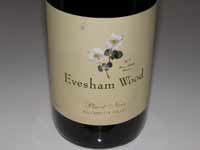 2012 Evesham Wood Willamette Valley Pinot Noir 13.0% alc., $19. Sourced from non-irrigated, organically and sustainably-farmed vineyards in the Eola-Amity Hills AVA. Aged 10 months in less than 10% new French oak. Unfiltered. · Moderate reddish purple color in the glass. Appealing scents of red rose, cherry and spice. Nicely perfumed attack of cherry, red raspberry and spice goodness caressed by well-honed tannins. Soft and smooth on the palate with some finishing length. An impressive Willamette Valley appellation bottling that is priced for everyday drinking. Score: 90
Note: Christine Andrus has revived the Gypsy Dancer label. After Gary passed away, Christine moved to South Dakota and went into the Bison business. Over time, she felt a yearning to make wine again. She recruited winemaker Rebecca Pittock-Shouldis (Ghost Hill Cellars) to make the Gypsy Dancer Tribute wine. A second wine, Gypsy Dancer Legacy, will be made by Gary’s fellow winemakers who were touched and influenced by Gary. See www.gypsydancerwine.com for the full Gypsy Dancer story.
2012 Gypsy Dancer Legacy Willamette Valley Pinot Noir 13.5% alc., $45. Grapes sourced from Dukes Family Vineyards (Gary and Christine Andrus helped them start in the wine business). Unfined, unfiltered and un-inoculated. · Moderately light reddish purple color in the glass. Shy aromas of cherry, briar and oak. Mid weight flavors of cherry and pomegranate with herbs and oak in the background. A bit tight, finishing with a hint of citrus-flavored cherry. Score: 88
2010 Gypsy Dancer Tribute Willamette Valley Pinot Noir 13.0% alc., 42 cases, $65. The first Tribute Pinot Noir made by Todd Hamina of Biggio-Hamina, a long time friend of Gary’s. On the back label, Todd shares his feelings of reverence for his friend and mentor. · Moderate light reddish purple color with a slight orange rim. Aromas of cherry, potpourri and smoke. Light but flavorful, with tastes of cherry, cranberry, orange zest, sandalwood and smoky oak. Filled with juicy acidity and offering mature tannins. Score: 88
2012 Haden Fig Cancilla Vineyard Willamette Valley Pinot Noir 13.5% alc., 148 cases, $30. Produced and bottled at Evesham Wood by the same winemaker. Unfined and unfiltered. · Moderate reddish purple color in the glass. Nicely perfumed with bright aromas of black cherry, black raspberry, dried rose petals and spice. Delicious mid to full-bodied flavors of black cherry and black raspberry that fills the mouth with goodness and carries over to the captivating finish. This beauty has the structure for the long haul and deft oak harmony. Did I say the finish was amazing? A steal at this wallet-friendly price. Score: 93
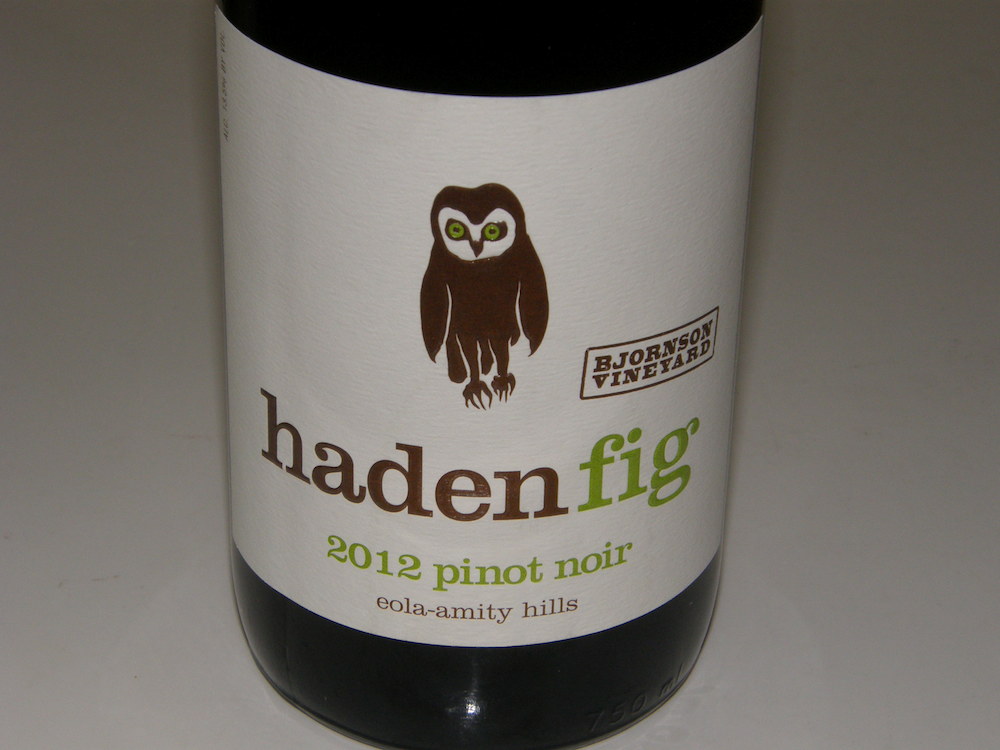 2012 Haden Fig Bjornson Vineyard Eola-Amity Hills Willamette Valley Pinot Noir 13.5% alc., 123 cases, $30. 5 favorite barrels. · Moderately dark reddish purple color in the glass. Interesting aromatics featuring scents of ripe cherry, fig (seems appropriate) and bourbon. Extra-delicious core of black cherry and black raspberry fruit, nicely spiced with an additional peppery note. Admirable harmony, and a long, memorable finish that makes the knees weak. This is a wine that tugs at your emotions and defies adequate description. One of the best values in Oregon Pinot Noir. Score: 94
2012 Harper Voit Strandline Willamette Valley Pinot Noir 14.2% alc., 405 cases, $35. Sourced from Antiquum, Bieze and Huntington Hill vineyards. · Moderately dark reddish purple hue in the glass. Alive with aromas even after an hour in the glass offering scents of black raspberry, plum, spice and vanilla. Intense and delicious on the palate, with a mouth filling attack of purple fruits with a hint of spice and cola. Finishes with length and bombastic fruit. Very forward and giving. Still aromatic the following day from a previously opened and re-corked bottle. Score: 93
2012 Harper Voit Huntington Hill Vineyard Willamette Valley Pinot Noir 14.3% alc., 46 cases, $55. Dijon clones 667 and 777. · Moderately dark reddish purple color in the glass. The nose opens nicely over time in the glass, offering an array of charming aromas including boysenberry, plum, chocolate, spice and vanilla. Refined and polished on the palate, blessed with a long and balanced palate of purple berries and spice. Rather seductive with good length on the satisfying finish. Still terrific the following day from a previously opened and re-corked bottle. Score: 92
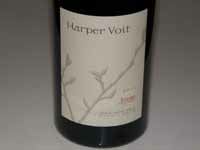 2012 Harper Voit Bieze Vineyard Eola-Amity Hills Willamette Valley Pinot Noir 14.1% alc., 46 cases, $55. Pommard clone and Calera selection on Nekia and Ritner soils · Dark reddish purple color in the glass. Love this nose which is alive the scent of boysenberry, black raspberry, violets, spice, and oak vanillin. Incredible sweet fruit presence in the mouth which carries over to an amazingly intense finish that offers a rainbow of purple fruits. The remarkable finish was still pumping the following day from a previously opened and re-corked bottle. My only nit is a slight sense of alcohol on the finish which keeps it from receiving a Pinot Geek award. Score: 92
2012 Harper Voit Antiquum Vineyard Willamette Valley Pinot Noir 14.3% alc., 46 cases, $55. Pommard, Dijon 777 and Wädenswil clones planted in Bellpine soil at a high elevation. Formerly Old School Vineyard. · Dark reddish purple color in the glass. A savory nose of interest with aromas of briar, Herbs de Provence, purple and black berries and a touch of herbal oak. This wine really stands out from the 2012 lineup due to its dried herb thread in the background. Mid weight purple fruits are clothed in modest tannins and the finish and long and generous. Score: 90
2013 Harper Voit Surlie Willamette Valley Pinot Blanc 13.6% alc., 300 cases, $20. Barrel fermented and aged sur lie. · Very light yellow color and clear in the glass. Fruity nose offering fresh aromas of pear, white peach and mango. A gregarious wine that is easy to like with intense Bartlett pear flavor and a touch of nectarine. Especially good chilled as an aperitif and a worthwhile followup to the excellent 2012 vintage of this wine. Score: 90
2012 Antiquum Farm Juel Willamette Valley Pinot Noir 14.3% alc., 225 cases, $37. A meticulously farmed vineyard with native cover crops at a high elevation with thin soils. Clones are Pommard, Wädenswil, 777, 667 and 115. Aged in 40% new French oak. · Very dark reddish purple color in the glass. The nose is shy and brooding, offering demure aromas of purple and black berry jam. The deep berry and plum flavor tends to be more generous over time in the glass. A noticeable thread of acidity runs through the background. The tannins are mildly aggressive but the mouth feel is still plush. There is amazing length on the finish which displays a touch of alcoholic heat. The most reserved wine among the 2012 Pinot Noirs crafted by Drew Voit. Score: 91
 2012 Antiquum Farm Passiflora Willamette Valley Pinot Noir 14.3% alc., 45 cases, $55. Aged in 60% new French oak. · Very dark reddish purple color in the glass. Nicely perfumed with scents of spiced marionberries, rose petal and vanillin oak. Deeply flavored with a full monty of blackberry and marionberry fruits that are beautifully offset by the generous oak treatment and fine-grain tannins. An engaging wine of uncommon presence that has a juicy cut of acidity in the background. This wine has all the components for a long life ahead. My only nit is the sense of alcoholic heat on the finish. Score: 93
2011 Lange Reserve Willamette Valley Pinot Noir 13.3% alc., $32, screwcap. 25th vintage (1987-2011). Winemakers Don and Jesse Lange choose the best barrels from premier vineyards. · Moderate reddish purple color in the glass. This wine is heavily shouldered with oak aromas and flavors. The mid weight core of dark cherry and berry fruits is compressed by rugged tannins. Not particularly appealing now, this wine may surprise in another year or two as many 2011 Willamette Valley Pinots have improved with time in bottle. Score: 87
2012 Maison L’Envoyé Two Messengers Willamette Valley Pinot Noir 13.6% alc., $36. Name translates as “House of the Envoy.” 100% de-stemmed, fermented whole berry, aged in 20% new French oak. · Moderately light reddish purple color in the glass. The juicy core of fresh black cherry, plum and cola flavors is overshadowed by a prominent oak sheen most evident on the nose. The tannins are balanced, the acidity is uplifting, and the wine tries to please. Score: 87
 2012 Maison L’Envoyé The Attaché Willamette Valley Pinot Noir 13.0% alc., $48. A barrel selection of grapes grown in volcanic and sedimentary soils. Aged in 40% new French oak barrels. · Shy aromas of black cherry, forest floor and seasoned oak. Welcoming fullness on the palate, with a bright, sappy cherry core complimented by a hint of cola and sweet oak. Juicy, with managed tannins and a big finish filled with black cherry goodness. Score: 89
2012 Meristem Meredith Mitchell Vineyard McMinnville Willamette Valley Pinot Noir 14.2% alc., $45. · Dark reddish purple color in the glass. Demure aromas of raspberry, spice and oak. Full-bodied, velvety flavors of blackberry and black raspberry that fill the mouth with sweetness and sappiness, ending with a flourish of chewy, very ripe opulence. Syrah in size and character. Score: 87
2011 Olenik Vineyards Estate Chehalem Mountains Willamette Valley Pinot Noir 13.5% alc., 75 cases, $45. From a 14.7-acre vineyard split off from the Jacob-Hart Vineyard in 2005. Winemaker Christopher Mazepink (Archery Summit). The vineyard is situated at 333 to 450 feet elevation and is a unique rocky site composed of fractured basalt covering Jory soils on the eastern side and purely sedimentary soils on the western side. Harvest Brix 24.2º-25.3º. A blend of Pommard, 777 and 115. 100% de-stemmed. · Moderately dark reddish purple color in the glass. Aromas of darker fruits, brown spice, iodine and green herbs. Mid weight flavors of plum, purple grapes and cassis with a green herbal vein in the background. Good fruit intensity with balanced dry tannins and respectable length on the finish. Unchanged the following day from a previously opened and re-corked bottle. Tasted twice. Score: 88
 2012 Olenik Vineyards Estate Chehalem Mountains Willamette Valley Pinot Noir 14.5% alc., 125 cases, $45. Harvest Brix 26.6º-27.4º. A blend of Pommard, 777 and 115 planted in 1999. · Dark reddish purple hue in the glass. Much riper fruit profile than the 2011 bottling with scents of black cherry, black raspberry and spice. Mid to full-bodied with a luscious core of sappy black raspberry and black cherry fruits that floods the palate. Appealing oak compliment in the background and a generous sweet fruit finish. A big boy wine that will appeal to fruit hedonists. A touch of heat surfaces in the background. Score: 89
 2012 Owen Roe Lenné Vineyard Yamhill-Carlton Willamette Valley Pinot Noir 14.1% alc., $44. Label depicts Muckross Abbey in County Kern, Ireland that was swept up in Owen Roe O’Neill’s battle for Irish freedom in the 1640s. · Moderately dark reddish purple color in the glass. Extroverted nose with a flourish of black raspberry, plum and spice aromas. Delicious essence of fresh black raspberry and blackberry with a touch of tea and cola. The velvety texture is captivating and fruit-filled finish pulls you back for more. Firm, but wellbalanced tannins suggest long term age ability. Well-crafted juice from one of Willamette Valley’s premier vineyards. Score: 93
2012 Owen Roe Merrimen Vineyard Wädenswil Block Yamhill-Carlton Willamette Valley Pinot Noir 14.1% alc., $44. Sourced from a 30-acre vineyard farmed by owner Mike Merriman. The label depicts the Abbey of Clonmacnois in Ireland. · Medium reddish purple hue in the glass. Perfumed with hi-tone aromas of black cherry and baking spices. Modest in weight but flavorful, offering a rainbow of redder fruits with accents of spice, mocha and vanilla. Soft, silky and very giving with welcome brightness and harmony. Score: 92
2011 Phelps Creek Vineyards “Regina” Columbia Gorge Pinot Noir 13.6% alc., 220 cases, $34. · Moderately light garnet color in the glass. Aromas of red cherry, beef and soy. Light to mid-weight flavors of red cherry and cranberry backed by lively acidity and suave tannins. Soft in the mouth and easy to drink, with good oak integration. Nothing to complain about, but nothing special. Score: 88
 2011 Phelps Creek Vineyards Crest Block Columbia Gorge Pinot Noir 13.8% alc., 80 cases, $N/A. This block is west of the winery on a windward slope absorbing the blunt of strong breezes leading to slight dehydration and thicker skin thickness bringing more concentration to the wine. · Moderately dark reddish purple color in the glass. Perfumed with fresh crushed red berries, oak and rose petals. Delicious mid weight essence of dark red berries with hints of cherry and pomegranate. Nicely integrated tannins, lively acidity and complimentary oak in the background. A thoroughly enjoyable wine that can be drunk now but has the goods to improve in the cellar. Score: 93
2012 Purple Hands Stoller Vineyard Dundee Hills Willamette Valley Pinot Noir 12.5% alc., 700 cases, $24. Clones are 777 and Wädenswil. · Moderately dark reddish purple color. Very shy upon opening, slowly revealing aromas of black raspberry, black plum and subtle oak. Middleweight flavors of dark stone and berry fruits backed by muscular fine-grain tannins and a modest oak sheen. Rather linear at this time with the fruit still compressed in tannins. Score: 88
 2012 Purple Hands Barbon Wahl Vineyard Chehalem Mountains Willamette Valley Pinot Noir 12.5% alc., 200 cases, $30. Pommard clone. · Demure aromas of dark berry jam, spice and balsam. Juicy and appealing, with a discreetly concentrated core of fresh, juicy dark red and black berries. The wine possesses an admirable attack and finish with balanced tannins. Score: 89
2012 Roots Fairsing Vineyard Yamhill-Carlton Willamette Valley Pinot Noir 13.7% alc., $40. · Moderately dark reddish purple color in the glass. Elevating aromas of dark red and black berry mash with a hint of oak charm. Needs time in the glass to flesh out, becoming livelier, and revealing a good mid palate attack of black cherry, dark berry and cassis flavors that are complimented by spice and anise-laced oak. Soft and seductive in the mouth with balanced tannins and a bright finish. Score: 90
2012 Roots Cancilla Vineyard Willamette Valley PInot Noir 14.0% alc., $40. · Moderate reddish purple color in the glass. Beguiling shy scents of black cherry, blackberry, black currant and plum. The dark cherry and berry fruits fill the mouth with overreaching intensity and finish with flashy aplomb. The substantial tannins are balanced by the concentrated fruit load. A vein of spice runs through for accent. Score: 90
2012 Roots Fairsing Vineyard Yamhill-Carlton Willamette Valley Chardonnay 13.3% alc., $35. · Moderately light golden yellow color and clear in the glass. Aromas of lemon cream, brown butter and roasted nuts. Slightly creamy and very smooth on the palate, with a core of lemon and golden apple flavors accented with toasty, nutty oak. Score: 90
 2012 Roots Saffron Fields Vineyard Yamhill-Carlton Willamette Valley Pinot Noir 14.0% alc., $40. · Moderately dark reddish purple color in the glass. A raft of blackberry, black raspberry and black cherry fruit fuels a very pleasurable nose and palate. Mid to full-bodied, with an attention-getting grainy mouth feel, and plenty of finishing goodness. Plenty of harmony and pleasure at work here. Score: 92
2012 Roots Roots Estate Vineyard Yamhill-Carlton Willamette Valley Pinot Noir 13.9% alc., $40. · Moderate reddish purple color in the glass. A cherry bombast with an explosion of fresh, fully ripened cherry goodness highlighting the nose and palate. Some elegance and modest tannins that keep the fruit in line. Assertive and showy, yet caressing in the mouth, with an intensely cherry-driven finish. You begged for more cherry and here it is. Score: 93
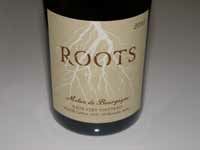 2013 Roots Deux Vert Vineyard Willamette Valley Melon de Bourgogne 12.8% alc., $22. Chris Berg crafts this wine from a wellknown vineyard in the Yamhill-Carlton district. · Very light yellow color and clear in the glass. Pleasingly aromatic with scents of baked peach and banana peel. Soft in the mouth and lightly flavored, featuring notes of lemon curd, golden apple and peach. Picks up power on the refreshing finish that is brightened by good acidity. A delicate wine that is uniquely Oregon in the USA. Score: 89
2012 Scott Paul Le Paulée Willamette Valley Pinot Noir 13.2% alc., $39, screwcap. Sourced from Maresh and Nysa vineyards in the Dundee Hills and Ribbon Ridge and Azana vineyards in the Chehalem Mountains. · Moderate reddish purple color in the glass. Flamboyant aromas of ripe black cherries, black raspberries, red grapes and spice lead to a rich and satisfying mid weight palate of dark cherry, dark berry and black plum flavors. The mouth feel is pure velvet and plush, and the finish is persistent. Plenty of sap in this vintage. Score: 91
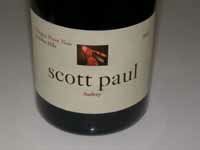 2012 Scott Paul Audrey Dundee Hills Willamette Valley Pinot Noir 13.5% alc., $83. Magnums too ($175). Sourced from special old vine blocks of Maresh Vineyard. · Moderately dark reddish purple color that glows in the glass. Spectacular aromas of raspberry, dark cherry and spice that pick up intensity over time in the glass. Mid to full-bodied core of juicy black cherry and black raspberry flavors that are vivid and uplifting. The finish is intense with flavors fanning out in unabashed generosity. This wine has that old vine nuance that emotes. Big and curvy in this vintage, this normally elegant bottling still retains some of that seductiveness. More restrained at this stage than the Le Paulée, but offers more upside long term. A wine to contemplate. Score: 94
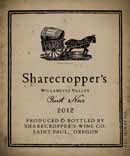 2012 Sharecropper’s Willamette Valley Pinot Noir 14.1% alc., $20. By Owen Roe. · Moderate reddish purple color in the glass. The pleasing aromas keep coming over time in the glass including black cherry, black raspberry and cardamom spice. Mid weight but full-flavored with a bevy of darker stone and berry fruits supported by ripe tannins. Very soft in the mouth and easily accessible with some finishing drive and opulence. One of Oregon’s greatest value-priced Pinot Noirs. Score: 91
2012 St. Innocent Villages Cuvée Willamette Valley Pinot Noir 14.2% alc., 1,621 cases, $23. The core of this wine comes from Vitae Springs Vineyard (56%), with contributions from Freedom Hill (6%), Zenith (28%) and Momtazi (10%). 2-day cold soak, fermented in stainless steel, aged 12 months in 14% new French oak, and bottled without fining. · The nose is pleasing with aromas of purple grapes, blackberries, cassis and oak. Mid to full-bodied frame of purple and black fruits. Forward and fruit-driven, with a well-matched backbone of suave tannins. A solid, everyday wine. Score: 88
2012 St. Innocent Temperance Hill Vineyard Eola-Amity Hills Willamette Valley Pinot Noir 13.5% alc., 1,045 cases, $35. This high altitude site is located ten miles northwest of Salem. Sourced from three blocks planted in 1984 (East Block), 1995 (Pump Home Block) and 2004 (“R” Block). Yield 1.4 tons per acre. 100% de-stemmed, fermented in stainless steel bins, aged in 23% new French oak for 16 months and bottled without fining. · Moderate reddish purple color in the glass. Significantly more aromatic and expressive the next day from a previously opened and re-corked bottle. Aromas of black cherries, dried herbs, and subtle oak. Crisp, bright and easy going with light to mid weight flavors of cherries and raspberries with some finishing power and length. The tannins are modest and the backing acidity is bright. Needs time to integrate the oak and become fully engaged. Decant if you must open now. Score: 91
2012 St. Innocent Shea Vineyard Yamhill-Carlton Willamette Valley Pinot Noir 14.0% alc., 630 cases, $50. Sourced from Block 6 (Pommard and 115) and Terrace Block (Pommard). Yield 1.6 tons per acre. 100% de-stemmed, fermented in oak fermenters. Aged 16 months in 20% new French oak and bottled without fining. · Moderate reddish purple hue in the glass. Tight upon opening and much better the following day from a previously opened and re-corked bottle. Aromas of dark berries, spice, flint and oak. Delicious Bing cherry and black raspberry core with complimentary oak in the background. Bright and full on the palate, with an impressive, cherry-licking finish. A keeper. Decant if you must drink now. Score: 93
 2013 Stoller Family Estate Dundee Hills Willamette Valley Chardonnay 12.5% alc., pH 3.23, TA 0.69, 2,100 cases, $20, screwcap. · Pale golden yellow color in the glass. Nicely appointed with aromas of lemon zest and peach and delicious flavors of yellow peach, citrus and vanilla wafer. Slightly creamy on the palate with bright acidity and a refreshing, persistent lemon drop finish. One of the better Oregon Chardonnays I have tasted lately. Score: 91
2012 The Eyrie Vineyards Willamette Valley Pinot Noir 13.5% alc., $30. Aged 12 months in French oak barrels. Unfiltered. · Moderate reddish purple color in the glass. This relatively lean wine is true to the Eyrie style. Aromas of cherry, raspberry and herbs are echoed on the fresh and delicate palate. Modest tannins, complimentary oak, and an impressively long finish with aromatic goodness lasting over half a minute. Score: 90
2010 Thomas Dundee Hills Willamette Valley Pinot Noir 13.1% alc., $95 (secondary market). · Light garnet color in the glass. Unusual nose offering scents of cherry skin, stem and humus. Light red cherry fruit at the core with a hint of raspberry. Decent attack and persistence with soft tannins and very bright acidity. A stemmy note pervades the background. Light, even a bit austere, but with a pleasing acid-driven cherry-fueled finish. Better the following day from a previously opened and re-corked bottle, with more spice and sandalwood on the nose, but still austere fruit with dominant tannins and acidity. Score: 87
 2011 Thomas Dundee Hills Willamette Valley Pinot Noir 13.2% alc., $80 (secondary market). A cult wine with no winery website, very small estate production allocated to a mailing list. Very difficult to track down access to mailing list. Often sold at 2 to 3 times release price on secondary market. · Moderately light reddish purple color in the glass. Shy, but appealing aromas of cherry, raspberry, spice and oak all in harmony. More intensity and sparkle than the 2010 bottling, with vivid cherry, raspberry, and spice and a flowery note in the background. Notable dry tannins should resolve over time. Plenty of cherry and spice on the soprano finish. Tasted the following day from a previously opened and re-corked bottle, the wine had become more expressive and interesting with more spice, fruit brightness, and softer tannins. Very age worthy. Score: 92
2012 Walter Scott Clos Des Oiseaux Eola-Amity Hills Willamette Valley Pinot Noir 13.6% alc., 300 cases, $40. Released March 2014. Vineyard owned by Marek and Maureen Waligora. 2.8-acres farmed by Sterling Fox. Clones co-fermented with native yeasts and aged 15 months in 40% new French oak. · Moderately dark reddish purple color in the glass. The nose never comes alive in the glass over considerable time. Shy aromas of cassis, black plum and blackberry with an echo of oak. Mid weight, straight forward array of black cherry, black raspberry and blackberry fruits with a modest oak sheen. Smoothly textured, with plenty of dry tannins on the finish. Could benefit from more time in the cellar. Score: 87
2011 Winter’s Hill Estate Dundee Hills Willamette Valley Pinot Noir 13.0% alc., $34. Grapes exclusively from the winery’s Dundee Hills Estate Vineyard. Jory soils at 525-730 feet elevation. Certified Sustainable and Salmon Safe since 1999. 100% de-stemmed, 1-day cold soak before yeast inoculation. Aged 24 months in 20% new French oak barrels. Estate bottled. · Light garnet color in the glass. Initially the bright aromas of cherry, strawberry, spice and sandalwood are appealing, but they fade over time in the glass. The flavors echo the aroma profile in a light, elegantly styled wine. More flavorful than one would expect from the color with some green herbs (a sign of unripe fruit) showing up in the background. Some slightly astringent tannins show up on the tart cherry finish. Score: 87
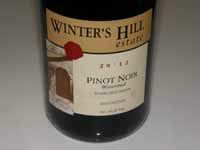 2012 Winter’s Hill Estate Watershed Dundee Hills Willamette Valley Pinot Noir 14.0% alc., $25. Stemmed grapes cold soaked for 3 days before yeast inoculation. Aged 14 months in French oak barrels. · Moderately light reddish purple color in the glass. Lovely earth-bound aromas of fresh cherries. Very tasty and uplifting, with broad mid weight flavors of fresh cherries and a touch of spice and savory herbs. The cherry fruit really sparkles. Forward and easy to drink, with a silky mouth feel, modest tannins, and a complimentary riff of oak and citrus on the refreshing, cherry-driven finish. A delightful cherry bombast. Score: 91
2012 Winter's Hill Estate Single Block Series Block 4 Dundee Hills Willamette Valley Pinot Noir 14.0% alc., 95 cases, $44. Part of the original 1990 planting in a cooler area of the vineyard that is the last block of Pinot Noir to be harvested. Own-rooted Pommard clone. · Moderately dark reddish purple color in the glass. Highly aromatic, with scents of boysenberry, plum, cherry, spice and woodshed. Mid weight parade of luscious dark red and purple fruits backed by silky tannins. Impressive attack and finish with flattering oak in the background. Score: 91
2012 Winter's Hill Estate Single Block Series Block 9-114 Dundee Hills Willamette Valley Pinot Noir 14.0% alc., 97 cases, $44. Dijon clone 114. Inaugural vintage of 100% clone 114 Pinot Noir. · Moderately dark reddish purple hue in the glass. Black cherry and oak spice aromas lead to a mid to full-bodied array of black cherry and black raspberry fruits. Intense attack, luscious mid palate, and a generous finish that lasts and lasts. A full mouthful of Pinot from a rarely met with monoclonal 114 bottling. Score: 92
2012 Winter's Hill Estate Single Block Series Block 9-115 Dundee Hills Willamette Valley Pinot Noir 14.0% alc., 72 cases, $44. Dijon clone 115. · Moderate reddish purple color in the glass. Large scale aromas of black cherry, brioche, wooded forest and chocolate donut. Plenty of black cherry and raspberry fruit presence in the mouth with supple tannins and good finishing crispness. Not as sappy as the clone 114 bottling, but very satisfying with especially noteworthy balance. Score: 92
 2012 Winter's Hill Estate Single Block Series Block 10 Dundee Hills Willamette Valley Pinot Noir 14.0% alc., 72 cases, $44. Highest elevation block on the estate between 625 and 700 feet. Pommard clone. · Moderate reddish purple color in the glass. Very exotic nose with dancing aromas of spiced berries and plum and hints of incense. Perfect balance of well-ripened black cherry, black berry and plum fruits, spirited acidity and refined tannins. Very polished and broad in the mouth with an aristocratic feel. Score: 93
Pinot BriefsNew Winemaker at Marcassin Winery Ryan O’Donnell joined Marcassin Winery as the new winemaker this spring. O’Donnell comes from Kosta Browne Winery where he was the associate winemaker, and before that, the associate winemaker at Paul Hobbs Winery. Staff Changes at Archery Summit M. Eleni Papadakis is the new assistant winemaker and Tim Scott is the new vineyard manager. Last year the winery, which is owned by Crimson Wine Group, hired Chris Mazepink as the new general manager and winemaker following the departure of long time winemaker Anna Matzinger. Papadakis was the winemaker at Domaine Serene from 2008 to 2011. Scott was formerly the vineyard manager for Domaine Drouhin Oregon and switched places with the former vineyard manager, Leigh Bartholomew, who is now the vineyard manager at Domaine Drouhin Oregon. Carlton Crush The Carlton Business Association (CBA) has announced that the registration process is open for all competitions at the upcoming 2014 Carlton Crush Harvest Festival. Registration forms for the Grape Stomp, Barrel Rolling Race, and Wine Thief Relay competitions are all available on the event’s website at www.CarltonCrush.com. The Carlton Crush Harvest Festival will be held on Saturday, September 13, 2014, celebrating the unique culture of Carlton and Yamhill County. Live music and entertainment, a vintage Thunderbird Car Display, festival food and drink, midway games for kids, an Artist’s Market, helicopter rides, and exciting competitions.
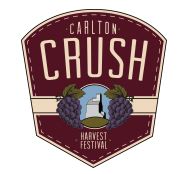 Top Ten Pinot Noirs The drinks business.com Global Pinot Noir Masters had 300 entries from 16 countries judged blind by an expert panel featuring eight Masters of Wine and one Master Sommelier. The results: (10) NV Champagne Soutiran Cuvée Perle Noire Grand Cru, (9) 2013 Viña Maycas del Limarí Pinot Noir Reserve (Chile who dominated the medals at the lower end of the Pinot price spectrum), (8) 2012 Hope Family Wines Liberty School Central Coast Pinot Noir, (7) 2011 Schug Carneros Estate Winery Pinot Noir, (6) 2010 Stoller Family Estate Reserve Dundee Hills Willamette Valley Pinot Noir, (5) 2010 Bomb Wines Willamette Valley Pinot Noir (unreleased), (4) 2012 Circe Vineyards Hillcrest Road Mornington Peninsula Victoria Australia, (3) 2011 Craggy Range Vineyards “Aroha” Te Muna Road Vineyard New Zealand Pinot Noir, (2) 2011 Jackson Family Wines Wild Ridge Sonoma Coast Pinot Noir, and (1) 2010 Viña Cono Sur Ocio Chile Pinot Noir. Leading German Pinot Noir Producer Dies Bernhard Huber was one of the first in Germany to stop selling wine to local cooperatives and produce wine instead under his own name. He also led the charge to plant Pinot Noir in Germany between 1980 and 2012. His estate was located in Malterdingen in Baden. Huber was often referred to as the godfather of German Pinot Noir and some of his single-vineyard Pinot Noirs equaled or surpassed famous grand crus from Burgundy. Corks Still the Preferred Closure Wine Business Monthly (June 2014) reported that natural corks remain the most common type of wine closure by a large margin. The number of wineries using natural corks have been about the same as 10 years ago, with 8 out of 10 wineries (78 percent) reporting that they use natural cork. Among Pinot Noir producers in California and Oregon, the overwhelming preference is for natural corks although there are a number of prominent producers committed to screwcaps. Santa Barbara County Viticulture Maps Santa Barbara Vintners announced the release of six new Santa Barbara County viticulture maps. The detailed maps outline the AVA borders and indicate where each vineyard is located. The Santa Barbara County map shows the county as a whole, while the more specialized AVA maps show the vineyards in more detail. Each map retails for $20 plus tax and shipping and handling. Discounts for trade and multiple map purchases. Visit www.sbccountywines.com to buy.
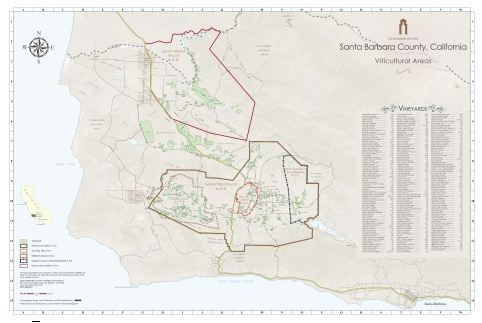 Russian River Valley Winegrowers Look at Diversity in AVA Winemakers at the recent Russian River Valley Pinot Classic discussed splitting the appellation into “neighborhoods.” They chose to split the Russian River Valley into three neighborhoods for the discussion: the Middle Reach, Laguna Ridge and Green Valley. The Santa Rosa Plain and Sebastopol Hills are also being discussed. Today, the Russian River Valley AVA is huge at 169,029 total acres with about 16,000 acres planted to wine grapes. There is said to be more soil types than in Burgundy and there are marked climatic differences between the northern and southern neighborhoods, so it has hard to characterize the AVA as a whole. A special committee has been organized and led by Clay Gantz, a winegrower and member of the Russian River Valley Winegrowers Board, to attempt to define each neighborhood.
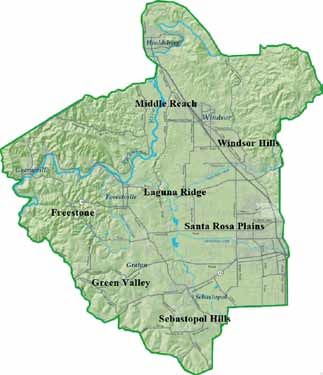 Underwood Oregon Pinot Noir & Pinot Gris in a Can Oregon wine producer Union Wine Company, owned by Ryan Harms, has launched Underwood Pinot Noir and Pinot Gris in 375-milliliter cans (two glasses or about a half bottle of wine) with a canned Rosé planed for early 2015. The wines are the first non carbonated wines to be bottled in a can. The exact wines are also available in bottles. The allure is that wine in cans is unpretentious (“pinkies down”) and practical as a can is very portable and readily disposable. They are lighter than bottles, easy to transport, unbreakable and reduce the environmental footprint because they are 100% recyclable. Apparently when the wine is poured into a glass, it tastes identical to the same wine poured from a bottle. Since the can is lined, there is no metallic flavor. A four-pack of Pinot Noir is $24.00. The 2013 Underwood Pinot Noir is sourced from the Umpqua Valley (60%) and the Willamette Valley (40%). Aged 6 months in 15% new French oak barrels with a finished alcohol of 13.0% and residual sugar of less than 0.2%. The 2013 wine was released in April 2013. There is distribution in many states and it can be bought online at www.unionwinecompany.com. Union Wine Company, operating out of Sherwood, Oregon, has a Tasting Truck which is used for events and will serve as a mobile tasting room in Portland. Union Wine Co. recently purchased historic Amity Vineyards.
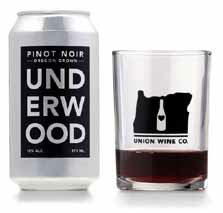 Scratchpad Sports Interactive Wine Label Terravant Wine Company in Buellton has released three wines from California’s Central Coast (2011 Pinot Noir - $15,, 2011 Chardonnay - $13, and 2012 Sauvignon Blanc - $11)) that have nearly blank labels that encourage drinkers to draw and write on the front label, take a photo, and share via social media including the Scratchpad Facebook page and Instagram. The Scratchpad wines come with a charcoal pencil hung on the neck that says, “Doodle, Post, Sip.” The wines are in wide distribution. Winemaker Chris Whitcraft Dies Years ago when I had a burgeoning interest in Pinot Noir, I became interested in Whitcraft’s quirky newsletters and his Pinot Noirs. He began the Whitcraft label in Santa Barbara in 1976 and was one of the first wineries within the city limits. Whitcraft started with sparkling wine and Chardonnay, unhappy with his early attempts at Pinot Noir because of the way grapes were grown at the time. He started making Pinot Noir in earnest in 1985. His wines were sometimes a bit off the beaten track but were always interesting. Legend has it that he lived in a camper during harvest behind the Hitching Post II restaurant and spent a number of evenings in the bar drinking wine with Frank Ostini. He talked to Rex Pickett, the author of ‘Sideways,’ on a number of occasions. He also was friends with Burt Williams of Williams Selyem fame and made wine from Williams’ Morning Dew Ranch in Anderson Valley. Whitcraft had his own daily radio show called “The Wine show” from 1978 to 1989. Most recently, his son Drake had assisted in the winemaking at the winery’s industrial building in downtown Santa Barbara. New Location for Soléna Estate The winery’s tasting room is now located 500 feet from the old one (it was sold to Kendall-Jackson) at 17096 NE Woodland Loop Road in Yamhill. ¡Salud! Has New Vision for Oregon Pinot Noir Auction. This year’s November 14-15 weekend auction will now be held entirely in the Willamette Valley due to a partnership with The Allison Inn & Spa in Newberg. The Allison is hosting the Saturday events and closing its doors to the general public so that only ¡Salud! guests can stay at the Inn November 14-15. There are a limited number of weekend packages for sale, which include two nights deluxe lodging, transportation and two tickets to the ¡Salud! Cuvée Tasting & Auction at Domaine Drouhin Oregon, and two tickets to the Dinner and Auction Gala, plus breakfast Saturday morning. The price of the weekend package starts at $1,500 a couple. Call The Allison Inn & Spa at 877-294-2525. Tickets to the ¡Salud! Friday and Saturday events are available online at www.tualityhealth.ejoinme.org/salud2014. ¡Salud! is a cause that I have supported for many years. It is a unique collaboration between Oregon winemakers and healthcare professionals to provide access to healthcare services for Oregon’s seasonal vineyard workers and their families.
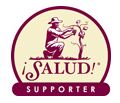 Linfield College Survey Trumpets Oregon Wine A 2014 Linfield College consumer survey looked at attitudes toward Oregon versus California wines and wineries among 1,020 consumers. In seven categories, Oregon trumped California: Hand crafted artisan wines, Organic or sustainably made, Small family farms, Community/collaboration, Value for Price, Uniqueness and Quirkiness/independence. California scored higher than Oregon in four categories: Mass produced wine, Tradition, Expensive wines, and Easy to find when I buy wine. Jean Yates, former owner of Avalon Wine in Corvallis, said about this survey: “Oregon winery owners spend time and money to promote their wines, marketing their visions, their goals, and the fruits of their labors. Some wineries emphasize history, others a philosophy of life. The focus might be environmental, local food production, or social. Each winery wants to stand out and be identified for their own unique brand and style. Oregon wine, as a statewide industry, needs a definition. The Linfield study is important to all Oregon wineries, and to the industry overall.” Hanzell Winemaker Icon Bob Sessions Dies at Age 82 There have been a number of tributes written about Bob Sessions who was revered winemaker at Hanzell Vineyards in Sonoma Valley for more than 41 years. He had succumbed to a long battle with Alzheimer’s disease. Warren Winiarski, the father of Stag’s Leap Wine Cellars, said, “I was a long time admirer of Bob’s wines and asked him many years ago during a job transition for him to join us at Stag’s Leap Wine Cellars. His presence and contributions at the winery were a model to judge whether we were accomplishing our goals for excellence.” He first assumed the role of Winemaker and General Manager of Hanzell Vineyards in 1973, and always took to heart the dreams and visions of its founder, Ambassador James D. Zellerbach, in producing wines that equalled the best in the world. He produced Chardonnays and Pinot Noirs that were equal to the greatest wines in the world. His wines could be cellared for decades on a path parallel with Grand Cru Burgundy. Very few winemakers in the world have left such an amazing legacy of quality and longevity. In 2002, Sessions retired and assumed the role of Winemaker Emeritus, passing on his knowledge and experience to the winemakers that followed, including current Winemaker Michael McNeill, only the fifth winemaker in the history of the estate. Artesa Abandons Vineyard Plans Near Annapolis As reported in The Press Democrat (June 3, 2014), Artesa Vineyards and Winery plans to sell their 324-acre property for $1.5 million after last year environmentalists persuaded a Sonoma County judge to rule that the vineyard’s environmental studies were flawed. Artesa claims it has refocused their growth strategy on the Napa Valley rather than the Sonoma Coast. West of West Festival in Sebastopol The annual West of West Festival, sponsored by the West Sonoma Coast Vintners (WSCV) will be held at The Barlow in Sebastopol, California on August 1-3. The event kicks off with nine intimate winemaker dinners on August 1. On August 2, the morning Seminar will feature “The Evolution of California Cuisine and Wine,” and the afternoon Seminar will focus on “Charles Heintz Vineyard Chardonnay.” The Grand Tasting will follow on Saturday and then a dinner featuring the talent behind San Francisco’s three hottest restaurants (Statebird Provisions, Rich Table and Bar Tartine). The Grand Tasting will be repeated in the afternoon on August 3. Tickets and information are at www.westsonomacoast.com.
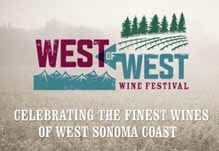 Erin Miller New Winemaker at Twomey Cellars The Duncan family announced the appointment of Erin Miller as Pinot Noir Winemaker for Twomey. She will report to longtime Silver Oak and Twomey Director of Winemaking Daniel Baron, but will be responsible for managing wine production from grape to bottle. Erin earned an MS from University of California at Davis. Most recently she was with Provingage Wine Associates, working for Evening Land Vineyards as California Winemaker and Oregon Assistant Winemaker and managing four boutique wineries. Previously she worked for Hartford Family Winey and Kendall-Jackson’s Vinwood Cellars.
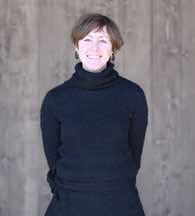 Gran Moraine Pinot Noir Released Jackson Family Wines is now California’s largest landowner in Oregon following the 2013 purchase of the 220-acre vineyard and site of the former Soléna Estate Winery in the Yamhill-Carlton District. The Gran Moraine Vineyard, part of the purchase, is the source of the newly launched Gran Moraine Pinot Noir. Grapes from this vineyard also go into the La Crema Willamette Valley Pinot Noir first released this year. 12th Annual Mendocino Ridge & Yorkville Highlands Wine Festival This event will be held on Saturday, August 2, 2014, at Meyer Family Cellars on Highway 128 between Cloverdale and Boonville. Over 60 local wines will be offered along with a grape stomp, highlands games, barbecue, and rare bottle silent auction. For information and tickets, visit www.yorkvillehighlands.org.
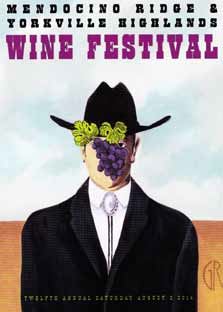 In Pursuit of Balance 2015 Four new wineries, Big Basin Vineyards, Lutum Wines, Mindego Ridge and Wenzlau Vineyard have joined the 29 returning IPOB wineries. The 2015 events are in New York February 23, San Francisco March 16, Houston March 30 and Japan the week of April 13. IPOB tasting committee, members are Ian Becker, Jon Bonner, Christie Dufault, Ehren Jordan, Rajat Parr and Wolfgang Weber. Visit the website at www.inpursuitofbalance.com. Wally’s Central Coast Wine & Food Celebration Taste nearly 150 of the Central Coast’s finest wines and savor signature dishes provided by renowned restaurants like The Hitching Post’s legendary Santa Maria BBQ, Full of Life Flatbread, and favorite Los Angeles restaurants Republique and WP24. Sunday, July 27, 2014, 1:00-4:00. The event benefits the Michael Bonaccorsi Scholarship Fund at Allan Hancock College Department of Viticulture and Enology, whose alumni are the backbone of the Central Coast wine industry. Participating wineries include Alma Rosa, Brewer-Clifton, Fiddlehead Cellars, Foxen, Hilliard Bruce, Melville, Mount Eden Vineyards, Paul Lato, Talbott, and Talley. Tickets are $99 at www.wallywine.com.
 Santa Rita Hills Wine & Fire 2014 The Sta. Rita Hills Winegrowers Alliance presents their annual Wine and Fire event, a three day adventure exploring the Sta. Rita Hills AVA. Kick Off Barn Party at Sanford Winery’s Sanford and Benedict Barn on August 15 featuring fire-grilled pizzas, music and plenty of Pinot Noir. The Wine and Fire Seminar, The Dirty Truth, will be the following day at Fiddlestix Vineyard where winemakers and sommeliers team up to challenge the senses in a blind tasting of Sta. Rita Hills wines. The morning seminar will be led by Josh Raynolds of Stephen Tanzer’s International Wine Cellar, and features Jeff Newton of Central Coast Vineyard Care who manages hundreds of acres of vineyards in Santa Barbara County. A Hitching Post II catered lunch will follow. Saturday night, August 16, will be the Grand Tasting at La Purisma Mission with local food purveyors and wines from all producers in the Sta. Rita Hills AVA. On Sunday, August 17, members of the Sta. Rita Hills Winegrowers Alliance will hold special open houses. For further information and tickets, visit www.staritahills.com. Urban Winery in Los Angeles Urban wineries are commonplace in Portland, Oregon, New York, New York, and San Francisco, California, but now Abe Schoener, of Scholium Project, plans to seek funding to build a $2 million winery in the Central Avenue district of Los Angeles. Schoener told Decanter.com that he plans to source grapes from the hills east and north of San Diego, the Santa Monica Mountains, and Rancho Cucamonga. He also plans to plant vineyards adjacent the Los Angeles River in central Los Angeles. Currently, Scholium Project releases about 3,000 cases of wine annually from grapes sourced in the Lodi, Napa Valley and Sonoma Coast. Petaluma Gap Applies for AVA Status The Petaluma Gap region, which extends from the San Francisco Bay to the Pacific coast and is currently part of the huge Sonoma Coast AVA, has applied for its own AVA status. The name, Petaluma Gap, is derived from the 15-mile opening in the coastal California hills that allows cool maritime air to enter Sonoma County. It is a distinct winegrowing region, quite different from the western Sonoma Coast and deserving of its own AVA designation. The Wine Dudes Blog Along with fellow wine writer, Eric Anderson (Grape Nutz), I write the Wine Dudes Blog at www.orangecoastmagazine.com. There are two posts a week and a Must-Try Wine of the week. I frequently post on Pinot Noir, but also include recommendations for other varietals. I also post reviews of Orange County restaurant wine programs. Check it out for a quick, interesting read.
Willamette Valley EpilogueOregonians appear quirky to most Californians, but therein lies their charm. Everyone respects the speed limit, even on freeways, they drive American cars, polite attendants pump your gas, and there is no disdain for old, used and weathered items including cars, Coming from Orange County, California, where everyone is into image and possessing “things,” I find the change when I hit the roads in the Willamette Valley very refreshing. It makes little sense to drive an expensive car in the Valley as many roads are either unpaved or paved with tire-ripping gravel. This rural, serene, agricultural region with miles and miles of rolling hills and valleys planted with wine grapes, grain, grasses and hazelnut trees, causes your heart rate to slow. Laid back towns dot the landscape, and some seem frozen in time since the 1950s. People are cordial, greet you nicely at stores, restaurants and wineries, and seem genuinely interested in what you have to say. Small, independent business are still plentiful in the Valley, although chains and franchises are creeping in. Street signs are challenging with practically every street preceded by a direction such as “SE,” or “NW.” It is easy to get lost because streets have no sensible pattern in many areas such as the Chehalem Mountains where I become easily disoriented. A GPS may or may not be your best friend. When visiting a winery in Dallas, I met with an actual ferry that transported cars, a few at a time, across the Willamette River. It seems that it would be reasonable to build a short bridge instead, but then, this is Oregon farm country. Except for the summertime when it can be quite warm, it rains almost daily in the Willamette Valley. This deters visitors and challenges businesses and wineries to remain open and turn a profit in the winter months. Primarily because of this incessant wetness, residents rarely dress up. The artisan Oregon wines are far from quirky. They are genuine, often sustainably produced, hand crafted in small lots, and frequently offer good value for the price. The camaraderie among winemakers and winery owners is real and pervasive. There are many exciting developments in Pinot Noir winemaking going on including more whole cluster vinification, amphora vinification, and consistent quality despite the vagaries of vintages. Prices for premium Oregon Pinot Noir are slowly escalating, but the quality justifies the rising tide. Premium Oregon vineyard land is still affordable compared to California, and many outsiders, both from our country and Burgundy, are jumping in. Oregon wine people love to talk about soils and the AVAs of the Willamette Valley are largely characterized by their soils. There are two main types mentioned frequently: (1) red volcanic basalt soils known as Jory from 13 million-year-old lava flows, and (2) brown marine sedimentary soils known as Willakenzie laid down under the ocean flow 20 million years ago. Generalizations can be made regarding flavor and style of Pinot Noir for the AVAs based on the differences in soil type. The AVAs with predominantly Jory soils, like the Dundee Hills, Eola-Amity Hills, and parts of the Chehalem Mountains and McMinnville, tend to produce Pinot Noirs with bright red fruits including cherry and raspberry, and are softly textured with modest tannins. The Pinot Noirs from AVAs with Willakenzie soils like Yamhill-Carlton, Ribbon Ridge, and parts of the Chehalem Mountains and McMinnville, typically offer darker fruit, spice (cola, anise), and wet leaf flavors, and tend to be more tannic and structured. The best way to get a feel for the different AVAs of the Willamette Valley is to visit and taste. All the AVAs are contiguous, and easily explored by car over the course of a few days. The last frontier to conquer for the Willamette Valley wineries is the presentation of food pairings on site. The Pacific Northwest has a tremendous bounty of gastronomic riches that pair well with Pinot Noir, including wild mushrooms, salmon, shellfish, cheeses, charcuterie, bacon and hams, and hazelnuts. It is only a matter of time until more Willamette Valley wineries will follow the lead of California and offer food pairings at tasting rooms to enhance the enjoyment of the tasting experience. To read more about the Willamette Valley vintners, I recommend the book, Winemakers of the Willamette Valley: Pioneering Vintners from Oregon’s Wine Country (Vivian Perry and John Vincent, paperback, 2013). The book begins with a short history of the Willamette Valley wine region and then profiles 19 prominent winemakers, most of whom did not set out on a life path to be an Oregon vintner. Familiar names are included such as Isabelle Dutarte (De Ponte Cellars), Harry and Wyne Peterson-Nedry (Chehalem), Lynn Penner-Ash (Penner-Ash), Luisa Ponzi (Ponzi Vineyards), Kelley Fox (Scott Paul), and a memoriam to respected winemaker Forrest Glenn Klaffke. The three-page foreword written by Harry Peterson-Nedry is worth the price of the book alone. He emphasizes the changing landscape of the Willamette Valley wine experience with the only constant being the passion of the people involved. |